Flight 714 to Sydney… um… Bangkok
This is the first ‘edge’ of the ‘Hexagon’, my journey through six airports — three each in Southeast Asia and southern India — for the Christmas 2022/New Year 2023 break. The objective was to fly Vistara and AirAsia India for the first time, as these two airlines of the Indian multinational conglomerate Tata Group have a far better onboard product than the ones they are disappearing into: Air India and Air India Express, respectively. The journey to Chennai would be on Singapore Airlines’ regional A350 and Thai Airways’ 787-9, as I had flown neither aicraft type before: I’d flown SQ’s longhaul A350 two months prior (a very special one at that, one in 10,000!) but not the regional configuration with Thales’ superior IFE, and the 787-8 and 787-10 but not the 787-9. Then came two lovely A320 flights on the Tata Group carriers: first an afternoon flight from Chennai to Bengaluru on the underrated AirAsia India, and then a late-evening leg to Hyderabad on Vistara (including a visit to the phenomenal 080 Lounge BLR) to cap off the year 2022, a record-setting one in terms of airline and aircraft diversity — though recently the ecletic quartet of SriLankan, Ethiopian, KLM and Garuda, covering all three alliances, will cement mid-2023 as one of the most memorable periods in my aviation history.
The return, the first flights of the new year, was much more mundane: two more A320 flights, this time on AirAsia Malaysia, first from Hyderabad to Kuala Lumpur (two cities with their airports located a long way south of the city centre, KUL being much further out as I found out last month) and then the final hop to Singapore as the year’s first working week started. (Later I did manage to fly Vistara again — on its A321neo to Mumbai, also having a special sticker — but I doubt I’ll be able to get a second chance on AirAsia India before its finale.) I plan to post these six reports from June to August/September 2023 before resuming more recent ones: a weekend trip to Kuala Lumpur in May that involved a ‘Star Alliance coincidence special’ on Ethiopian Airlines, followed by a ’36 hours in Bali’ jaunt at the start of June featuring a SkyTeam-liveried KLM 777-300ER and two A330-300s of alliance partner Garuda Indonesia that also had special stickers.
But before all that, let’s begin with Flight 714… to Bangkok, and not Sydney as the name of the Tintin book (a childhood favourite series of mine and my father’s) would suggest!
Is there an alternative to Delhi and Mumbai as global Indian hubs? Yes, says BLR
For this holiday, I would be spending the first three days (Christmas Eve, Christmas Day and Boxing Day) with my family in the coastal cultural city of Chennai; then move to the IT/tech hub of Bengaluru or Bangalore, our new home since May, for another three; and finally spend the New Year in Hyderabad, another metro which has been aggressively growing as a tech and trade hub — and much more sustainably at that, since it has little of Bengaluru’s notorious traffic and pollution. These three have historically been the largest cities of South India, with Chennai leading the way for much of the twentieth century, only to be toppled by Bangalore (as most people, including myself, refer to it) with the IT explosion in the new millennium. All along, the otherwise un-flashy, laidback Hyderabad has recently hit the jackpot in terms of entertainment, and its Telugu film industry or Tollywood (which shares its name with the Bengali film industry of Kolkata) has produced the maximum Indian blockbusters in postpandemic times, far eclipsing Bollywood — chief among them being RRR, whose Naatu Naatu song won an Oscar, and Pushpa: The Rise.
However, in terms of aviation capabilities, Kempegowda Airport (BLR) has left the other two far behind: despite Rajiv Gandhi International (HYD) also being a swanky private airport, it hasn’t really leveraged the swish facilities in terms of attracting international airlines, while the shoddy government-owned Chennai Airport (MAA) has a better range of international destinations but will forever be let down by poor upkeep and apathetic sarkari mismanagement. In terms of airlines from far-flung destinations, BLR enjoys the likes of KLM, Qantas, JAL and soon Virgin Atlantic at its doorstep — plus the Emirates A380 — while MAA at least has Air France and Ethiopian, but HYD has to make do with only British Airways, though Lufthansa will resume service there in 2024. As I’ve come to Bengaluru for a few days — also on SQ’s regional A350, like in this trip report — to visit my parents for the first time after their big shift from Chennai, I can only breathe a huge sigh of relief that I will no longer have to suffer the archaic ‘cattle shed’ that is MAA’s 1980s-era international arrival terminal, and from September 2023 all international flights at BLR will operate from T2, one of the most breathtaking in this part of the world.
Now I’ve come again to visit my parents in BLR for a few days around the Eid-ul-Adha holiday, called Hari Raya Haji in Singapore, at the end of June. This was also on an SQ A350 Regional — her name was SHE (okay, with a 9V- before it) — and, like with Flight 714, the catering was a swing and miss. Is SQ still as world-class as it portrays itself to be?
Enchainement de vols
- 1SQ714 | Singapore to Bangkok | 22 December 2022 | A350-900 | 9V-SHJ
- 2
- 3
- 4
- 5
- 6
The world’s most populous country — and the most explosive aviation market
Indian aviation: booming in some ways, shrinking in others
The middle of June 2023, also known as the week of the Paris Air Show, has been well and truly dominated by Indian carriers, and much has been made about IndiGo’s mammoth order of 500 A320neo-family aircraft — the largest in aviation history — with deliveries starting from the 2030s. It beat Air India’s record of 470 aircraft, announced only four months before, which has now also been finalised at this airshow. Not to mention, after dipping its toes in the world of widebodies — courtesy leased 777s from strategic partner Turkish Airlines, including a 531-seat monster called TC-LKD — 6E is separately preparing for its own widebody order, with the A330neo and 787 being frontrunners. (I personally would love to see an A330neo order, as the A330 in general hasn’t found much love in India, certainly not after Jet Airways’ collapse!) But all these gargantuan orders hide a dirty little secret. Thousands of aircraft in what is set to be the world’s largest aviation market, and yet only two companies (for the most part) to fly them, as all the others are ruthlessly squeezed out, as the recent bankruptcy of Go First is the starting sign of.
The harsh reality is that Indian aviation is effectively turning into a duopoly — Air India (Express) and IndiGo — but I have enough faith in the all-737-MAX startup Akasa Air to try and turn this into a three-horse race, as it is the only one capable of doing what Go First and SpiceJet couldn’t, and nor will the reincarnation-that-wasn’t of Jet Airways. Not least because Akasa is helmed by Vinay Dube, the same man who led 9W (Jet) in its final days. If any CEO other than Campbell Wilson (AI) or Pieter Elbers (6E) has any fire in his belly to shake up the Indian skies, it is him. But for every Akasa that launches in the country, some more players drop dead like flies, unable to survive in the wild jungle where IndiGo is the three-hundred-kg gorilla, a kilogram for every plane in its fleet. In a bit over a year’s time the number of airlines in Indian skies will have decreased by three, since Go First went belly-up in May 2023, with hopes of a restart quickly fading like they did for 9W, and the end of the AirAsia India and Vistara journeys — nearly a decade after their launch in 2014 — is drawing near.
Not to mention that Jet’s own planned relaunch has completely burst apart, with all the high and mighty claims of a hybrid service model gone for a toss, while SpiceJet has been on its last legs for goodness knows how long. (Ironically, as recently as March, 9W itself made lofty claims of its own big aircraft order at the Paris Air Show. With its CEO-designate Sanjiv Kapoor’s resignation putting paid to any chances of a restart, we all know what came of that!) And yet regional airlines like Star Air, Flybig Airlines and the state-owned Alliance Air continue to abound, with two more — Fly91 and Jettwings Airways (whose logo is way too similar to JetWings, 9W’s inflight magazine from years past) — slated for launch in the near future. Which is all the more reason I simply HAD to fly AirAsia India and Vistara before they ceased to exist, and experience for myself just how the Tatas had been running these loss-making but lovely airlines for nearly a decade. The ball is in Air India’s court as it turns to Futurebrand to refresh its brand identity and livery, and we should get a picture of that by November, when the rights to the AirAsia brand in India will expire, and its low-cost division will rebrand after merging with the all-737-800 Air India Express.
But before we get to that, we’ll see how Singapore Airlines — current stakeholder in Vistara, which will turn into a stake in Air India after Vistara is swallowed whole — is doing things on its favourite medium-haul workhorse. (One that you’ll no longer find on Bangkok, by the way, as all A350s on this route have given way to 787-10s — though anything is better than poor Phuket in another part in the country, which is stuck with pathetic 737-800s. No, not even the MAX with lie-flat seats, but the very worst aircraft SQ has to offer!) Spoiler alert: The catering on this flight was a major letdown, but the IFE system on the A350 Regional is far superior to that on any other SQ aircraft.
Pre-departure: ‘This is what you came for’
Thursday, 22 December. I had been reading about the unfortunate incident on an IndiGo flight from Istanbul where a cabin crew member completely lost it with a passenger. On the one hand the male passenger’s behaviour was completely unacceptable, especially towards a woman — which 100% of IndiGo’s cabin crew are — as he called her his ‘servant’. On the other, maybe there were better ways to deescalate the situation, instead of the cabin crew member reaching her breaking point. At least she stood up for herself, as against the ‘pee-gate’ scandal that unfolded along with the New Year, where the Air India cabin crew did not lift a finger. Anyway!
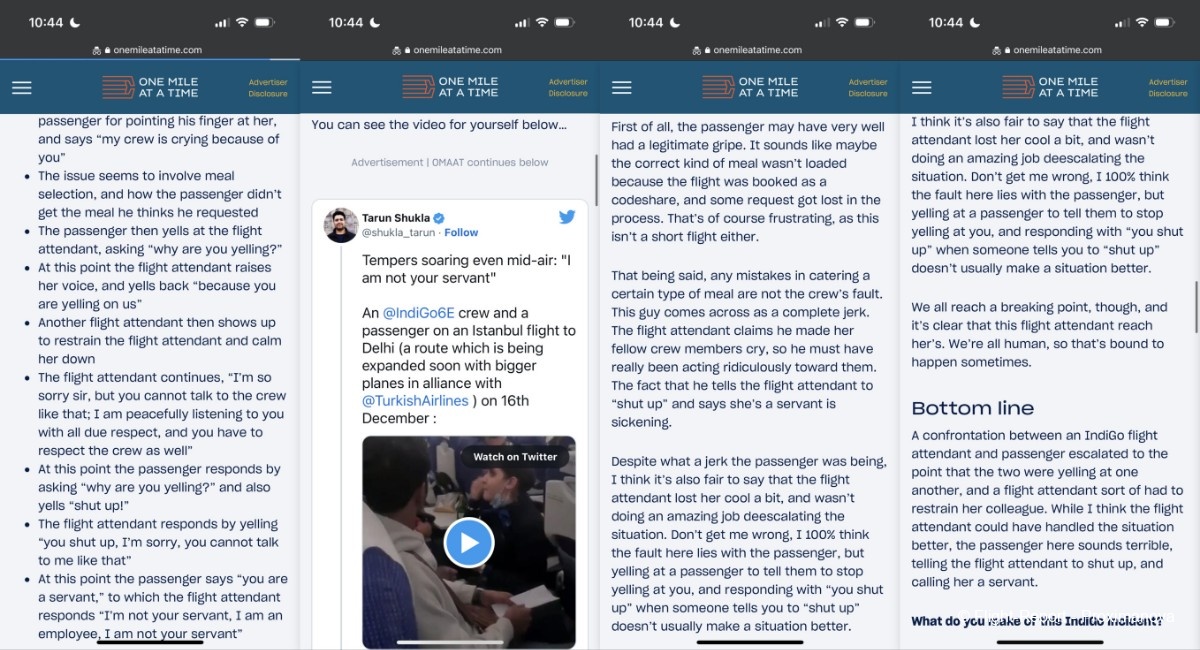
Well before the flight I had a glance at the menu for my flight, and truth be told I was far from impressed with the measly choices, a suspicion that was confirmed once on board.
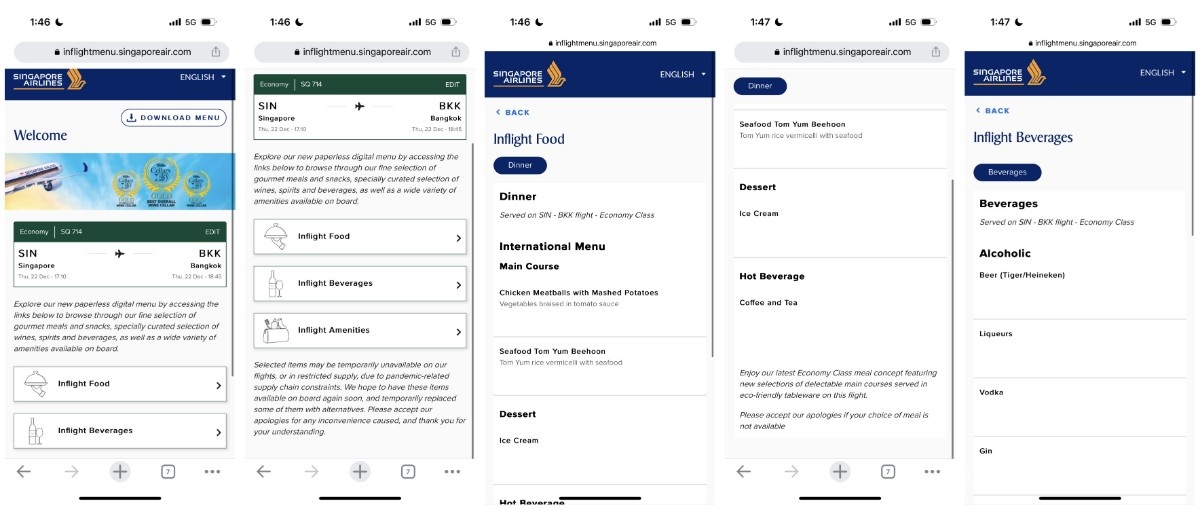
Soon enough I’d started out for the award-guzzling Changi Airport, with Rihanna’s This is What You Came For on the Gojek taxi radio. But it was quickly forgotten that day, as a much more rousing and riveting beat from Brazil had taken centrestage in my mind’s theatre, with its arch-rival having won the World Cup days before.
You will find quite a few mentions of We are One (Olé Olá) — the theme song of the 2014 FIFA World Cup in Brazil, starring Pitbull, Jennifer Lopez and Claudia Leitte — a number of times in this report, as no other song, not even Waka Waka, captures the spirit and joy of football for me, all the more reason since a Latin American team had won.
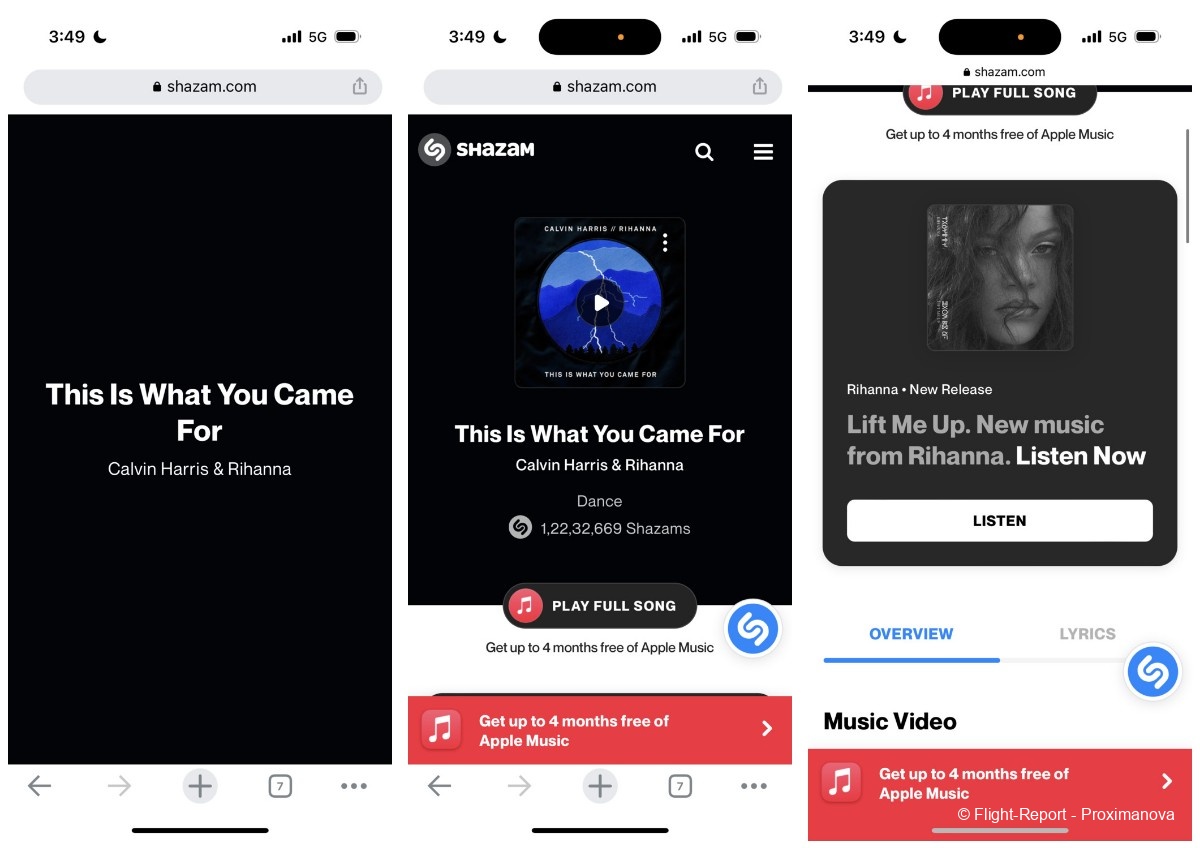
In fifteen minutes Changi’s clean, manicured lawns came into view.
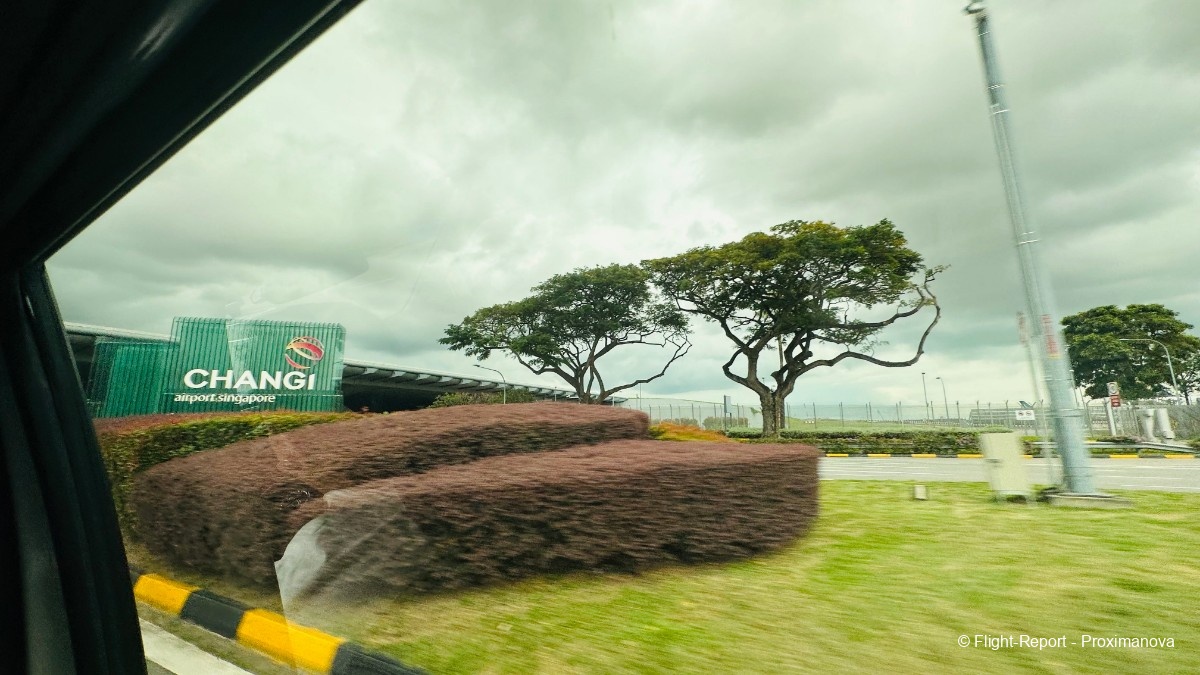
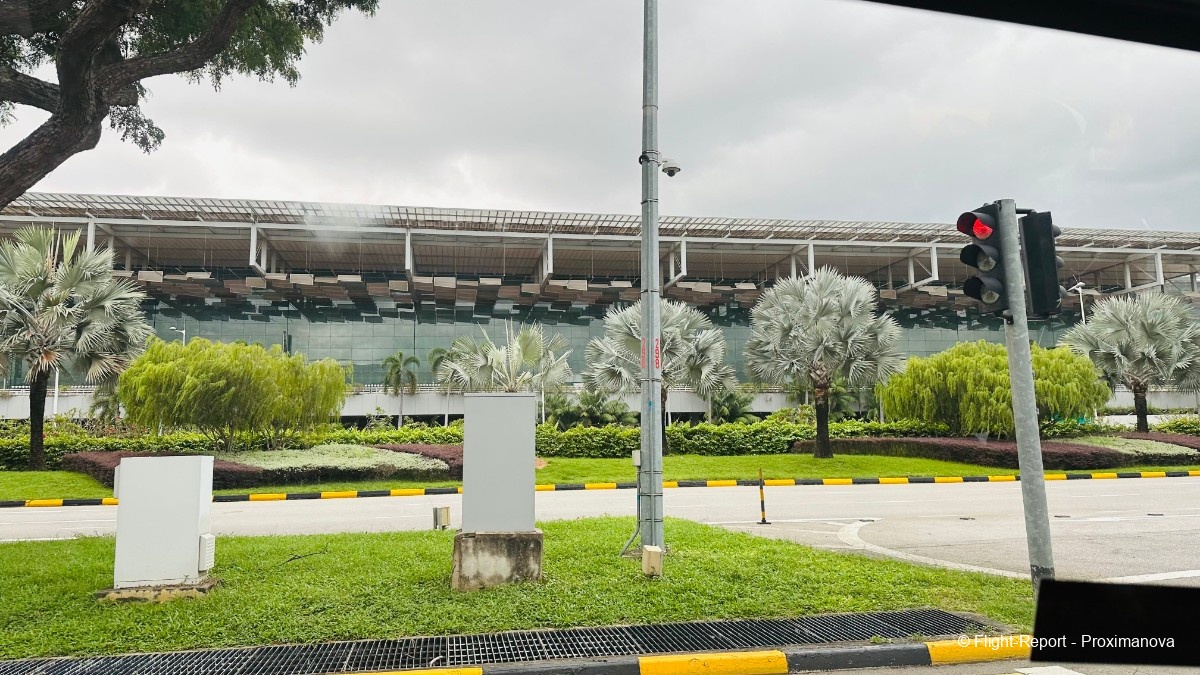
This being a Southeast Asian departure, it was once again from the renovated T2, a stunning marvel of architecture that only serves to demonstrate just how far Changi is ahead of the rest of the world — though the proud and haughty Doha Hamad is trying its darnedest to snatch the title for itself.
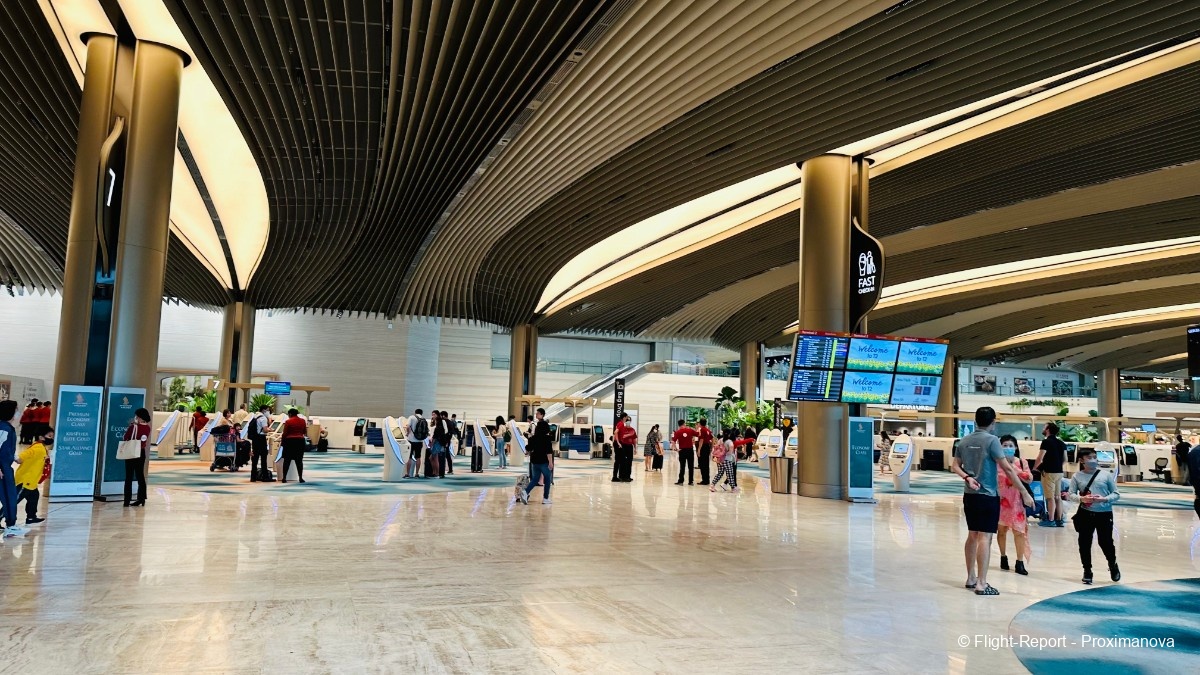
The automated counters at Changi Airport fortunately processed the baggage tags as they were supposed to, unlike on a couple of other occasions (Scoot to KUL and now SQ to BLR) where there was a name mismatch between the passport and the boarding pass, requiring manual assistance.
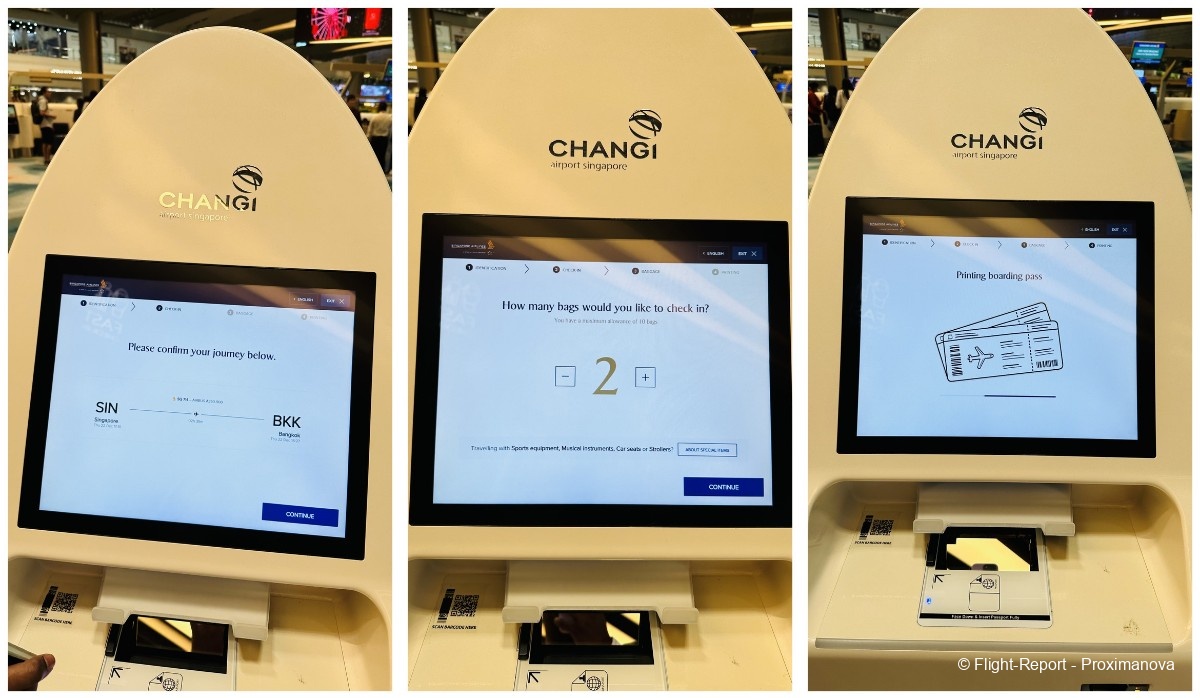

And now I discovered that the group of passengers beside me were from the World Cup-winning country of Argentina! It really did not get better than this, and there was no better way to celebrate than congratulate them for their conquest, with a ‘Viva Messi — Viva la Argentina!’ thrown in at the end. The crescendo of We are One (Olé Olá) grew louder.
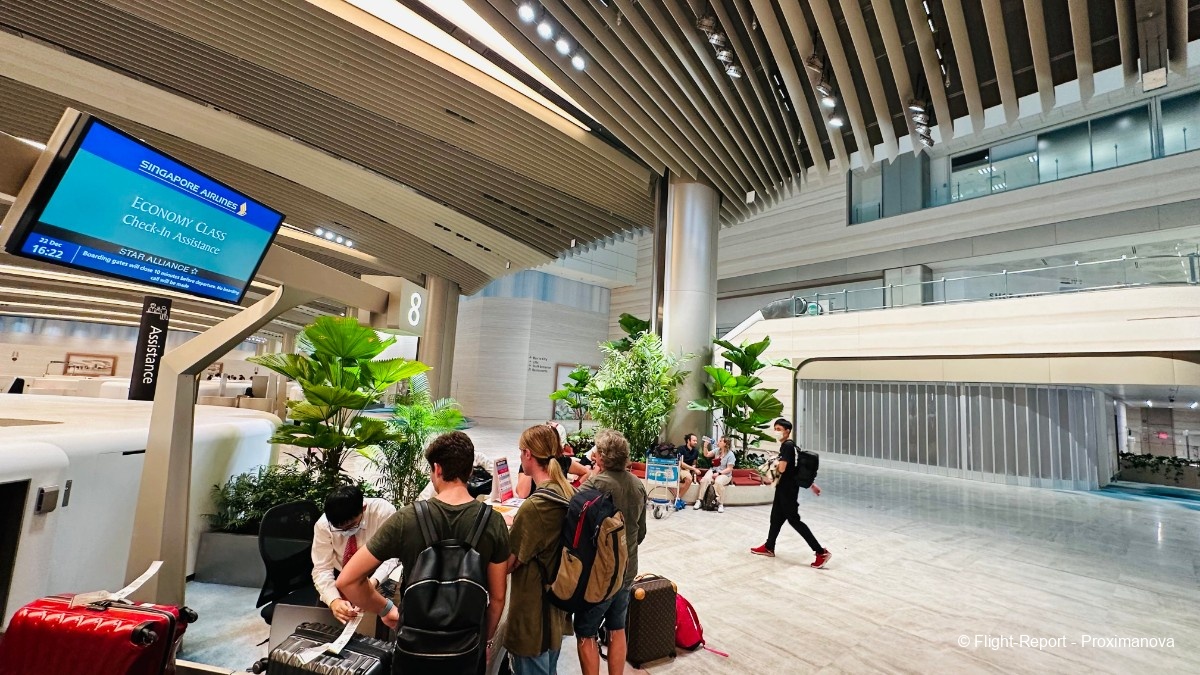
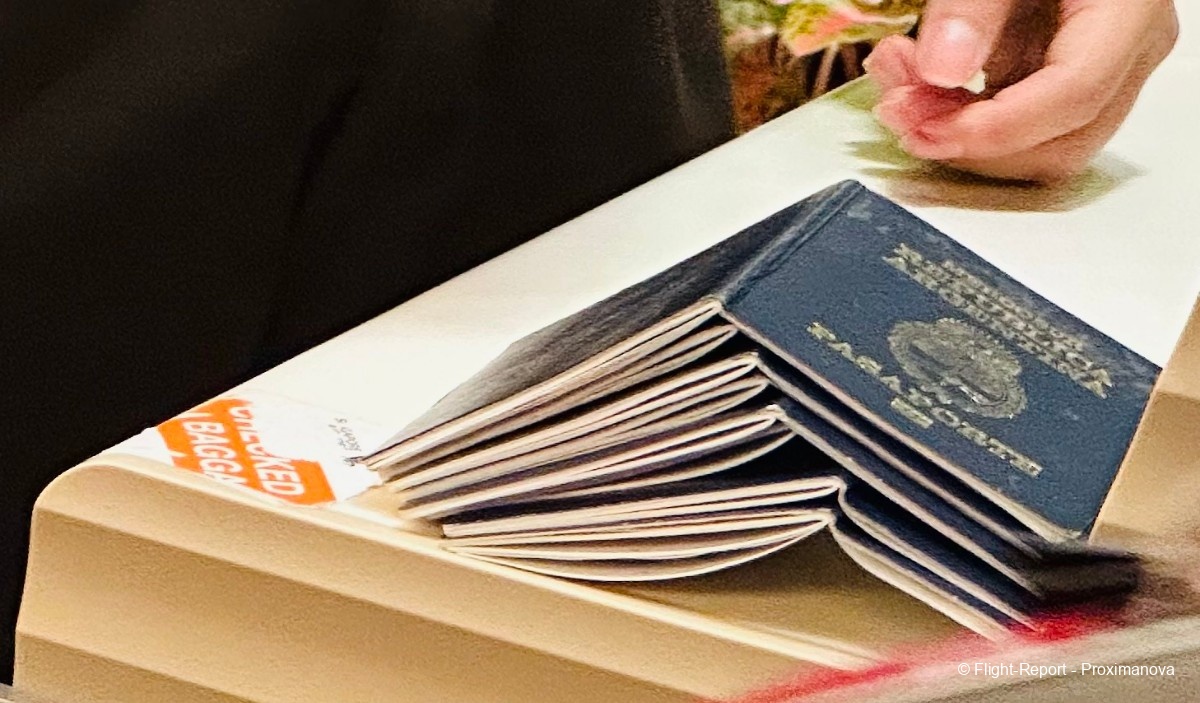
Indeed, flydubai had painted two 737 MAX 8s (A6-FKA/FKB) with a decal of Messi and his team of Campeones holding the trophy aloft, which was front and centre on the Planespotters.net homepage. Odd that any airline other than Qatar Airways — much less from a rival Gulf country — would do anything related to the World Cup on a global level (Lufthansa’s #DiversityWins livery aside), but…
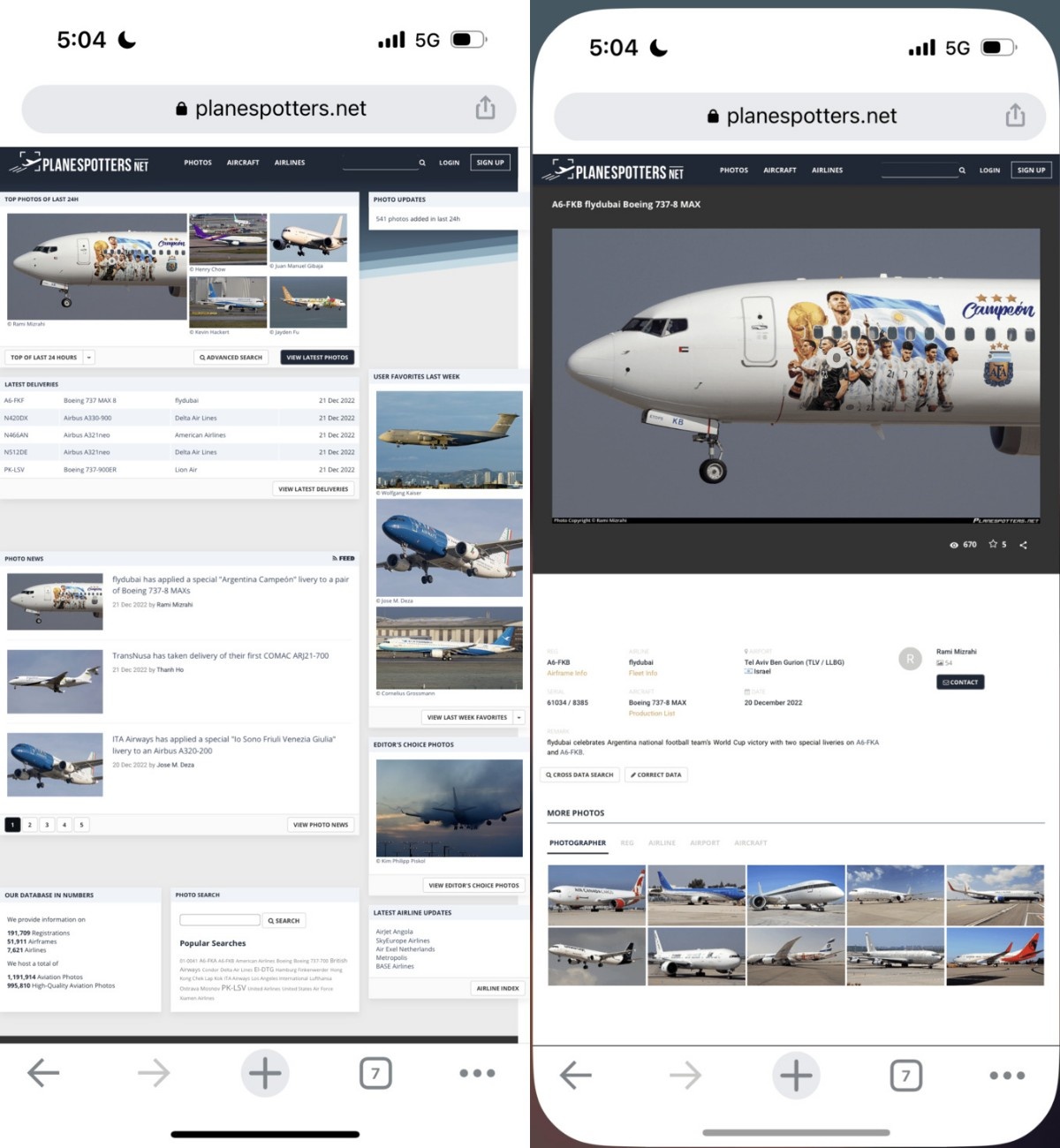
Coming to Changi T2 or T3 means you will be surrounded by Armani, Dior and Vuitton ads on all sides.
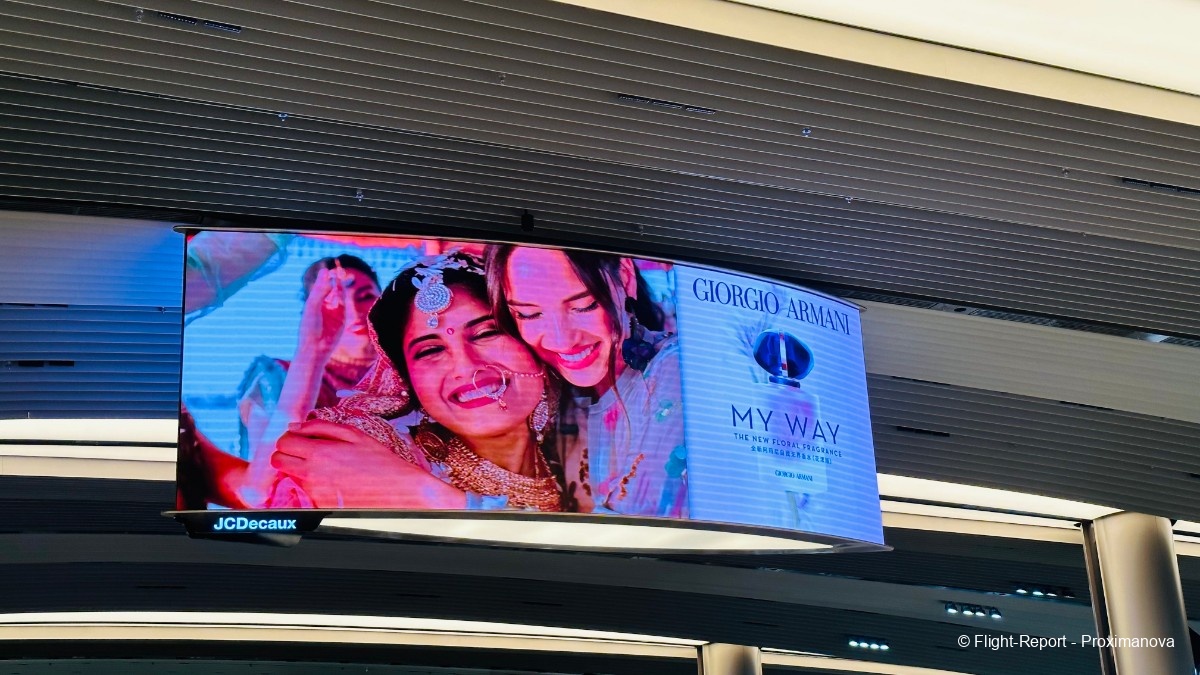
The splendid lit-up ceilings, along with the watercoloured carpets, made the place an object of beauty to behold.
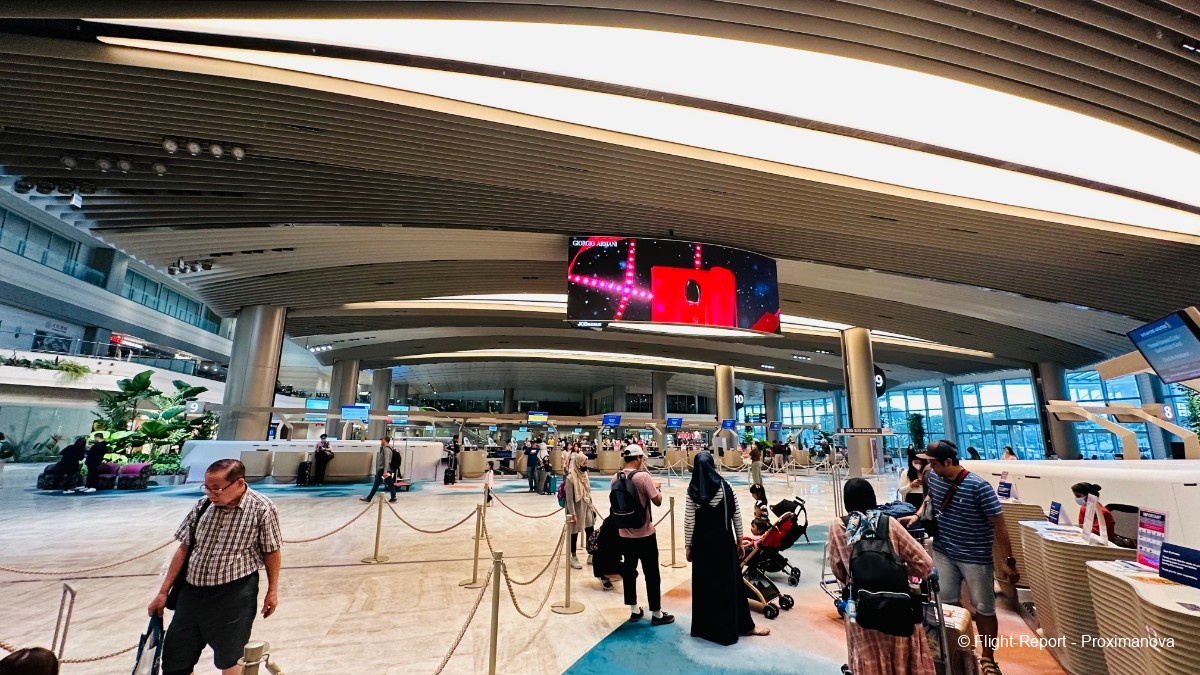
Now on it was to Immigration, with the rainforest sculptures being as intricate as the carpeting.
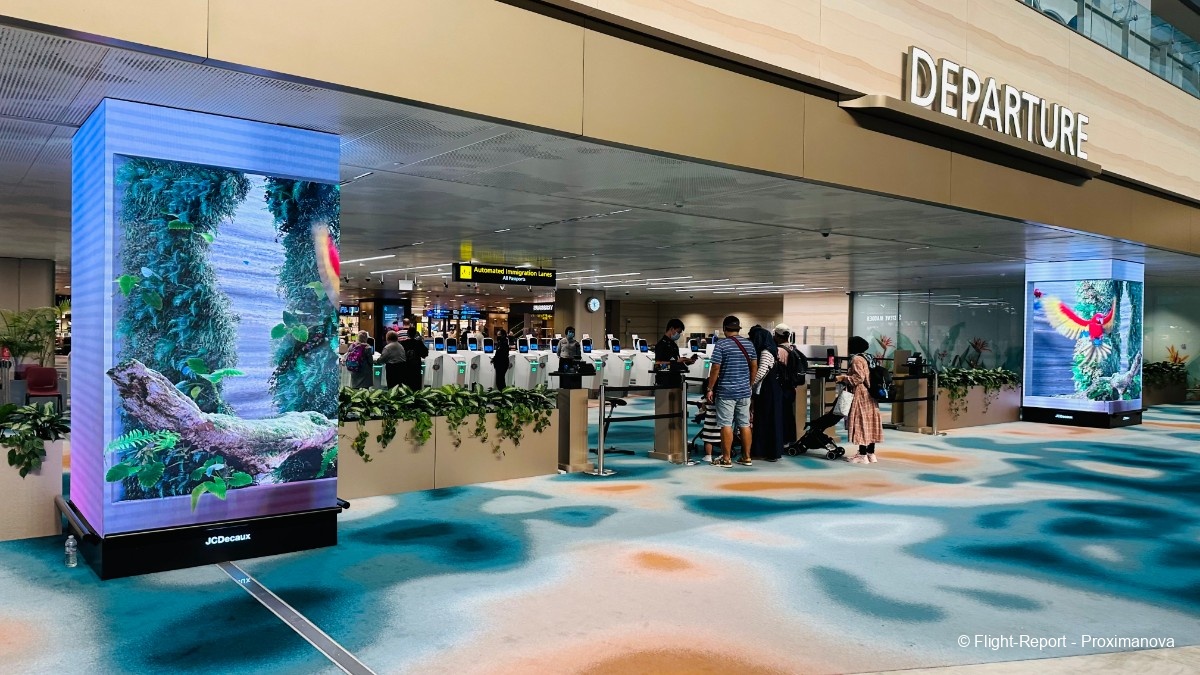
Coincidentially, many of the world’s top airports use the age-old classic Frutiger font in their signage: Changi, Dubai, London Heathrow, Paris CDG, etc. I have never been very fond of this font, as it looks extremely formal and serious. It seems Bengaluru T2 has followed its lead and chosen the dull-as-dishwater Frutiger for its signage, instead of the far more unique Akzidenz-Grotesk in T1, a rarity in airports.
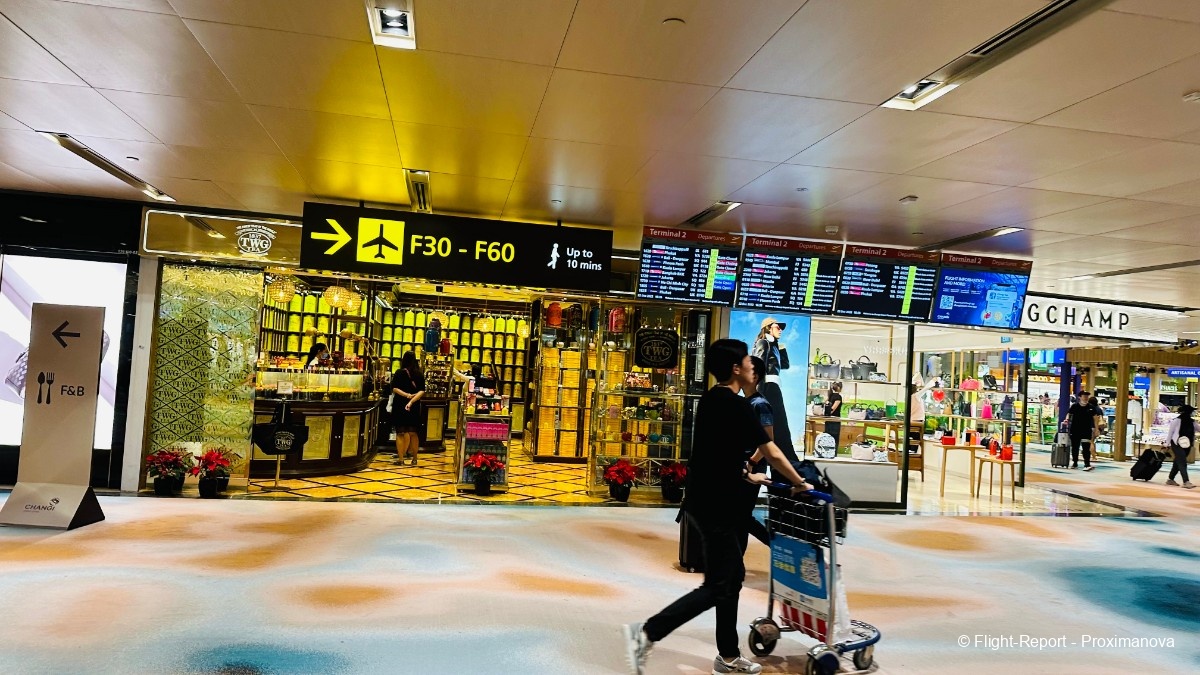
People had only just started to take off their masks, and around a third of passengers persisted with them.

All departures from T2 were confined to SQ’s Southeast Asian departures and Air India (Express), with other airlines that operated here prepandemic moving back in the ensuing months — though IndiGo hasn’t.
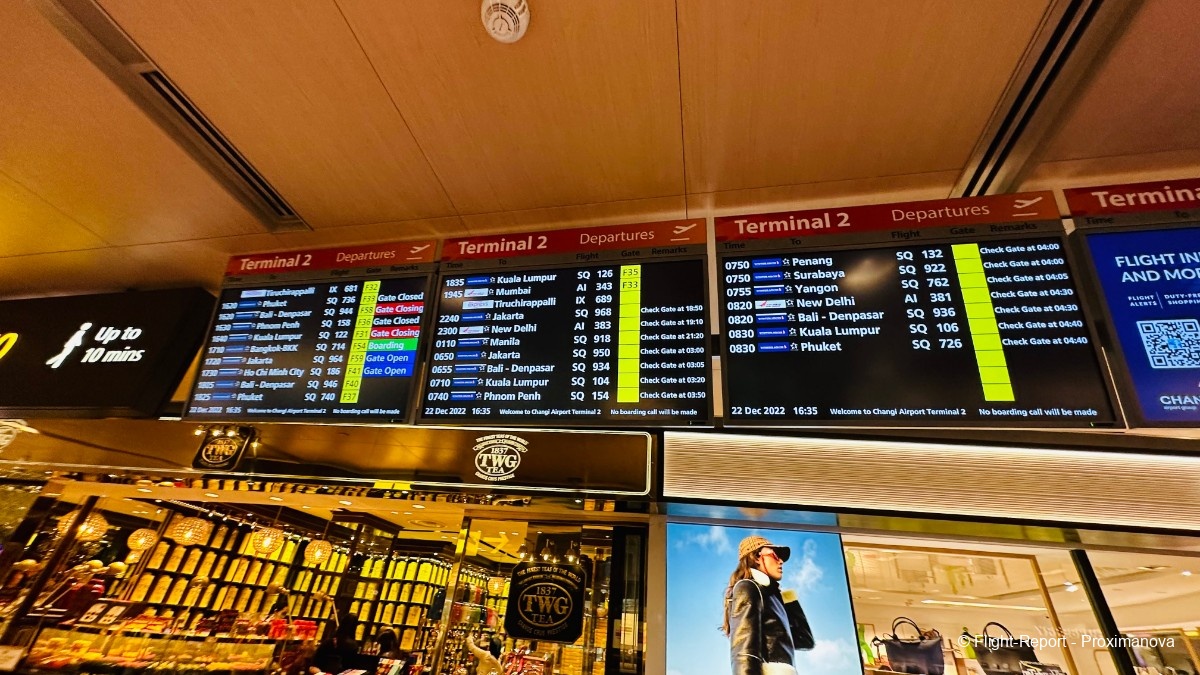
Some more shops, ranging from a money-changer — where I’d visit earlier this month (June) to get one million Indonesian rupiah (around S$90) for my Bali trip — to a WHSmith bookshop.
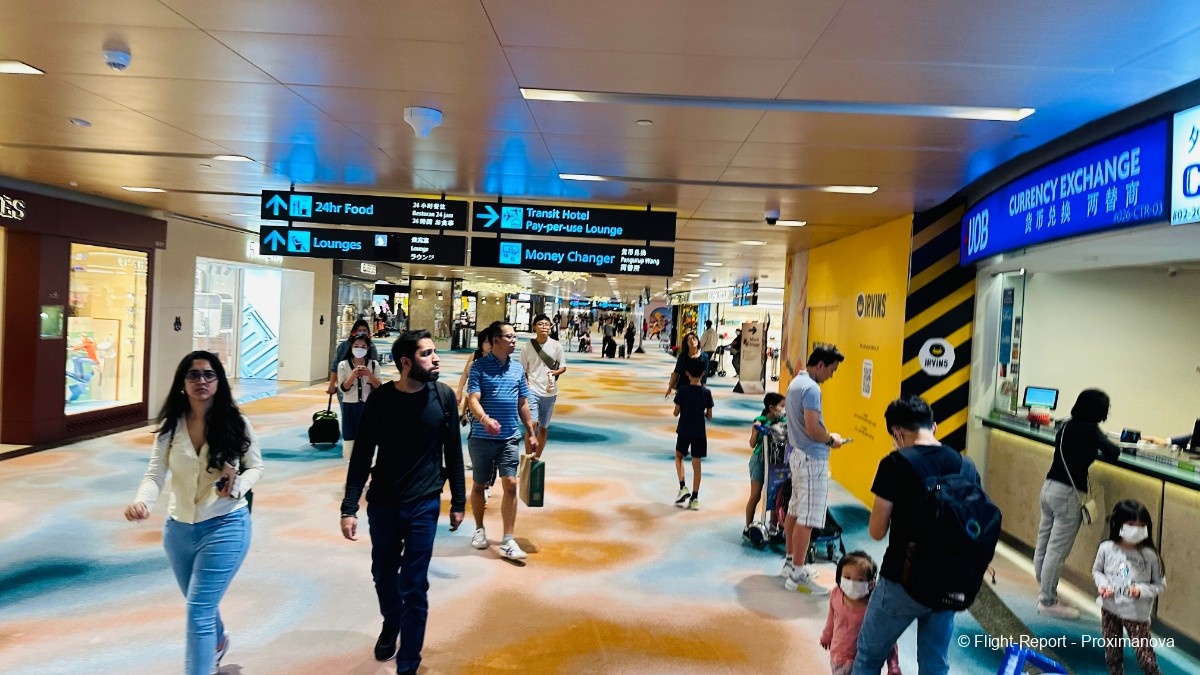
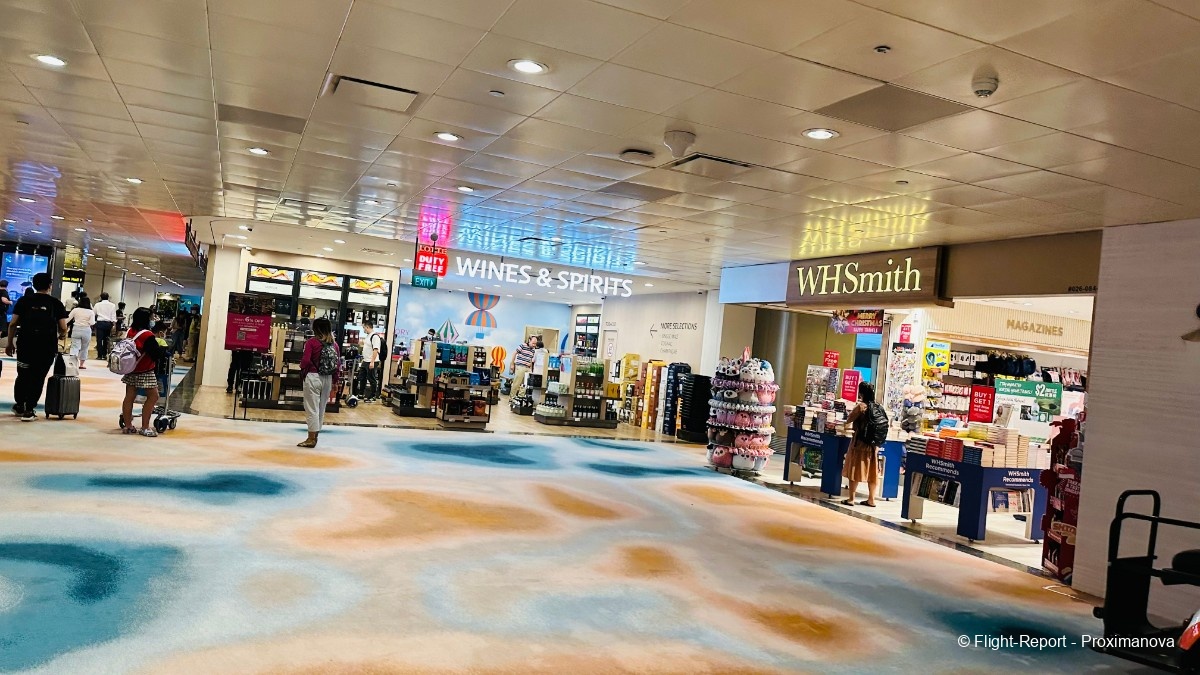
Now I was at gate F54, where Flight 714 was accepting passengers to Bangkok. Unlike the Tintin book of that name, where instead of a clean departure from Jakarta to Sydney, the eccentric billionaire Laszlo Carreidas’s private jet — carrying Tintin, Haddock, Calculus and their friends — was whisked away by his assistants-turned-hijackers to a gangster’s den on a remote island in Papua!

It had a number of ecletic codeshare partners, ranging from part-subsidiary Vistara to Virgin Australia Airlines to Bangkok Airways. It’s funny that SQ will prefer codesharing with direct competitors Garuda Indonesia and Malaysia Airlines, plus Bangkok Airways, over alliance partner Thai Airways. It seems there’s no love lost between SQ and TG, and they can only just tolerate being together in the Star Alliance!
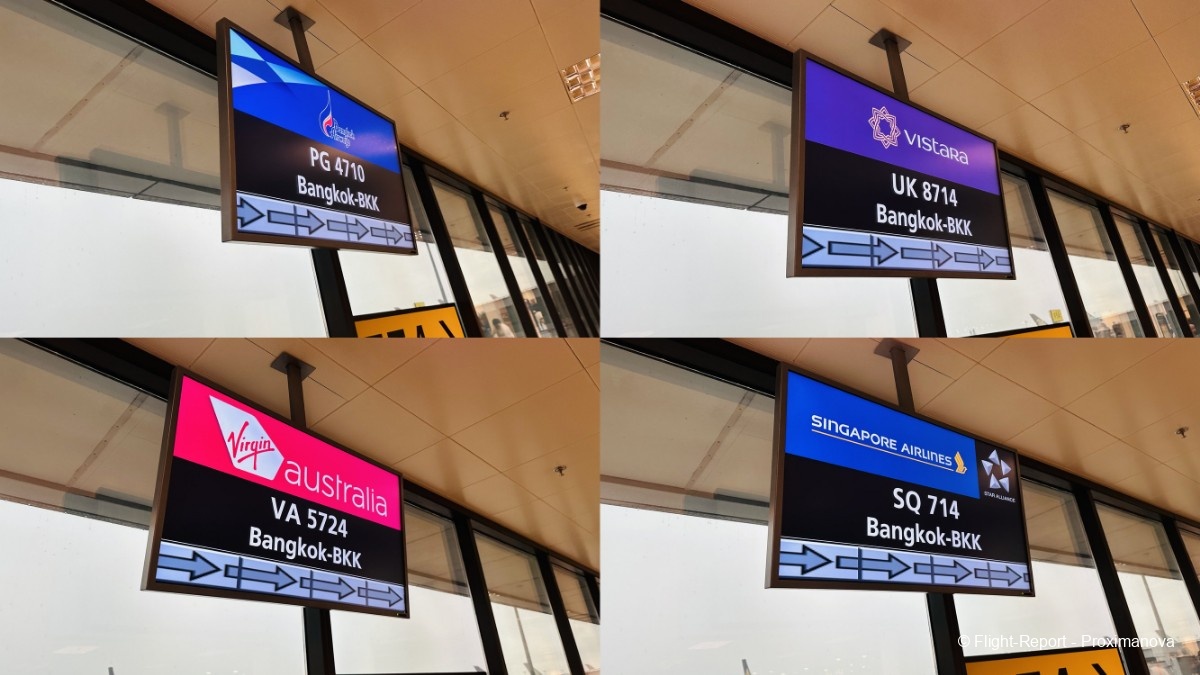
At the gate stood ‘Sharjah’, as I’ve nicknamed her, the reason for which will be very obvious from the letters ‘HJ’ on the nosewheel. Not a very special A350, certainly not as much as 9V-SMF in October, but by all means a new one.


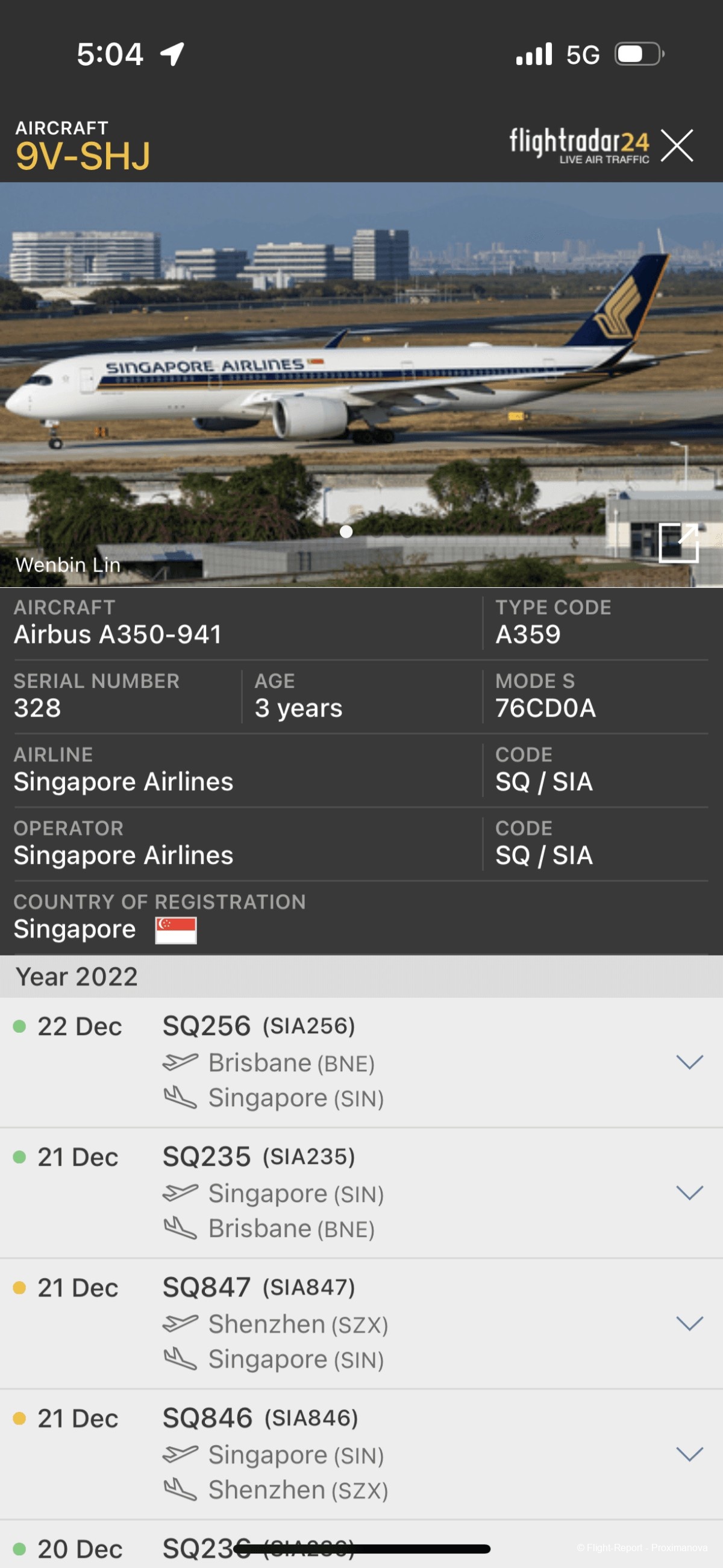
Passengers milled about by the gate: the typical low-ceilinged one found across Changi T1 and T2, unlike those in T3 which have huge ceilings. Not that I’m complaining about those, even as a person who ordinarily has a phobia of high ceilings: Changi knows how to make everything look far better than it actually may be!
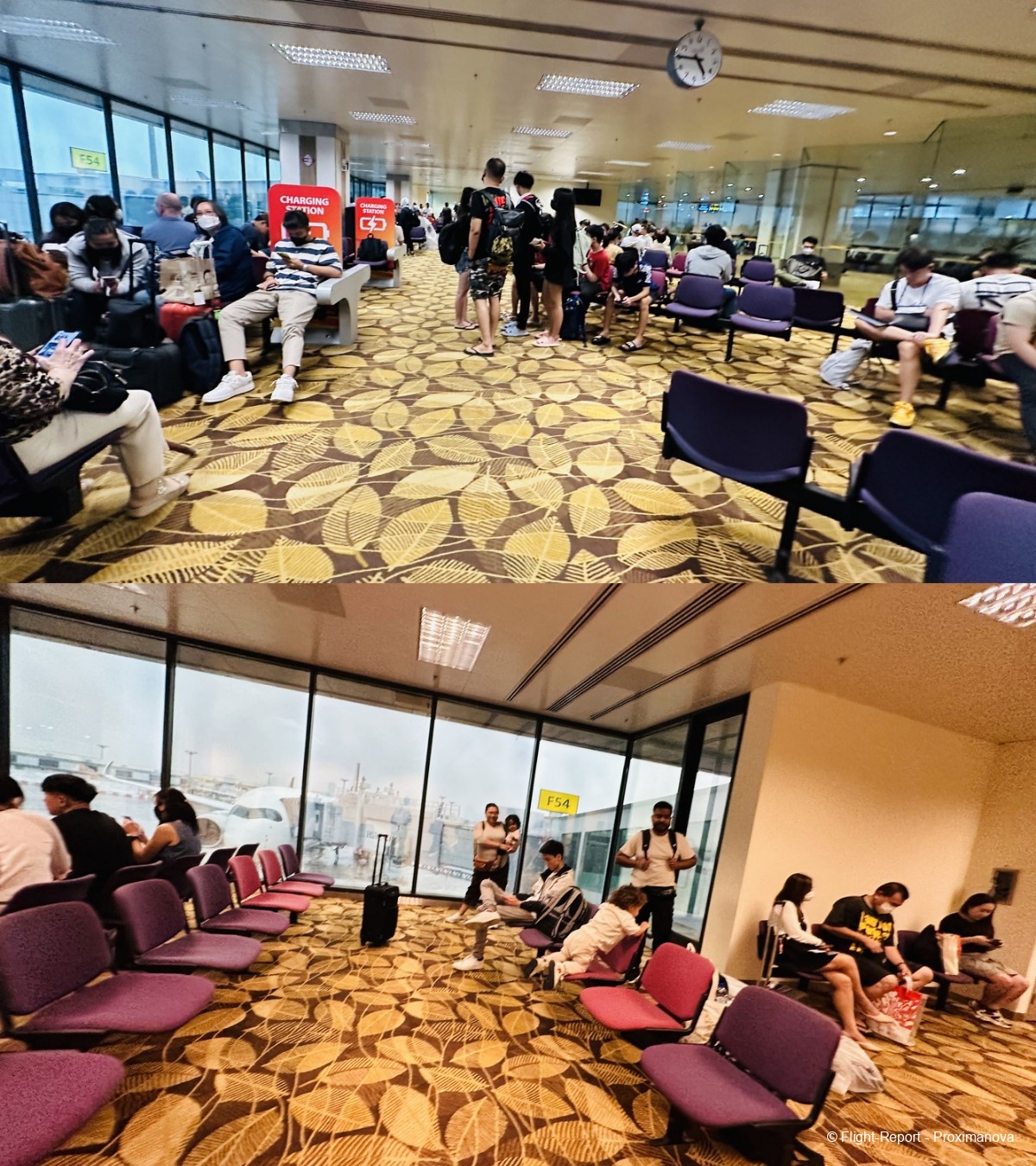
Now I was on the jetbridge, adorned as it always is by ads for HSBC (my dad’s new employer in Bengaluru): in this case in Chinese in addition to English, sometimes also Malay, though more often than not all ads are in English.
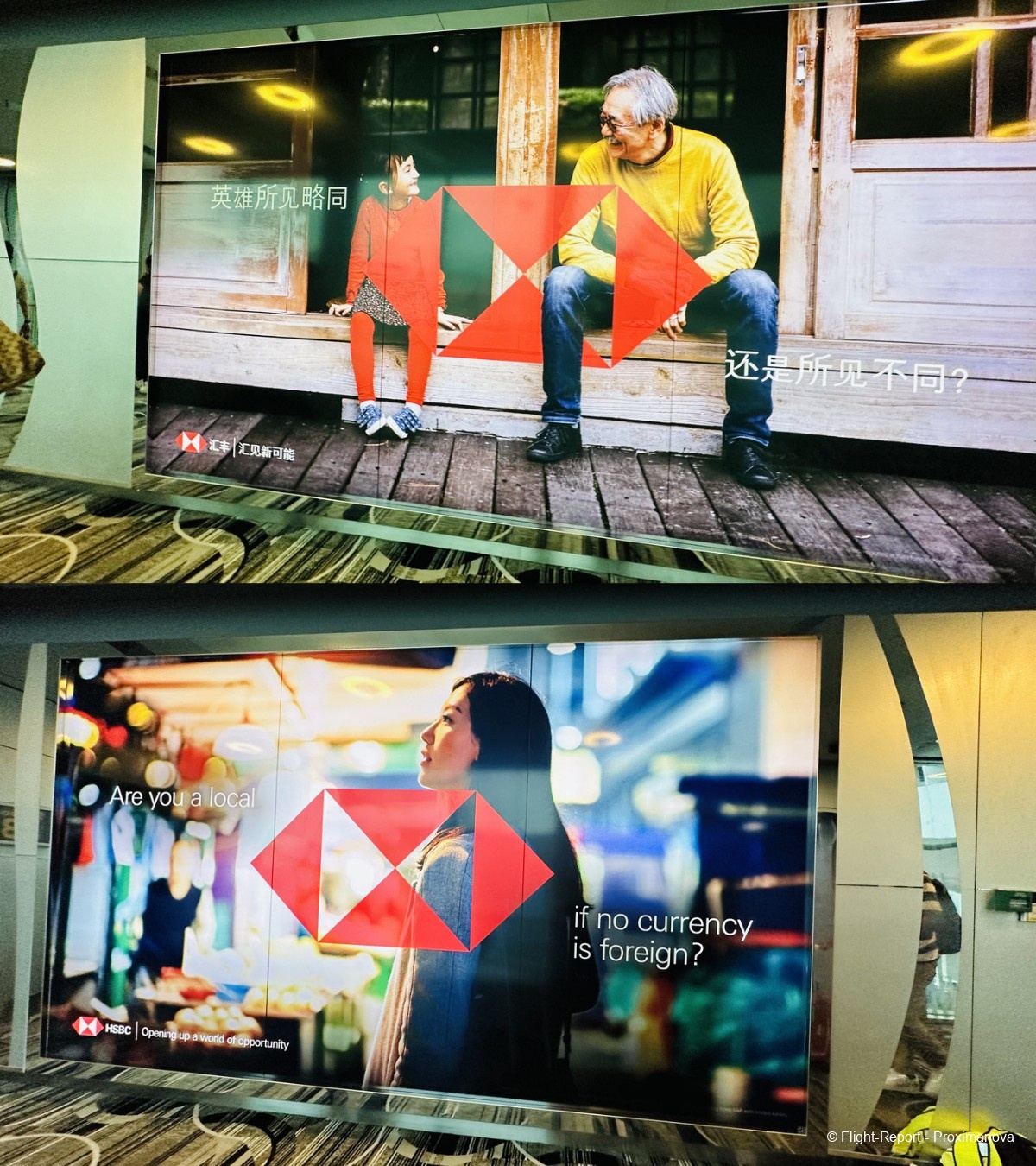
Soon enough I was on board 9V-SHJ, with passengers invited to collect earphones at the entrance.
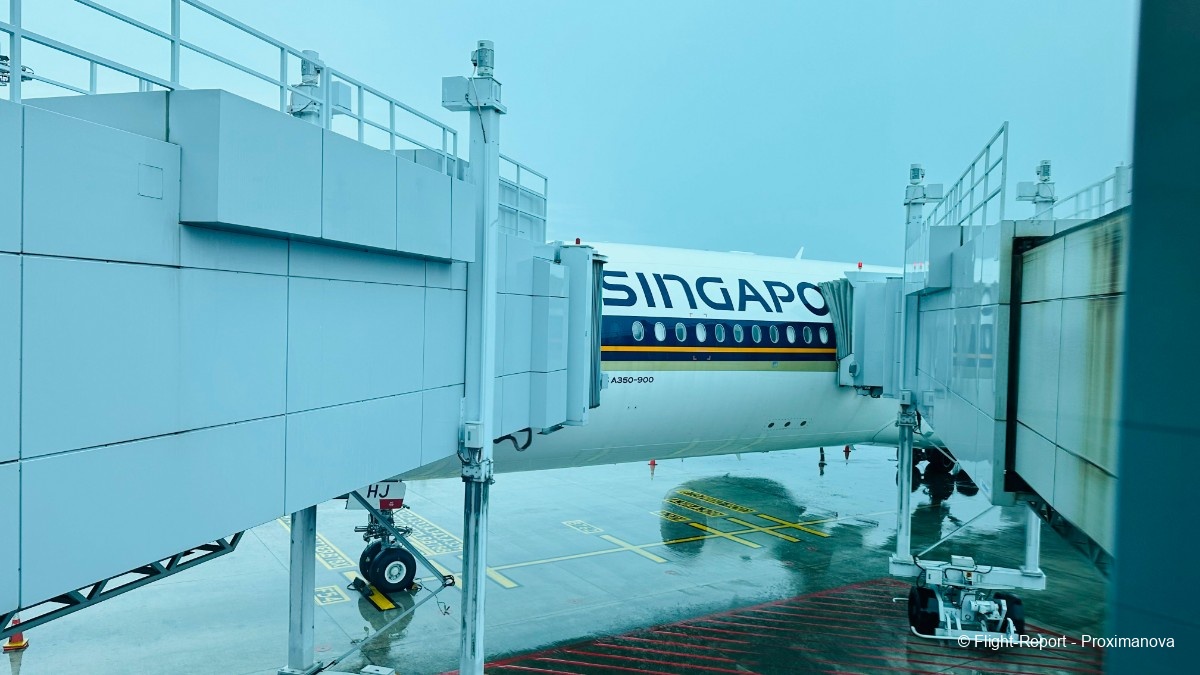

The beat of We are One (Olé Olá) reverberated throughout in my head; I didn’t need earphones for that.

Boarding and takeoff: Olé, olé, olé, olá
Flight: Singapore Airlines SQ714/SIA714
Date: Thursday, 22 December 2022
Route: Singapore Changi (WSSS/SIN) to Bangkok Suvarnabhumi (VTBS/BKK)
Aircraft: 9V-SHJ, Airbus A350-900 (regional configuration)
Age: 3.4 years at the time (first flight: 19 July 2019, delivered: 9 August 2019)
Seat: 67K
Boarding: 4:50pm SGT, UTC +8 (3:50pm Indochina Time, UTC +7)
Departure: 5:55pm SGT (4:55pm ICT)
Arrival: 6:55pm ICT (7:55pm SGT)
Duration: 2 hours 5 minutes
Notes:
• Fourth flight on Singapore Airlines in 2022 and second on its A350 after SQ126 on 9V-SMF in October. The next flight on SQ and the A350 would be after 14 flights: 27 June 2023, SQ510 SIN–BLR, 9V-SHE, with the upcoming return SQ511 leg also on the same aircraft type.
• First on the regional (9V-SH*) A350 with its IFE system from Thales.
The small Business Class cabin to the right — there being no Premium Economy on regional A350s — was starting to fill up.
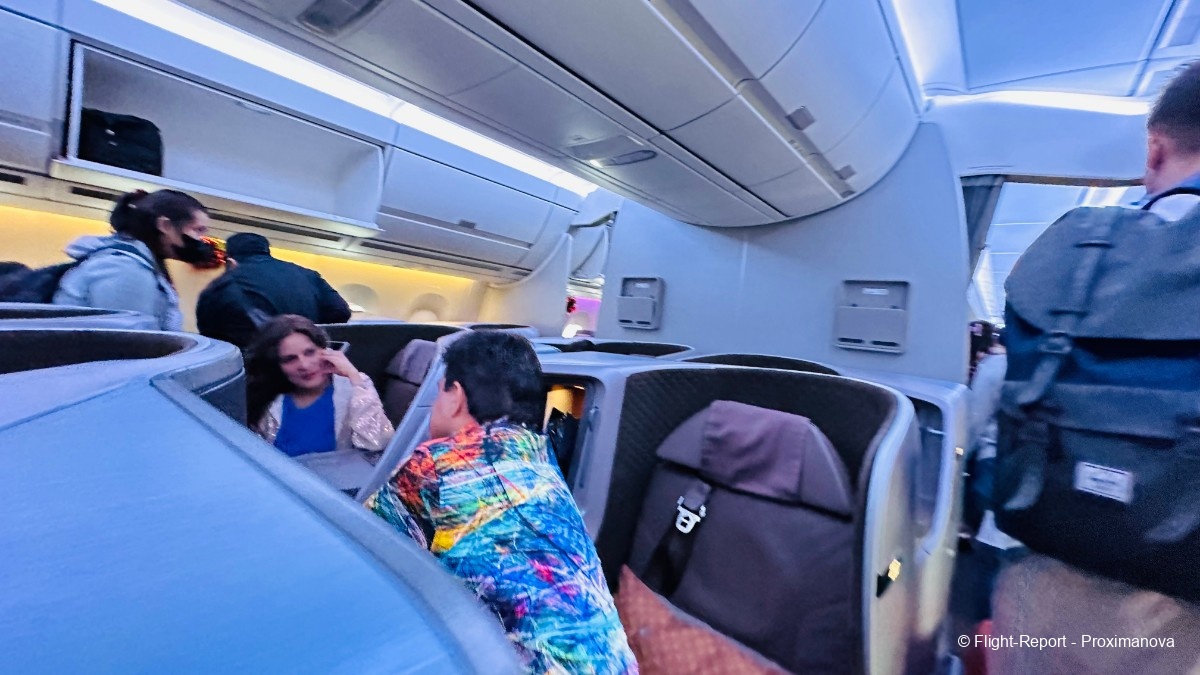
Christmas was in the air and on the walls, in the form of mistletoe decorations.
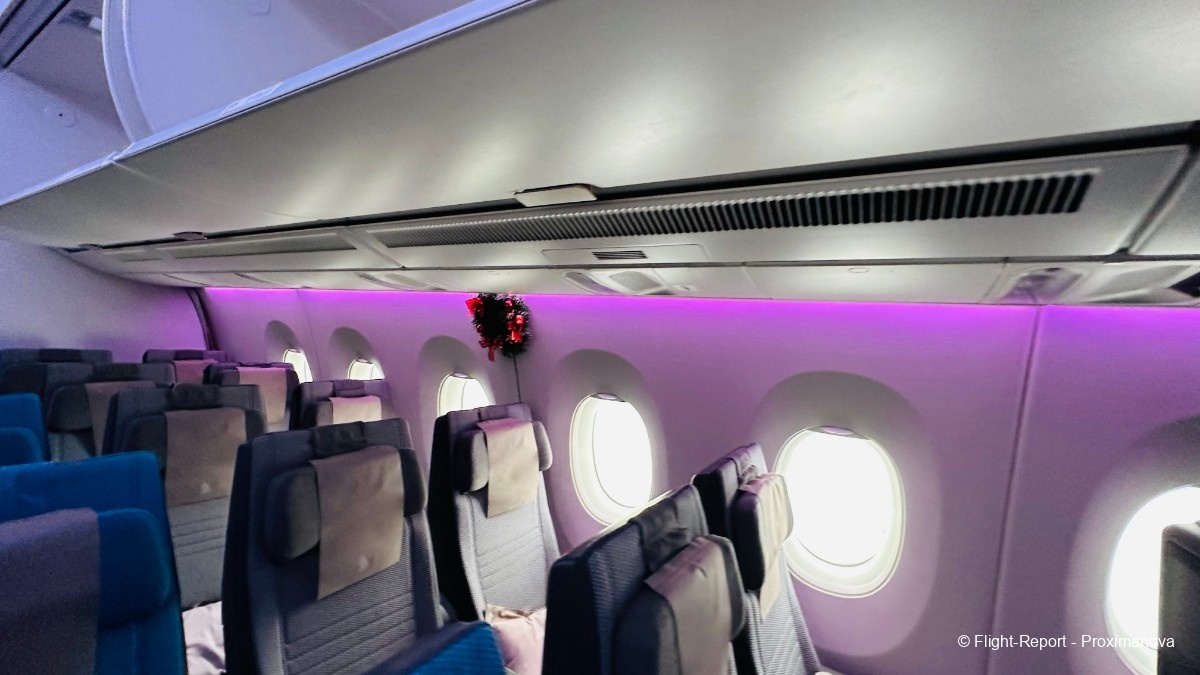
I don’t like the drab grey-and-blue seats on the regional A350 and the 787-10, compared to the bright seatbacks on the A350 Longhaul. This blue is nowhere near as happy as the bright fabrics of SriLankan or Garuda.
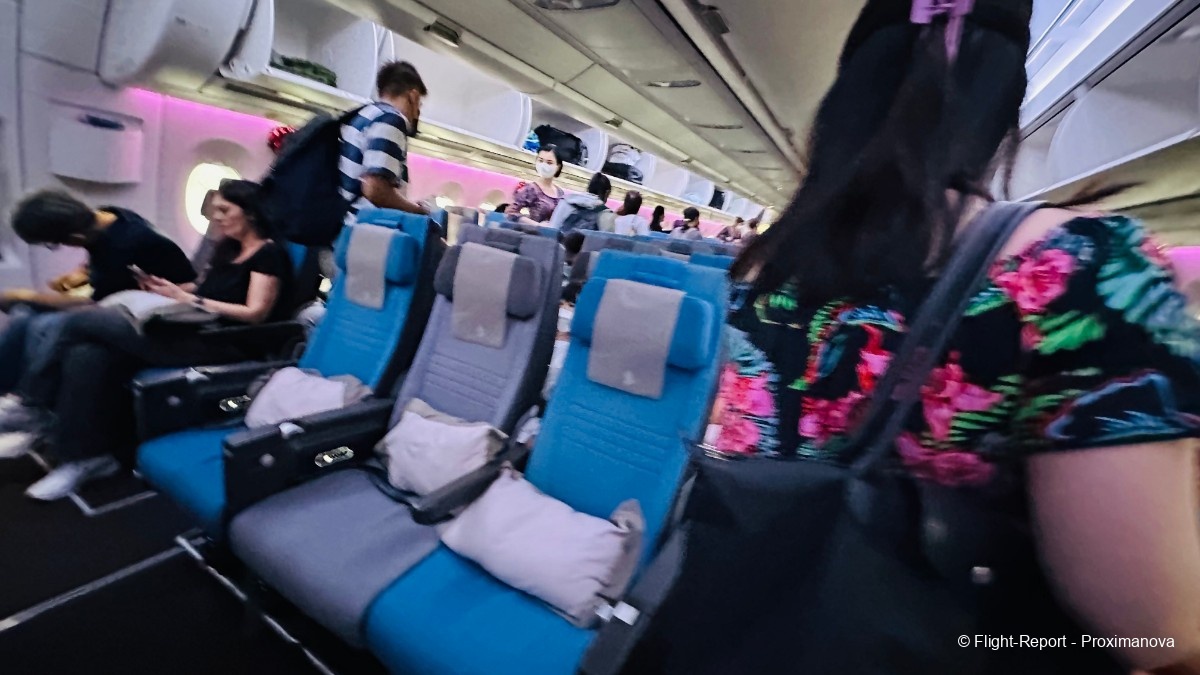
In keeping with my preference for seats at the back and towards the right — preferably in row 66 or above — I’d settled for 67K, the window seat in the antepenultimate (third-from-last) row. I chose the exact same seat on my flight to Bengaluru a couple of days ago, operated by a fellow regional A350, the one whose name is SHE.

This was my first time using the much nicer Thales IFE system that is only found on the A350 Regional, as all other SQ aircraft — barring the inferior 737-800 of course — have the somewhat tackier Panasonic system and its rather clichéd, lower-class Montserrat font that has no place at this carrier that is a flying symbol of luxury.
However, Panasonic does score one-up on Thales in the map department, as the former’s Voyager 3D is far more detailed and customisable than Thales’ 3DMaps. Not to mention Panasonic’s even more advanced Arc system that SQ 737 MAXes have, alongside subsidiary Vistara’s A321neos (as I experienced in March) and 787s, of which it was the global launch customer.

Within the seatback flap was a slideback mirror and a cutout cupholder. You can well forget about the SilverKris magazine: it isn’t coming back, even though the namesake website remains online for those who need their travel inspo.
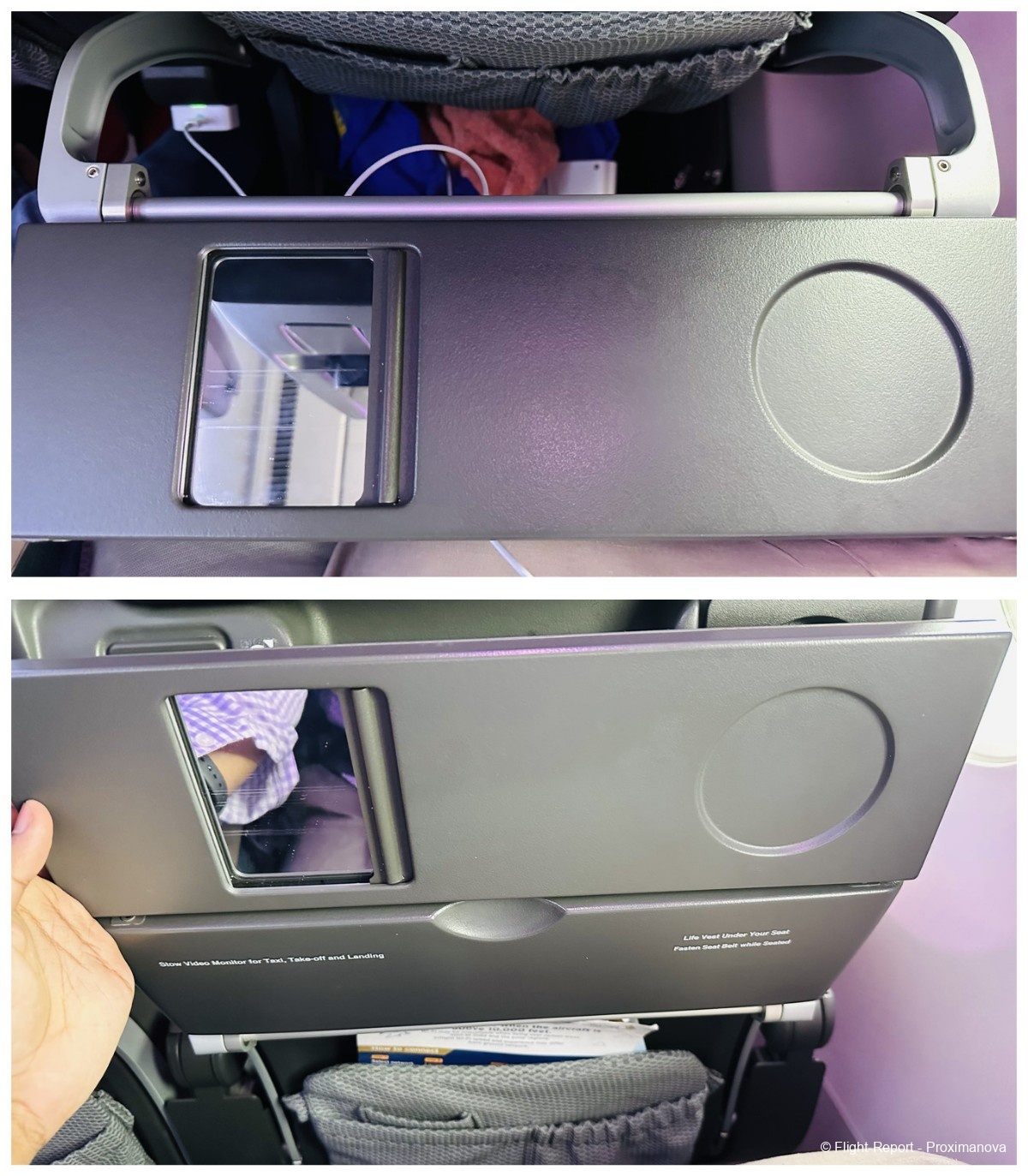
Is KrisWorld as good as it claims to be? Yes and no
I have never been successful to sign in to the KrisWorld system with my KrisFlyer account number, and this was no exception. I see it as more of a bane than a boon, though, since I don’t want recommendations from an airline IFE system that I’ll barely use every few months. As it is, I don’t like YouTube serving me up random videos from my history in the name of suggestions and recommendations — much less an airline.
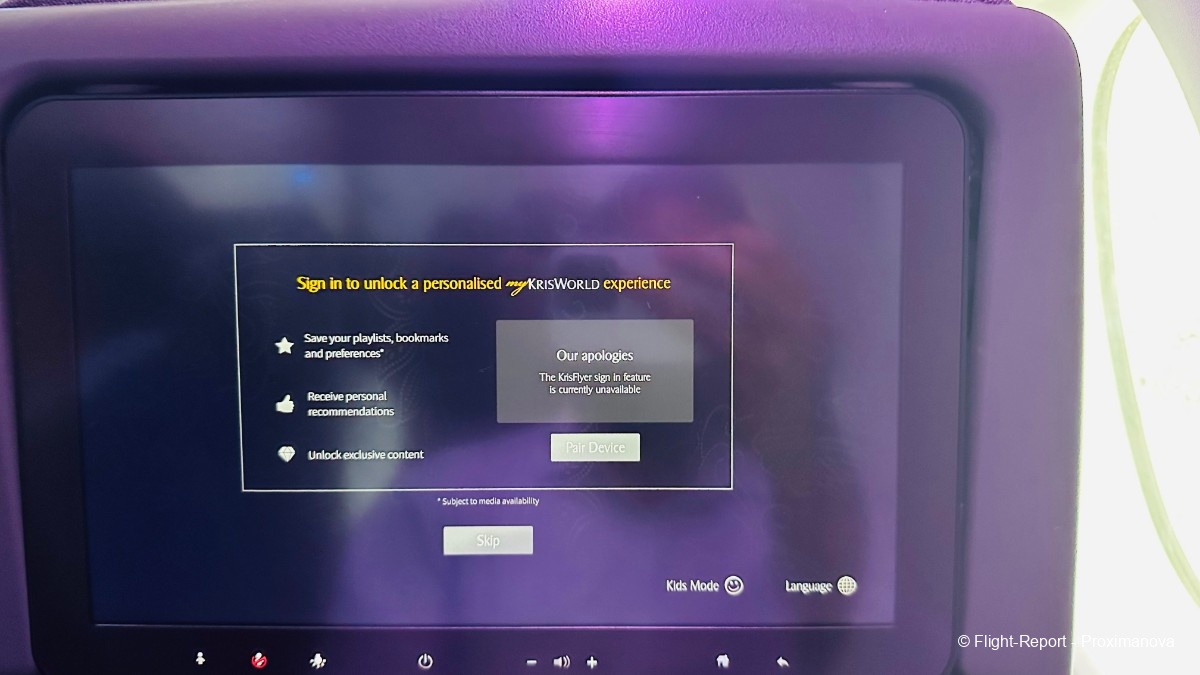
SQ does a good job in highlighting new releases every month, which other airlines in Southeast Asia do not, as they simply ask you to select the movies or TV menu instead of presenting their latest and greatest.
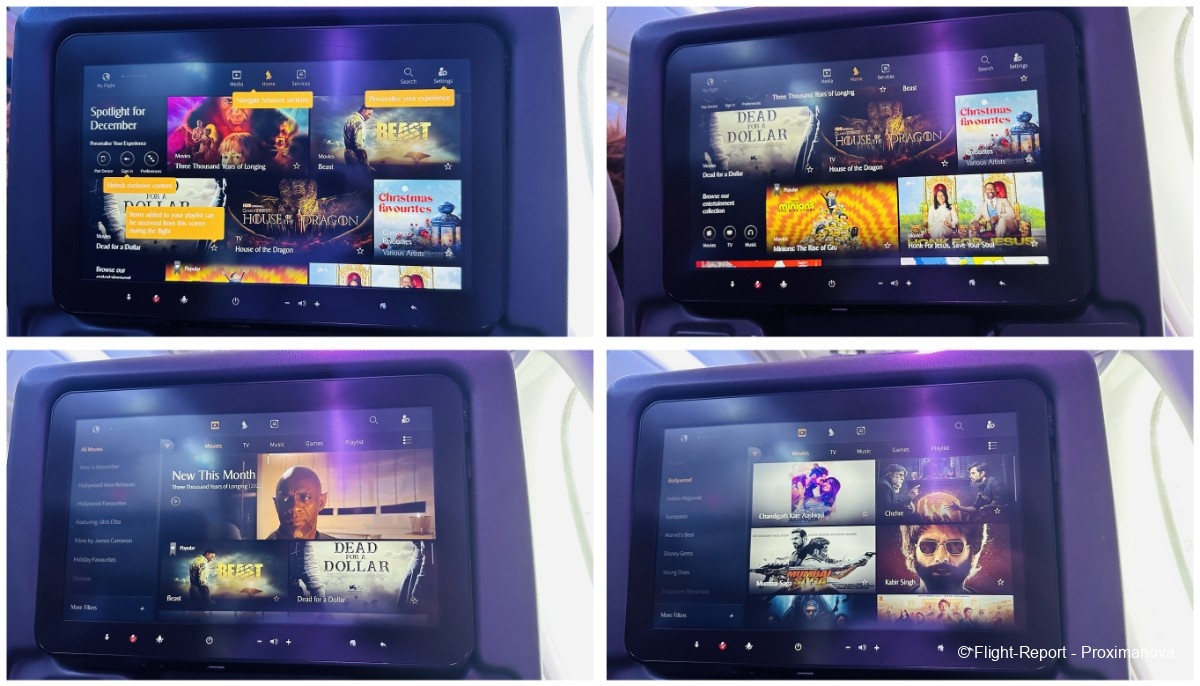
There were a few offbeat videos and productions to be found, such as some LinkedIn Learning videos and a documentary on the FIFA World Cup.

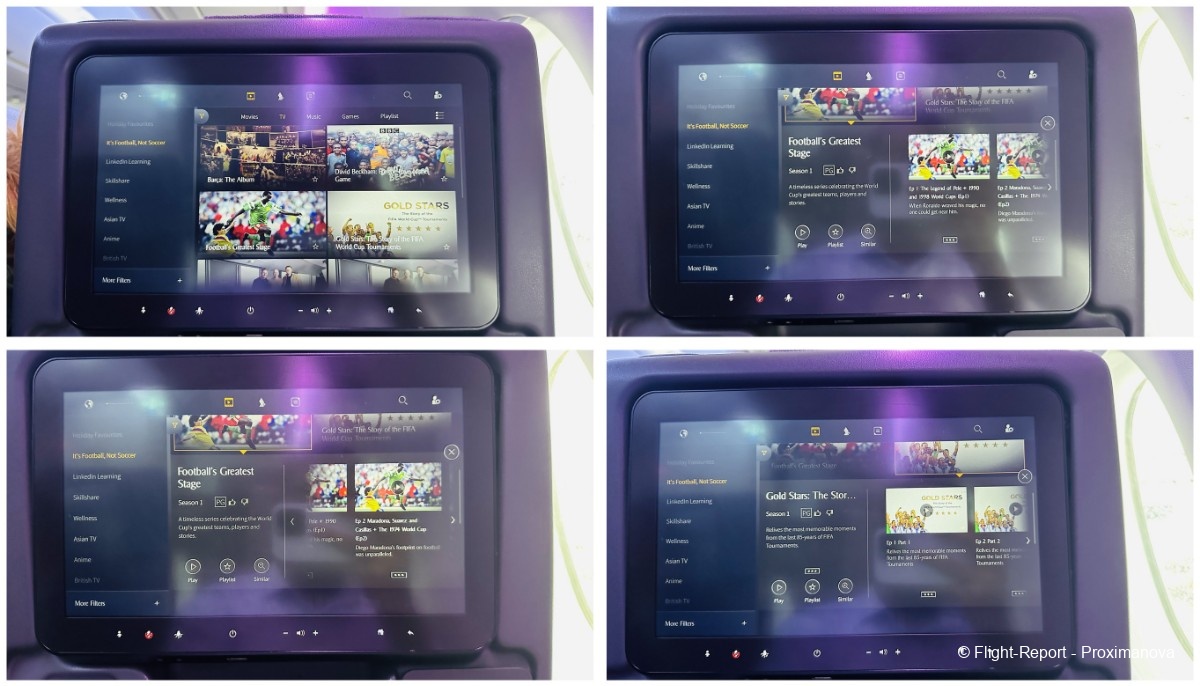
Then came the airline’s own section, of course, with brand videos that highlighted what it did best: set the standard for excellence in inflight service and safety. But some feel that SQ has become complacent in the face of scorching competition from those in the region, like Starlux from Taiwan, and those further afield, like Qatar Airways.

Also present were some rather neglected sections: the KrisShop catalogue, the inflight dining menu (which simply directed users to the corresponding website through a QR code instead of doing anything onscreen) and some surveys, which in any case were unavailable, unlike on SriLankan or Emirates. There were also ways to tweak the experience, including pairing a phone via the SingaporeAir app.
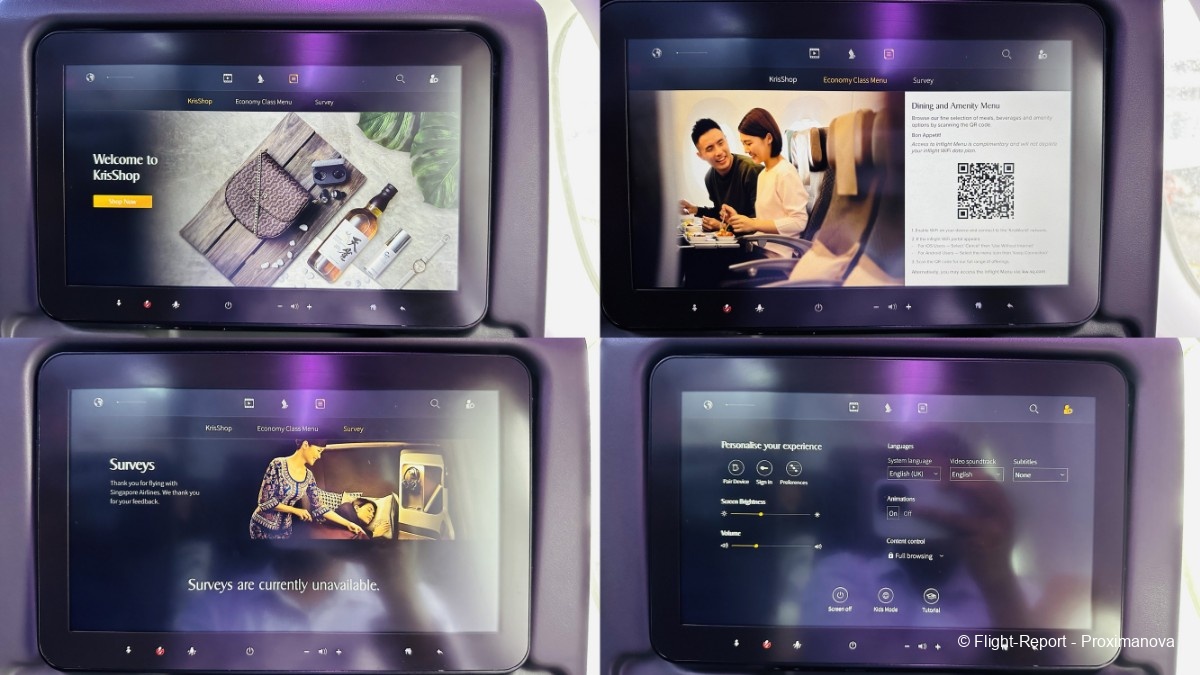
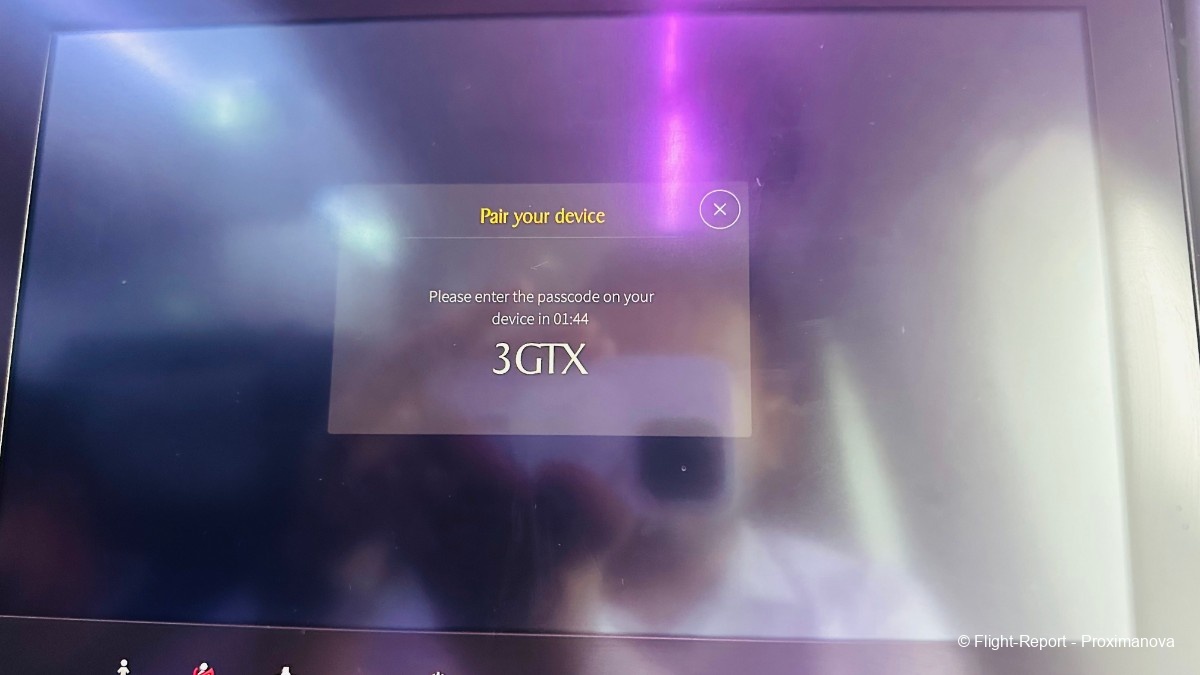
Now came a slightly primitive version of Thales’ 3DMaps system, as I found the UI to be a little bit outdated. However, my latest flight on a different A350 Regional had a more updated IFE system which even showed the registration of the aircraft (in that case 9V-SHE): something that I always adore, and that is extremely rare outside Emirates. I wish it came to Sharjah (this plane, to be clear) sooner than later.
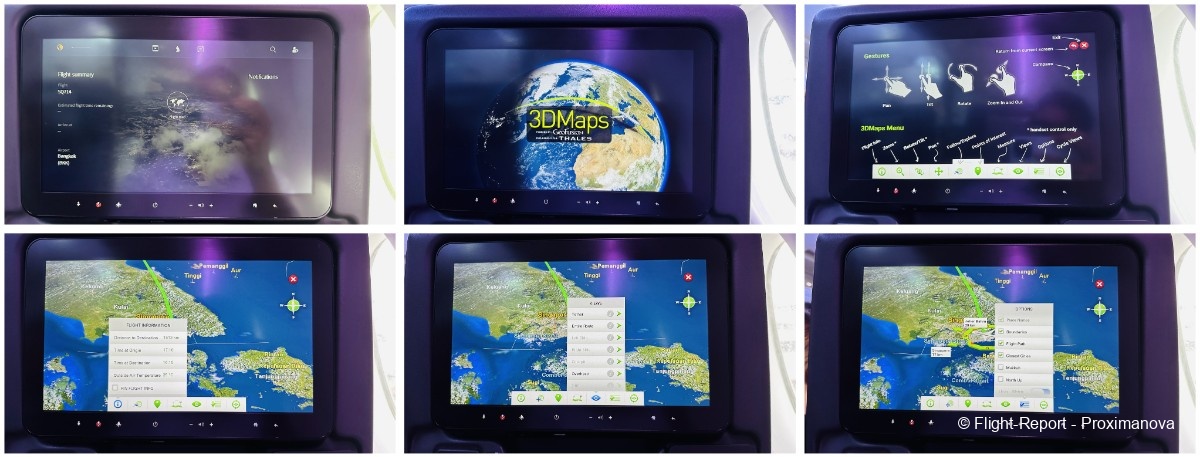
Rain, rain, go away: we want to sing Olé, olé
The SingaporeAir app, too, had its set of Yuletide decorations.
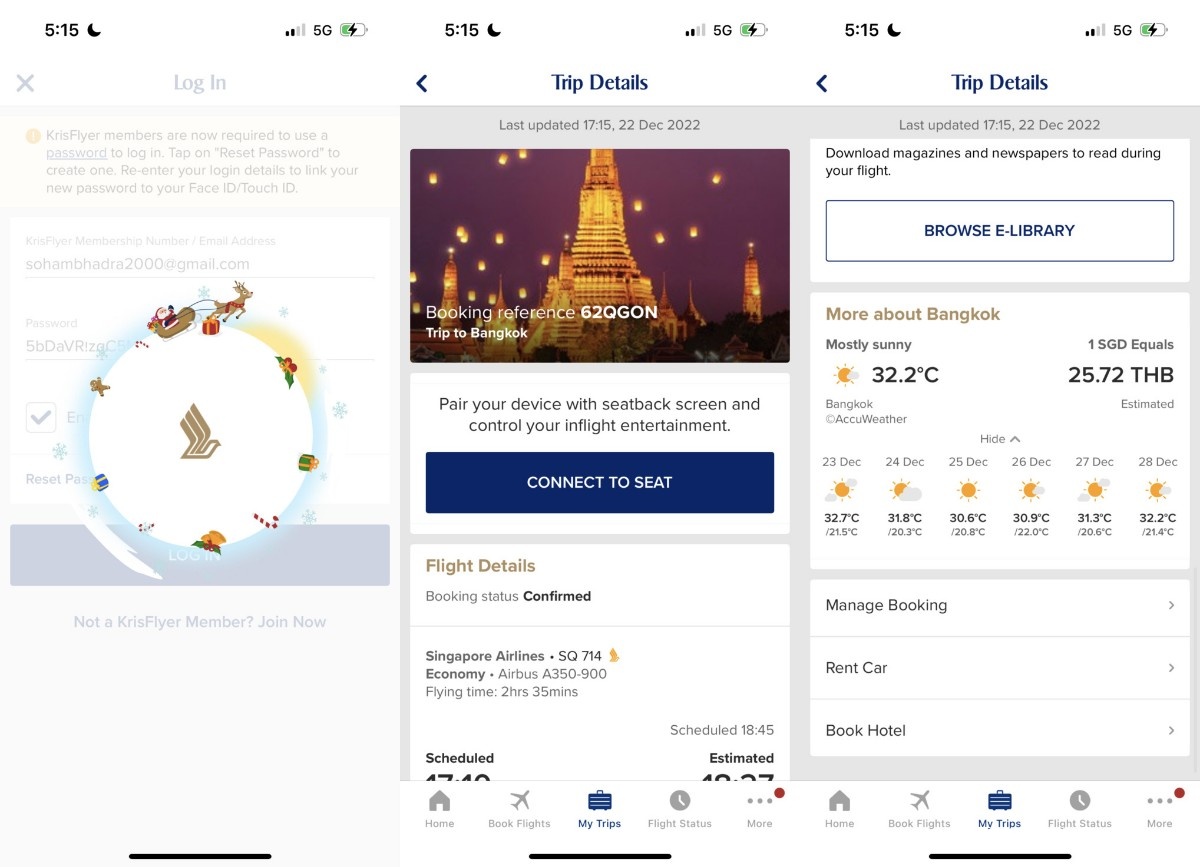
Funnily enough I don’t recollect the name of a single cabin crew member, which is just as well because none of them stood out like they would on an Indian carrier. This was also a completely English-speaking flight: no announcements were made in Thai or any other language. In contrast, for Indian flights, SQ has announcements in the local language of the city, like Kannada for Bengaluru.
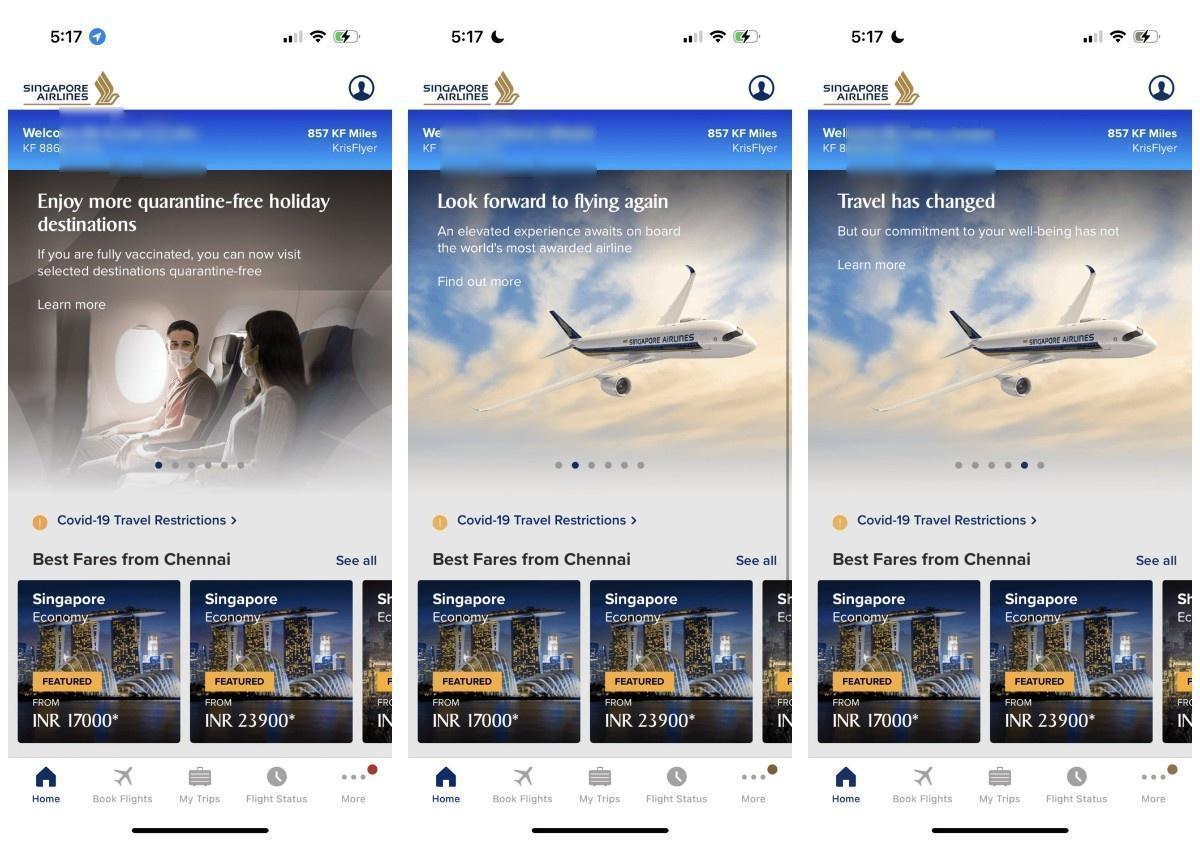
I don’t need to say more about the soothing, soporific effect Singapore Airlines’ safety video and its soft instrumental music has, which drives home the fact that this is an airline of elegance, deftness and luxury. In other words, NOT Malaysia Airlines’ loud, energetic and over-the-top Satu, Dua, Tiga, Jom dance number, or Thai Airways’ cheery exotic rainforest production which I would get next, for the fifth time overall.
However I could not help but notice the cute little kids: from the tiny, overjoyed one strapped to his parents as they cruise down the river, to the smart, bright one beaming as he helps paint a wall with Dad, to the daddy’s little princess wearing a kiddie life vest as she prepares for a dive into the pool.
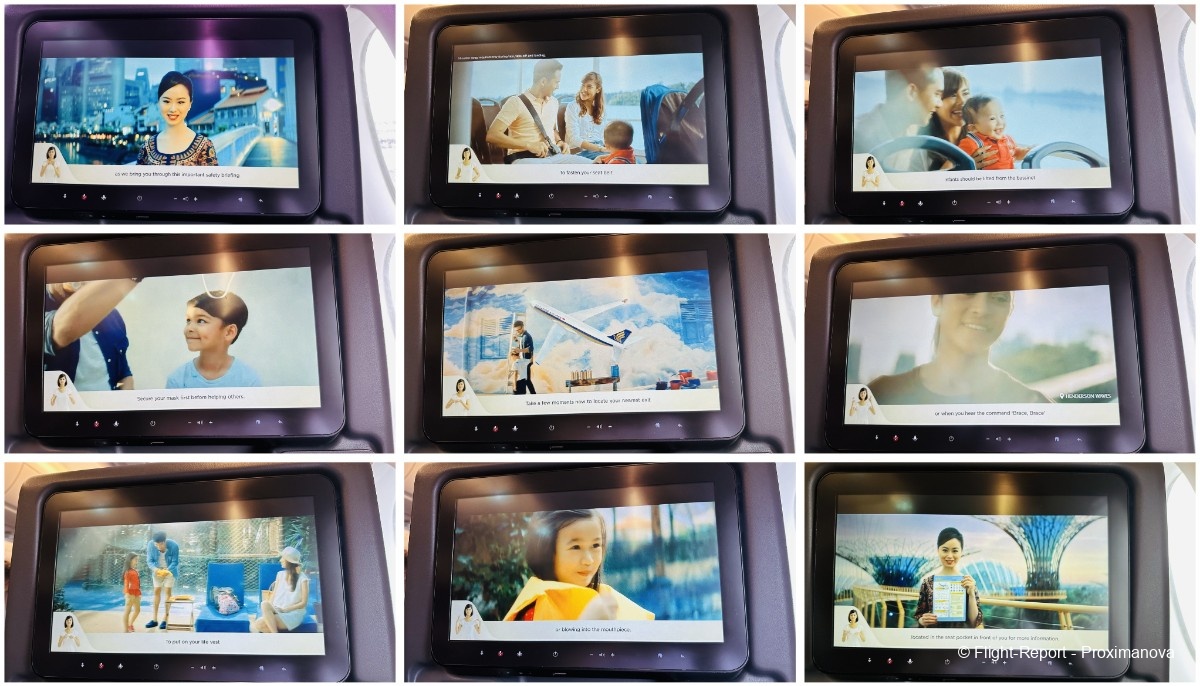
Meanwhile a bunch of interesting aircraft were arriving, among them an Air New Zealand 787 and a Biman Bangladesh 737, and also an SQ 777-300ER from Delhi. For the winter season, the Indian capital had lost its sole A380 service — EK has never flown its A380 to DEL — which was restored in March for the summer schedule, while Mumbai enjoyed A380s throughout the winter. However, from 14–15 June to 30 July 2023, both cities have had their A380s downgraded to the 777-300ER, as the superjumbos are deployed to Heathrow instead for triple-daily A380 service.
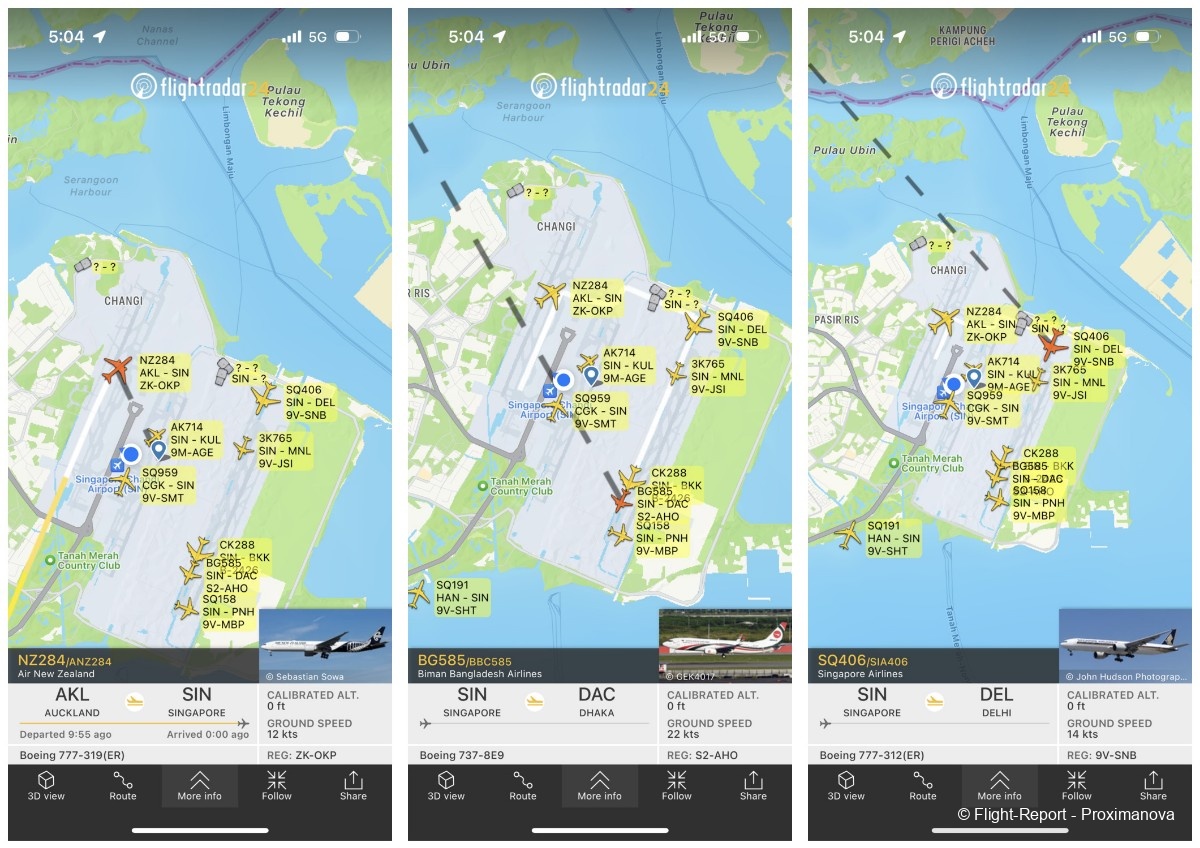
Sadly, it proved impossible to snap any of the traffic, thanks to the drizzle that had covered up the windows. Instead I had to settle for a combination of my naked eye and Flightradar24 to identify these aircraft. They ranged from A6-BNC, an Etihad 787-9…
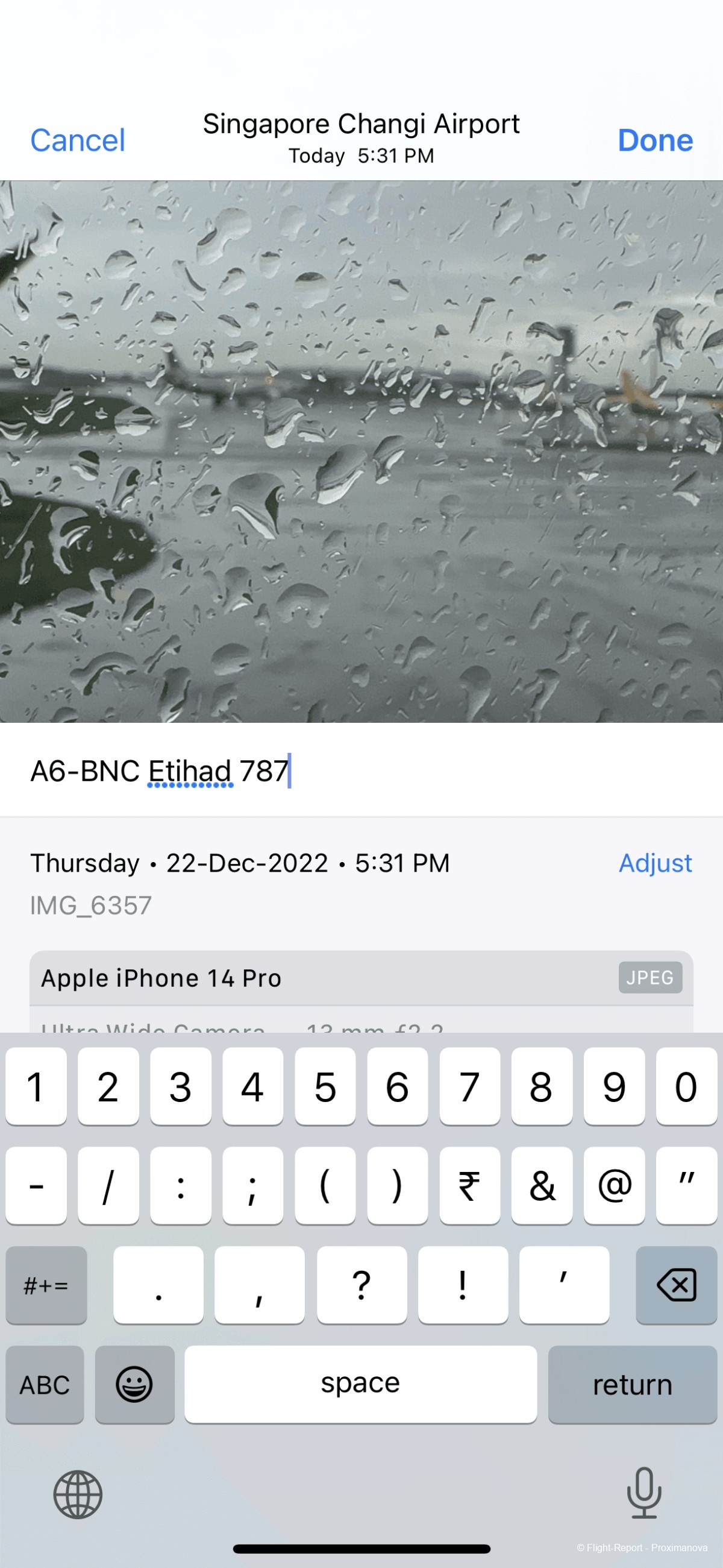
… to Sharjah’s fellow ‘Arab’ cousin, the ‘Sheik’ (9V-SHK) departing for Beijing…
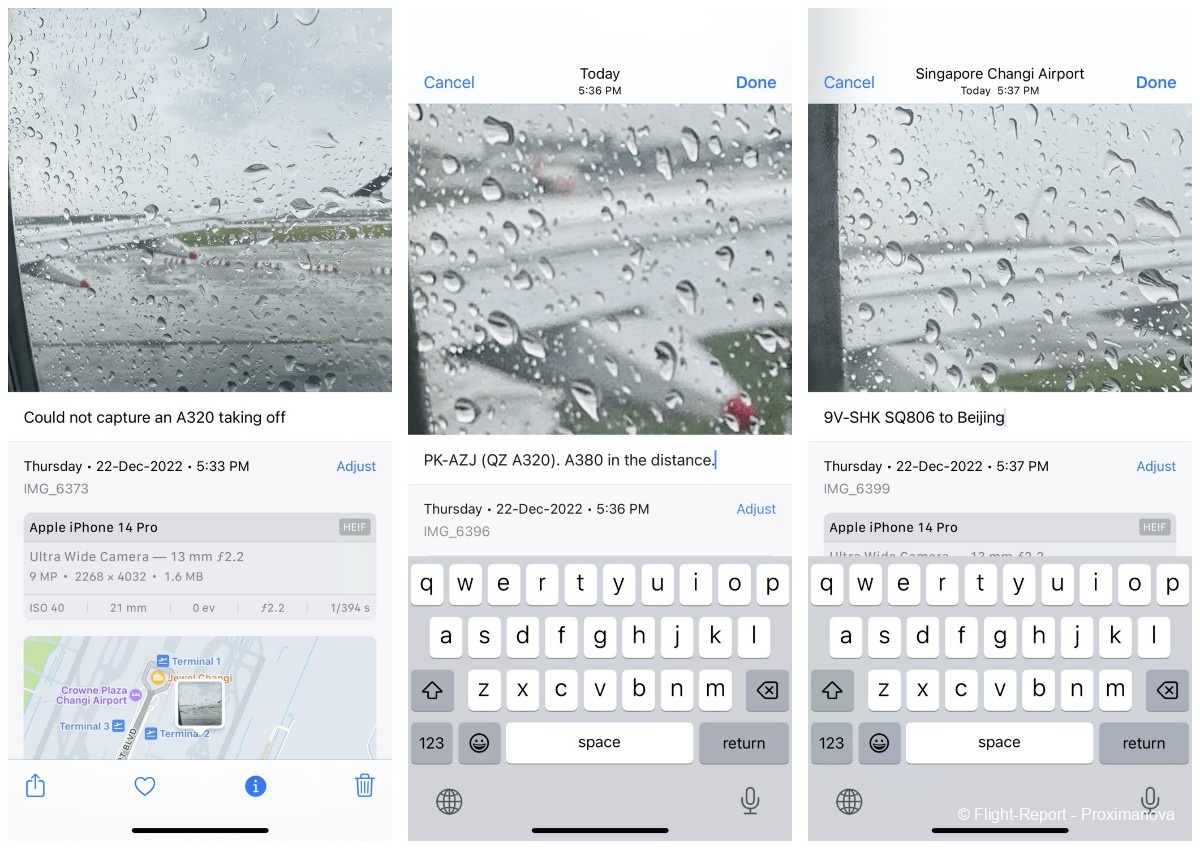
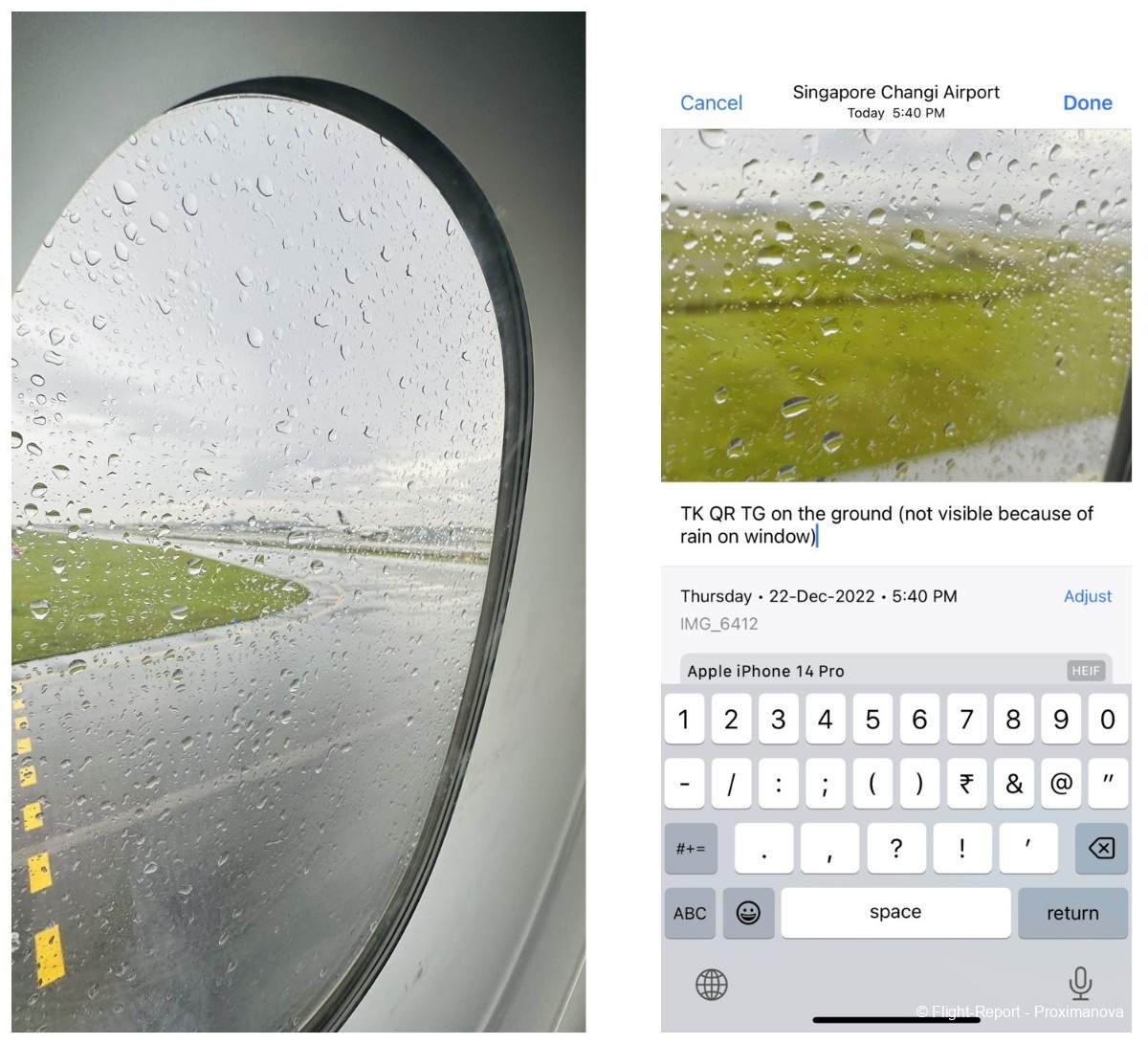
…to a very exotic aircraft indeed: what looked like a 757 from defunct Russian holiday carrier VIM Airlines, with its tail consisting of red sunburst-like strokes.
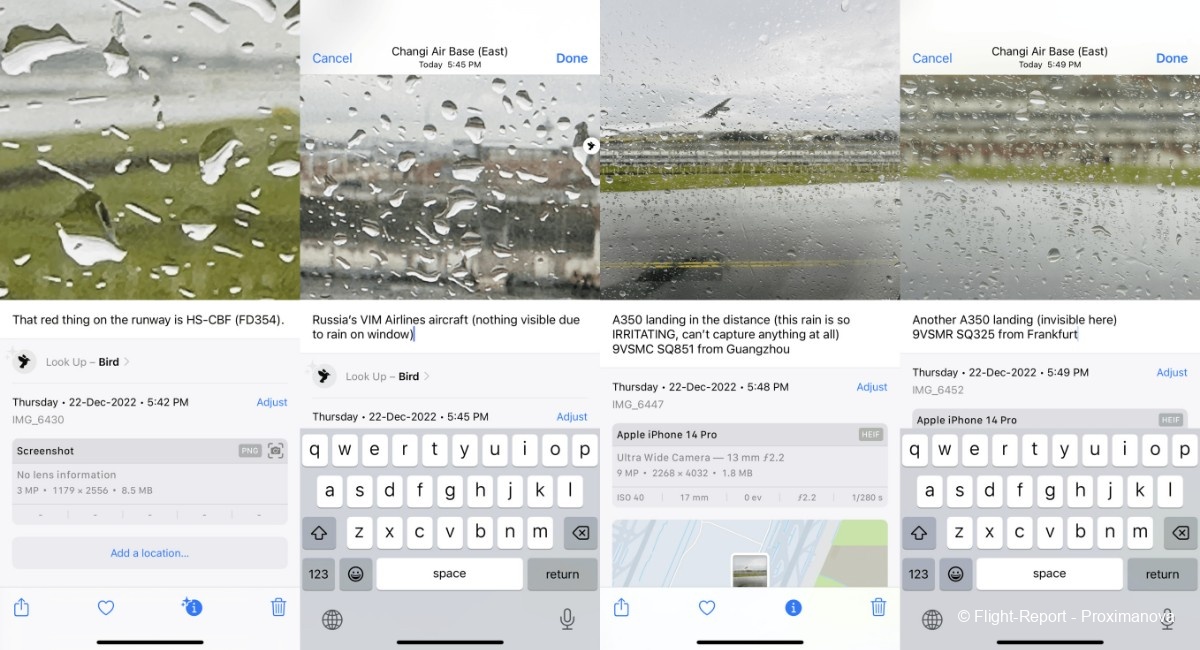
Our turn to take off came at 5:50pm, and Sharjah finally blasted off, the rain streaking the windows.
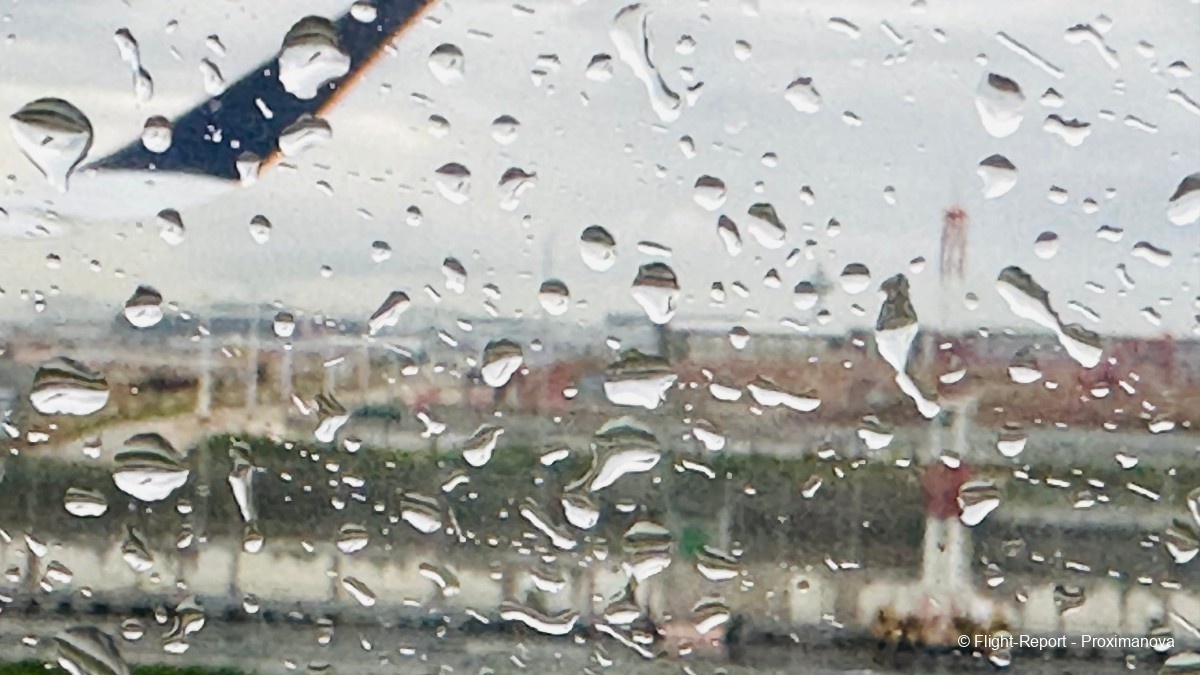
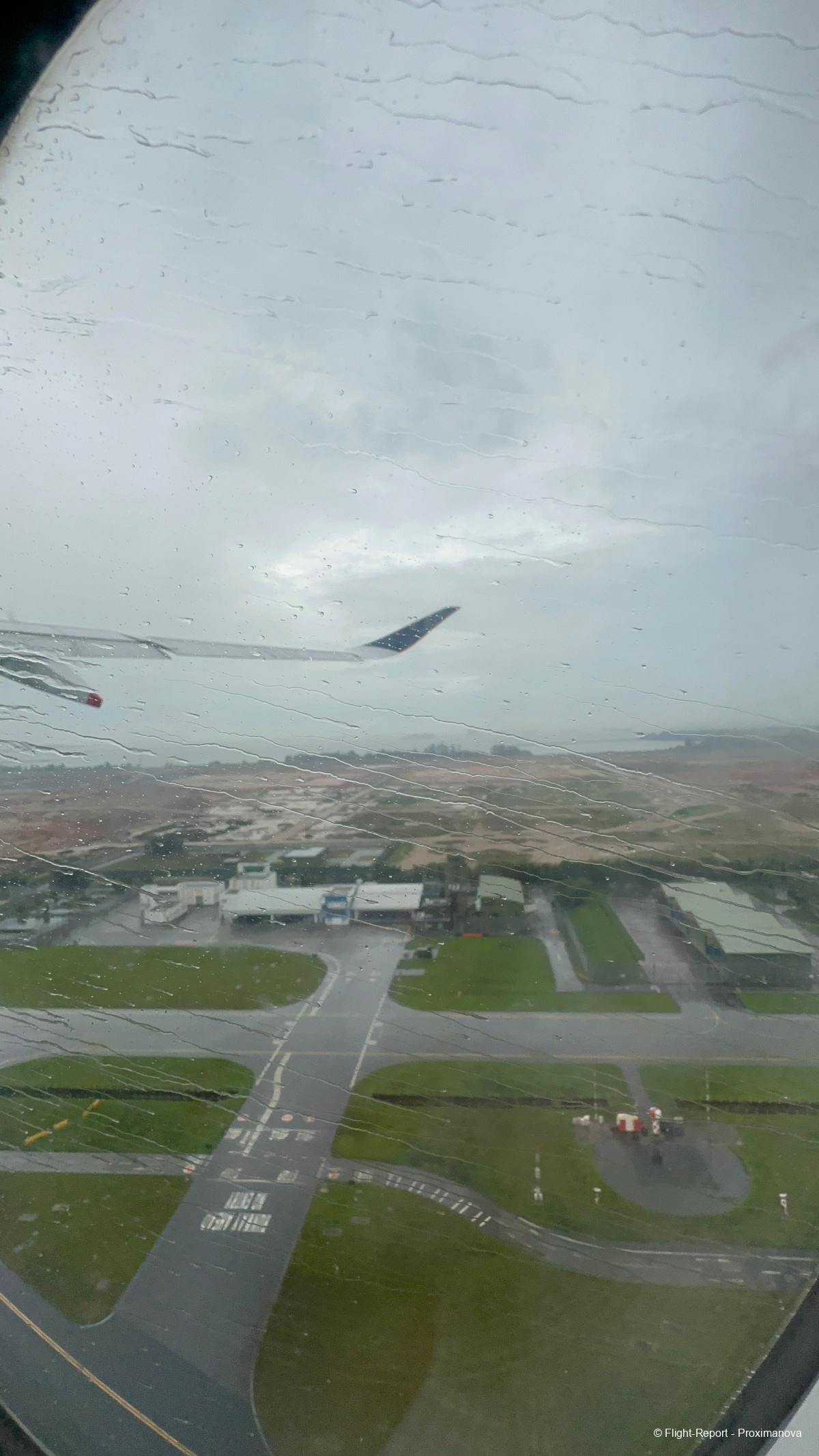
A minute or so later, the rain had ceased to matter, and the only thing that remained was the drumbeats and the fervour of We are One (Olé Olá), which I placed against the backdrop of the clear evening sky.
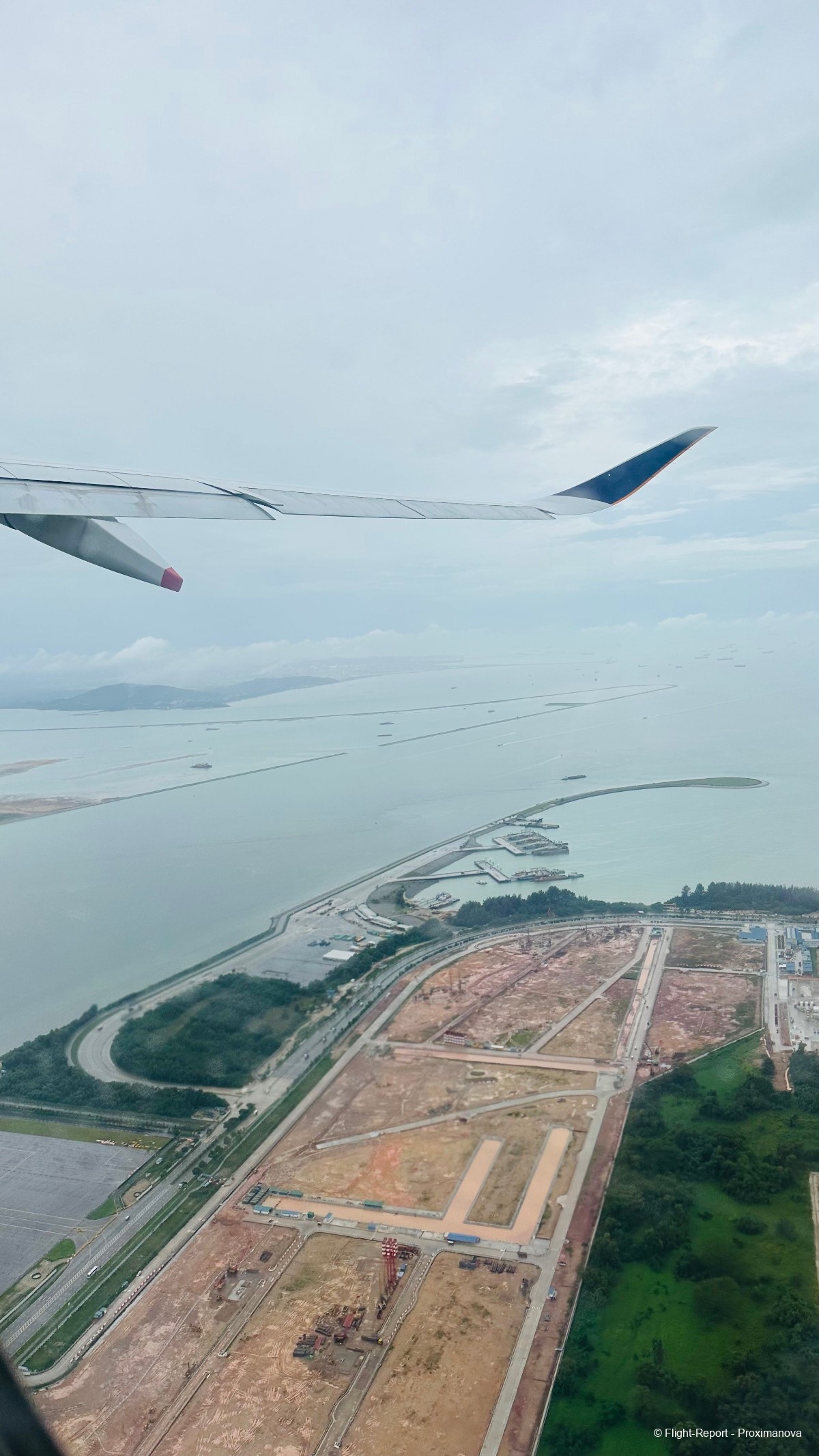
♪ Put your flags up in the sky, and wave them side to side / Show the world where you’re from, show the world we are one ♪

♪ Hey, hey, hey, força, força, come and sing with me / Hey, hey, hey, allez, allez, come shout aloud with me ♪
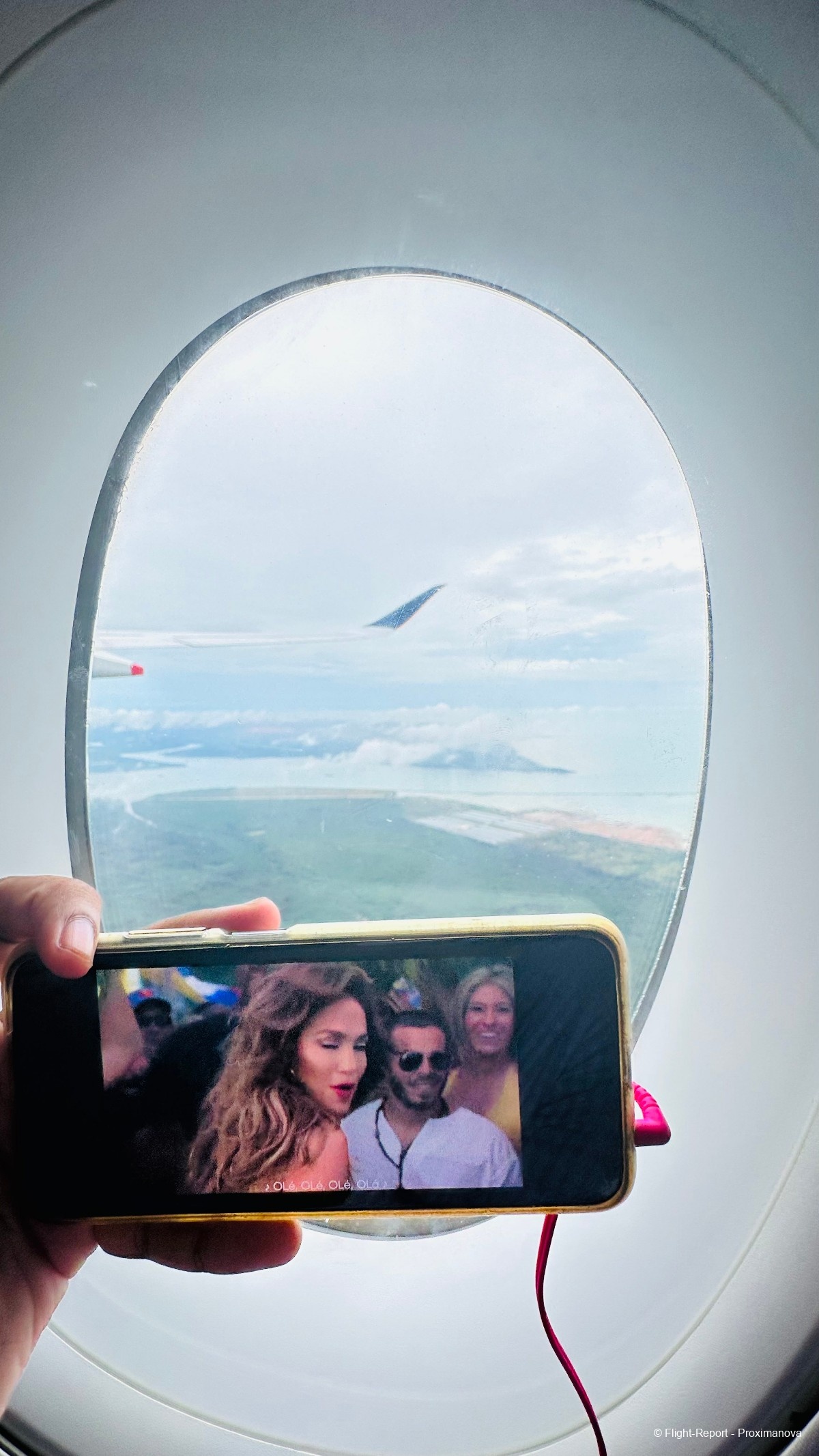
♪ Es mi mundo, tu mundo, el mundo de nosotros ♪ (It’s my world, your world, our world)
♪ Invitamos a todo el mundo a jugar con nosotros ♪ (We invite everybody to play with us)
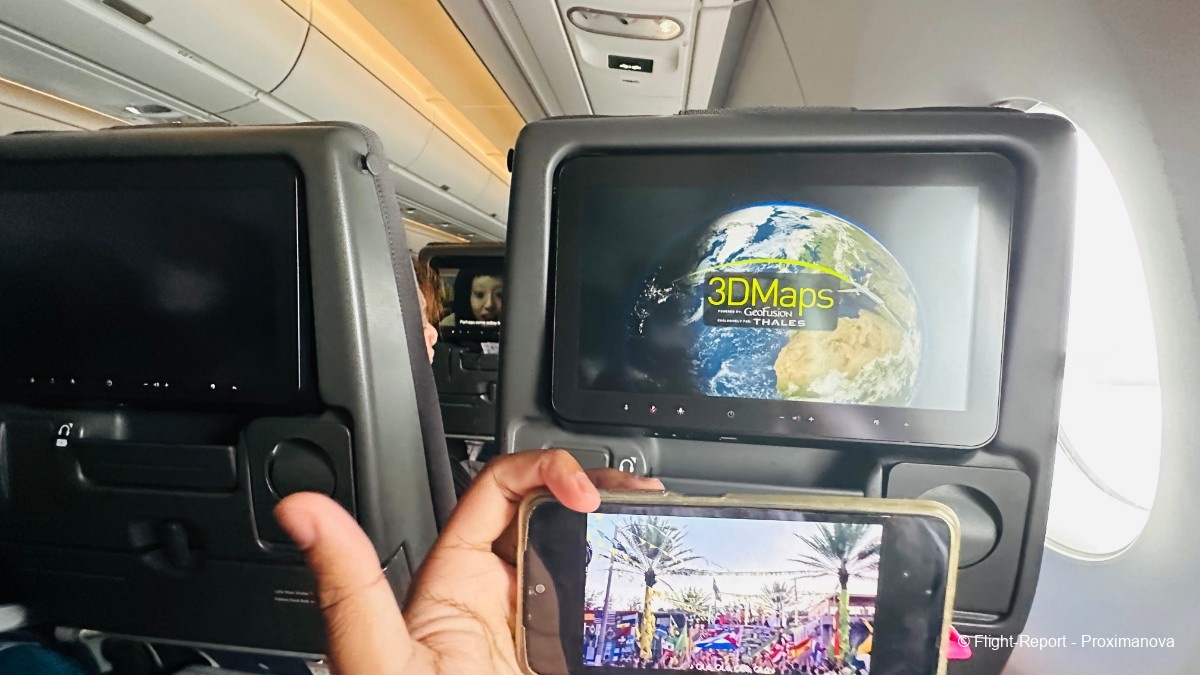
Catering: No es bueno!
I spent the next half-hour writing all about the ‘F and J’ coincidence that Sharjah was a continuation of. I‘ve said this before, but let me explain again, because this was simply too much of a coincidence:
• My first flight on Thai Airways, and the A350 overall, was on HS-THF; my second was on HS-THJ.
• My first flight on Emirates Airline, and the 777 overall, was on A6-EPF; my second was on A6-ENJ.
• My first flight on Singapore Airlines’ A350 was on 9V-SMF, and this one was 9V-SHJ.
What’s more, the first flight in each case felt like a first-class experience, while the second was J-class (business class) in that it was quite good but didn’t match up to the first. And so it would be this time around.
Of course, the whole right-hand page was filled with Argentina, Messi, the World Cup and this very song — and, on the top, the Tintin book.
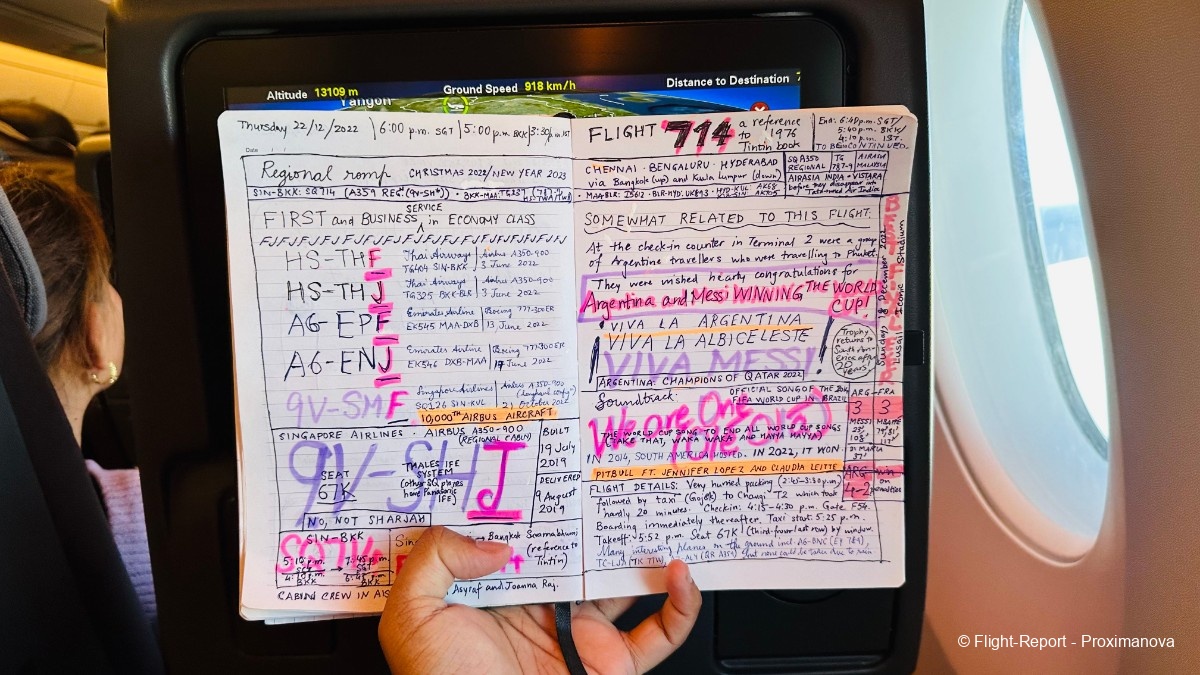
It woul be a good half-hour more — an hour into the two-hour flight — when the meal was served, and I must say this was really an underwhelming, disappointing meal. It shows how much regional flights like this have been a guinea-pig for SQ’s experimentation in supposedly eco-friendly but hard-to-use packaging, and suffered as a result.
That square meal box has been slammed by flyers, and for good reason: it gives the illusion that there isn’t as much food in it as in preceding rectangular containers, even though the quantity of food was the same. To add insult to injury, instead of the normal metal cutlery, the ‘sustainable’ ‘biodegradable’ bamboo spoon was on the verge of being unusable, as it was far too shallow to hold anything.
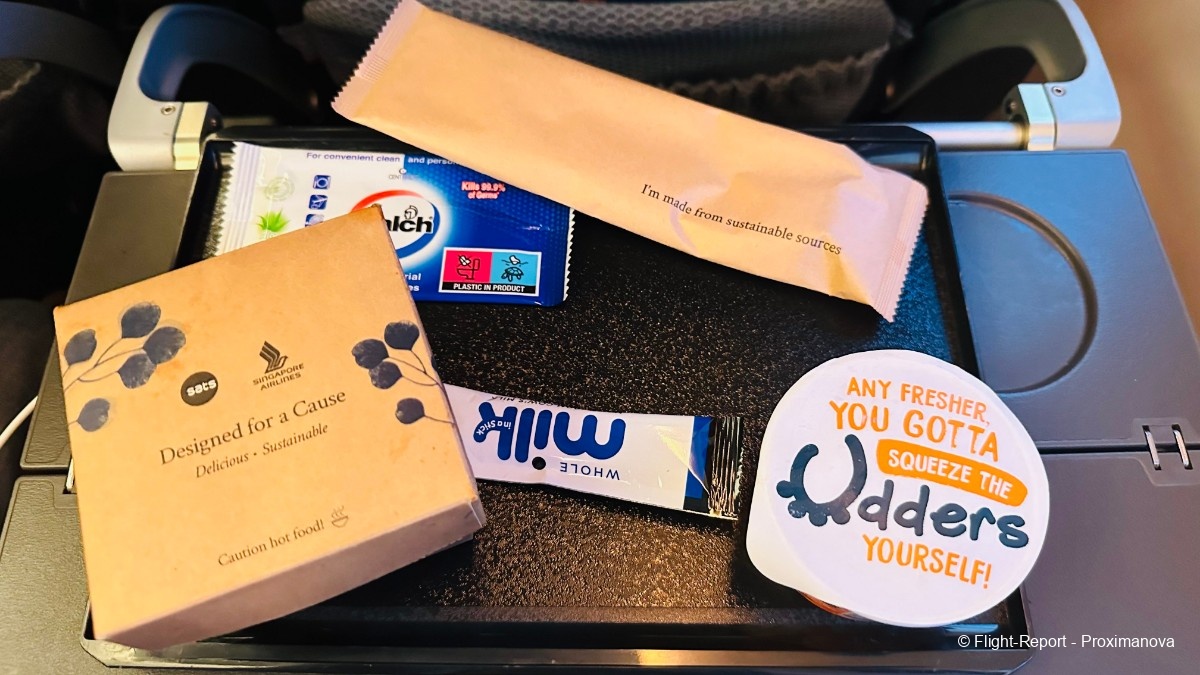
The contents were no better: chicken meatballs with mashed potatoes and vegetables braised in tomato sauce (meh), milk-in-a-stick (yuck) and chocolate ice-cream (ugh!). The one thing to my taste was the glass of 7-Up. At least there was no dry bread roll and butter on this evening sector that is always served on lunch or dinner flights.
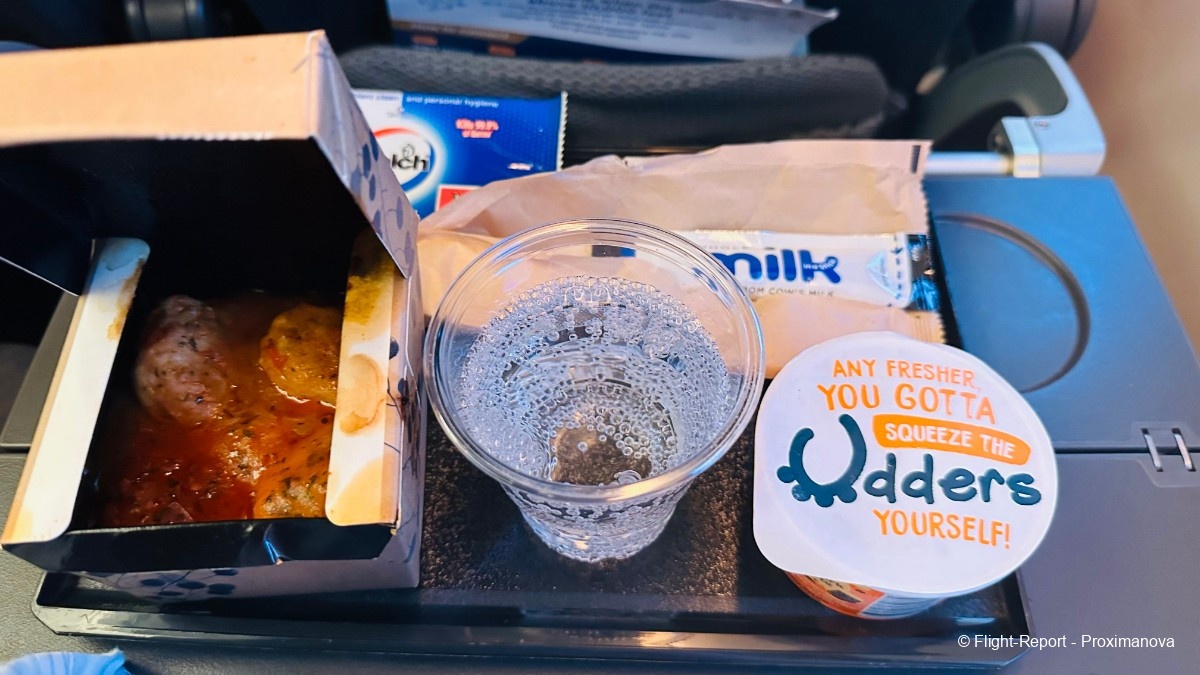
That Udders ice-cream was a real letdown, as neither was it Häagen-Dazs nor did it have the myriad flavours of the latter, from salted butter caramel to red velvet to Speculoos. Chocolate is best had in the form of slabs and toffees and bars, not as ice-cream. Fortunately, Udders redeemed itself with its French vanilla ice-cream on my recent flight to Bengaluru.
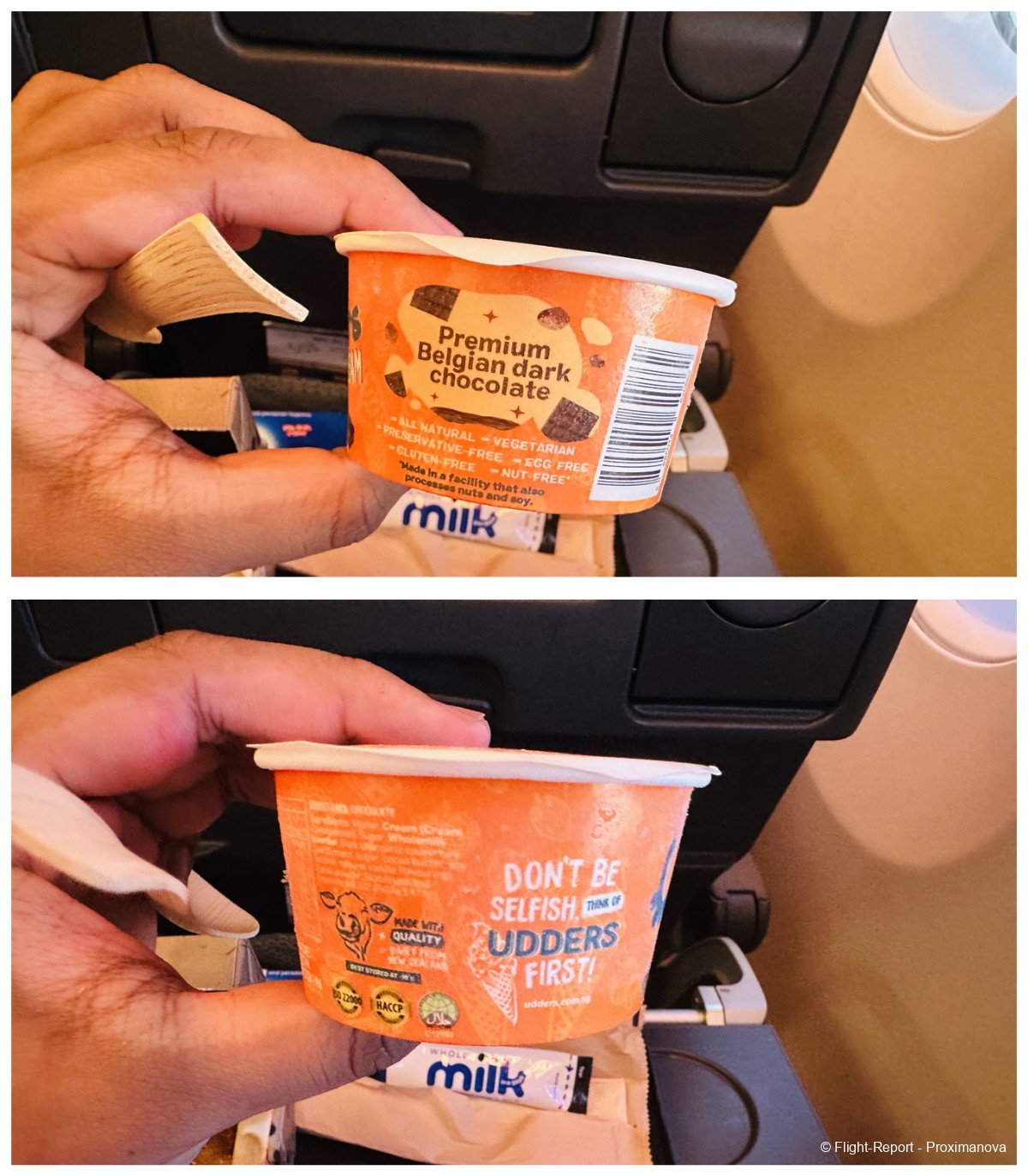
But who cared about the food when there was this glorious orange-pink display above the clouds for company?
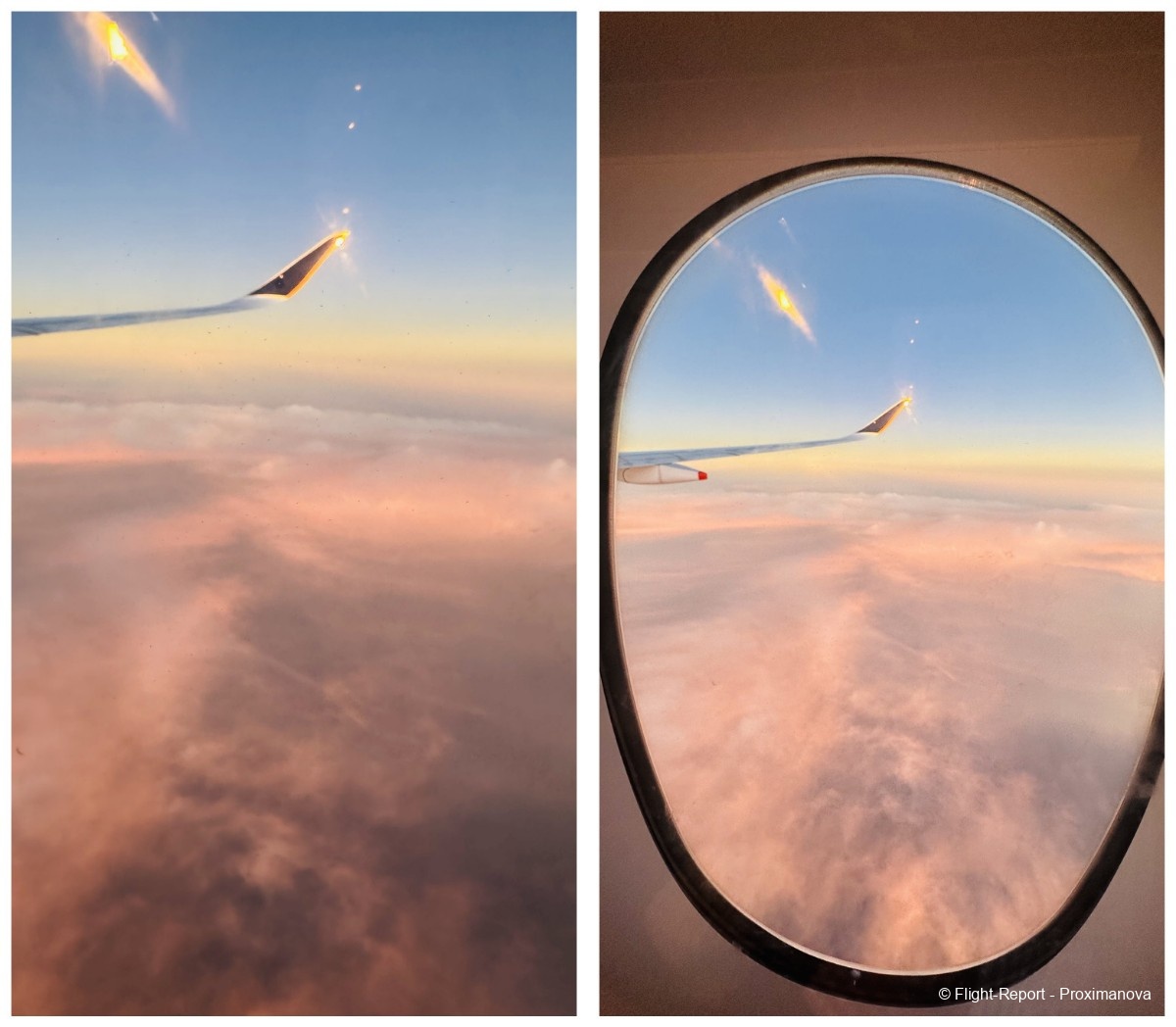
The cabin lighting was as brilliant and orange as the sunset itself!
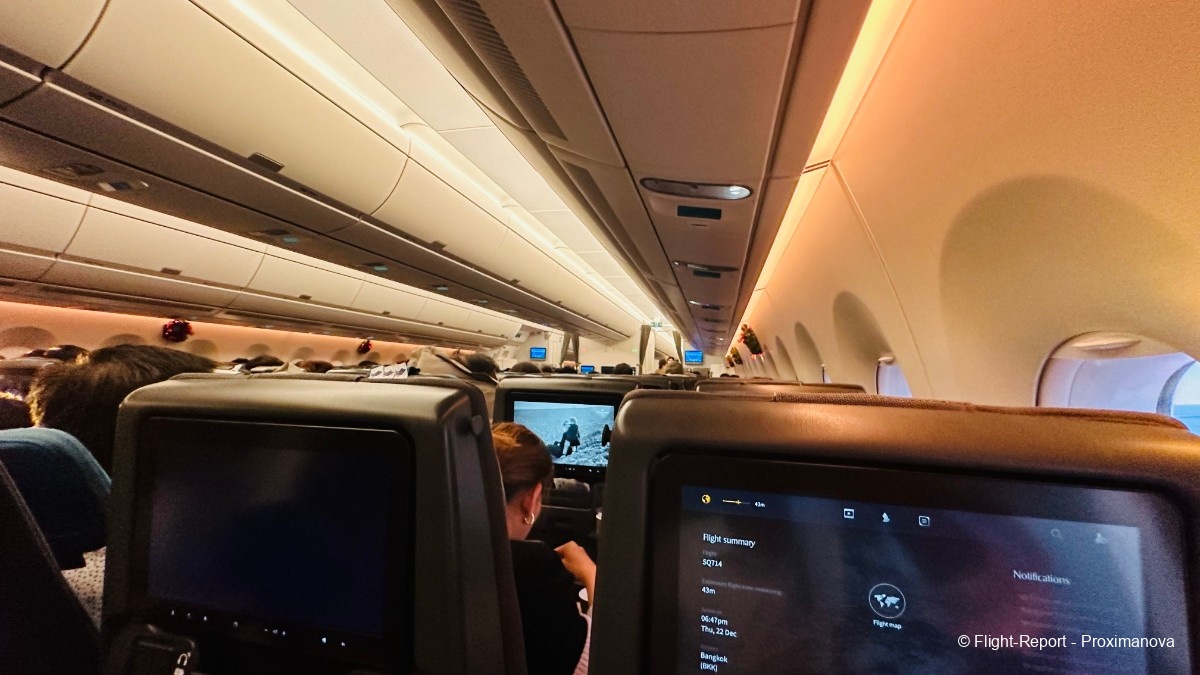
What’s life high without a little Wi-Fi?
The meal a distant memory, I tried my hand at the Wi-Fi portal, which I have never been able to connect to on the Panasonic-equipped 787-10 and A350 Longhaul. Would SITA OnAir (which, sadly, is prohibited over Indian airspace) do the trick this time around? It did!
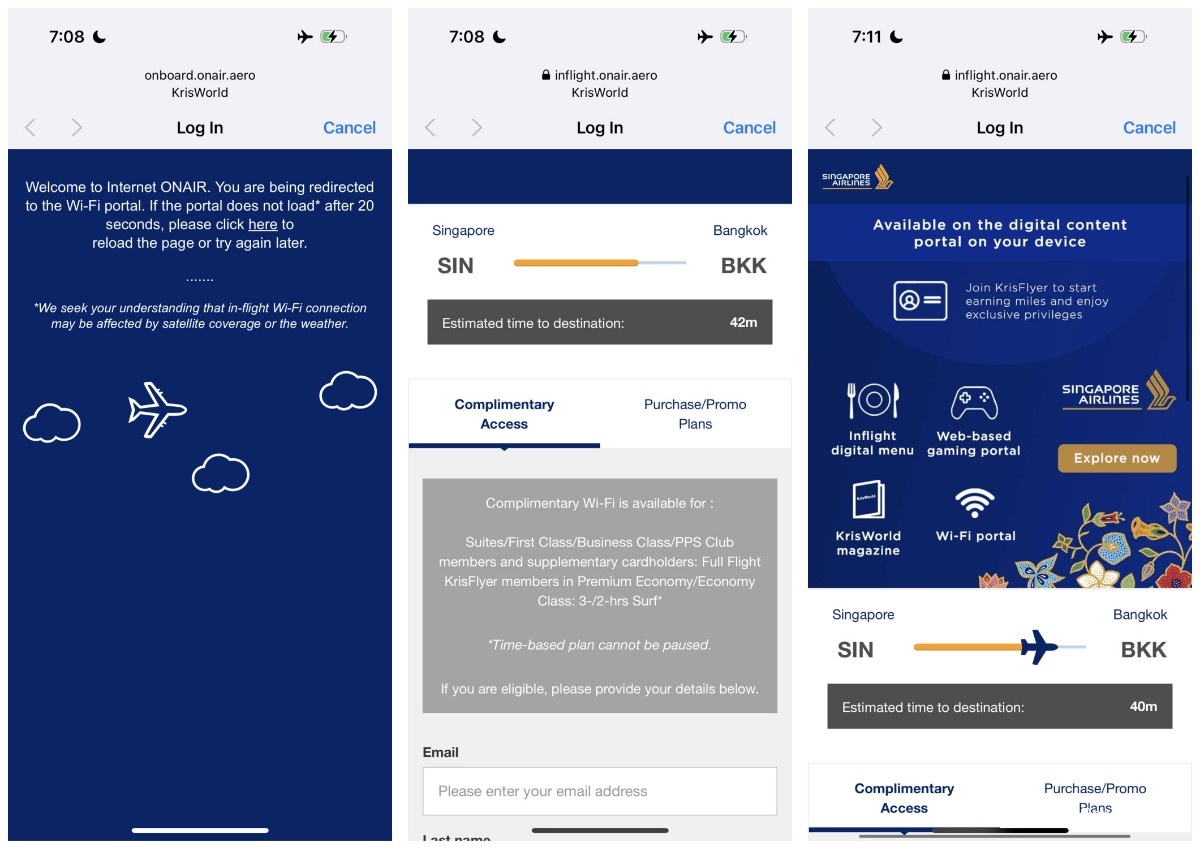
Until June 2023 free Wi-Fi has been offered to all KrisFlyer members in economy for two hours, and in premium economy for three. However, SQ is taking it to the next level come July, with FREE and UNLIMITED Wi-Fi for ALL passengers who are at least KrisFlyer members, let alone in premium cabins — no data or time caps! Isn’t that industry-leading?
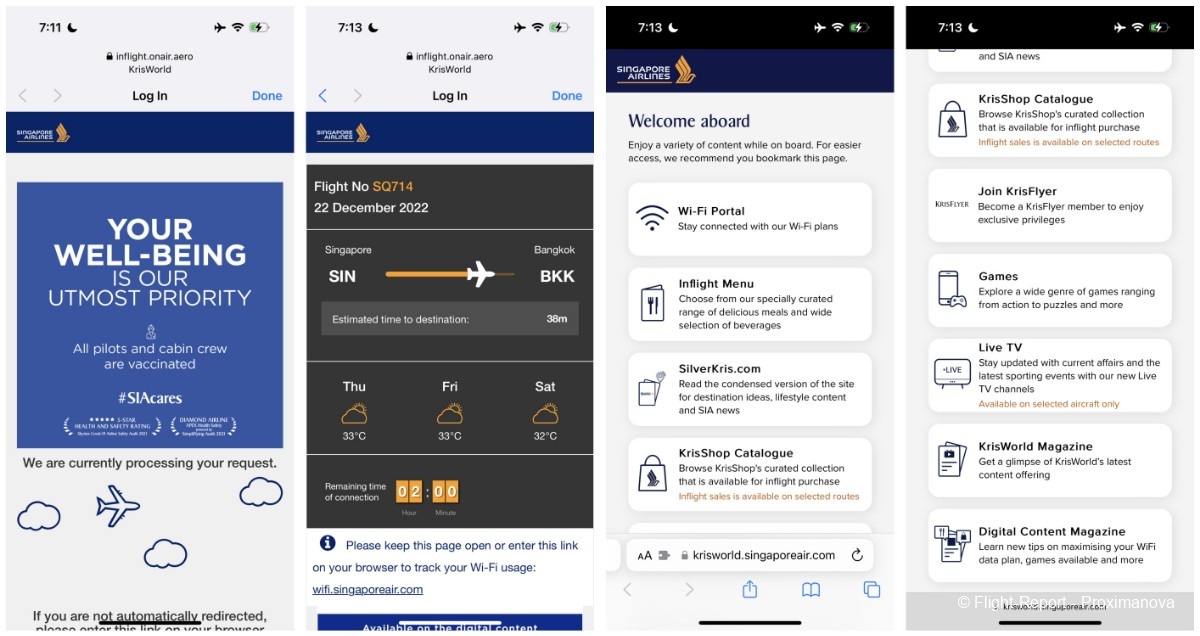
Fittingly, it was at 7:14pm that I had a look at the underwhelming meal selection and the estimated time left.
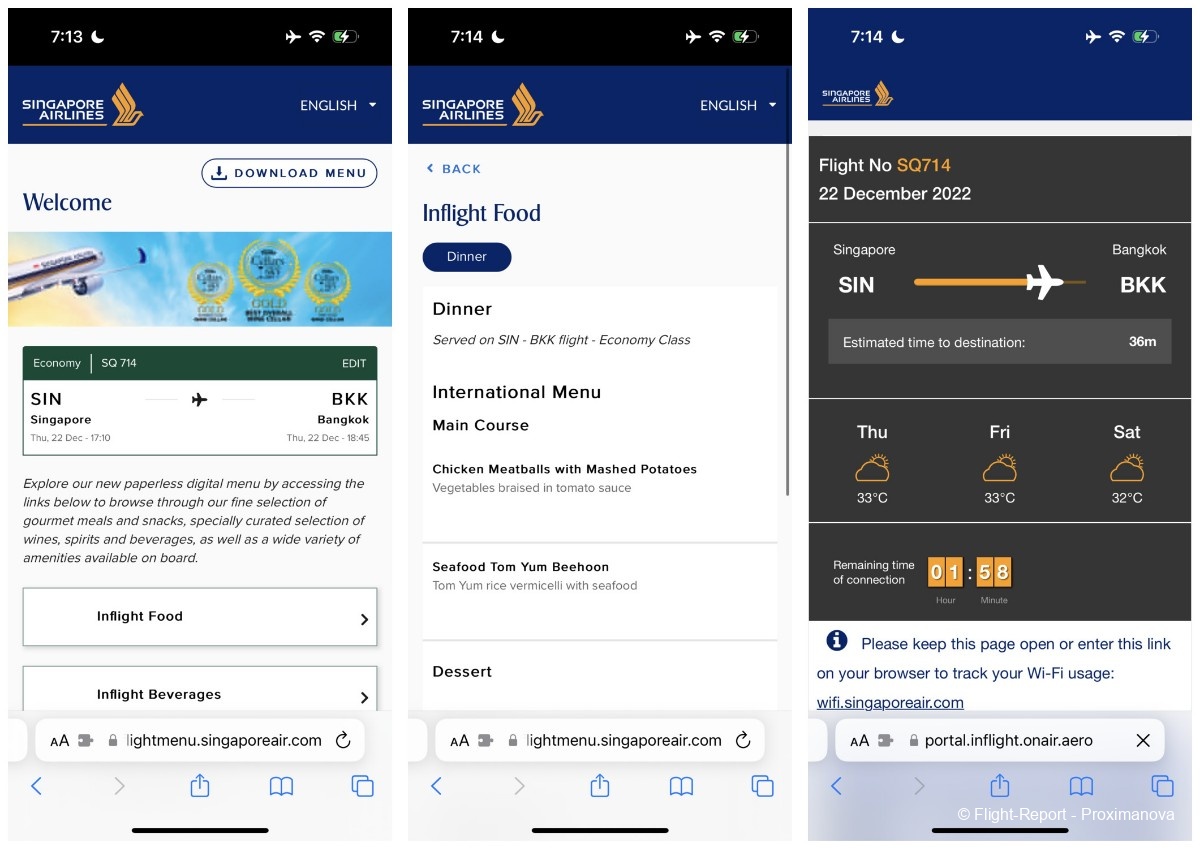
SQ also had a guide to inflight entertainment and connectivity, which has historically been better on aircraft with Panasonic equipment — like the 787-10 — than others. As I said, the A350 Regional is the only aircraft where neither the IFE nor the Wi-Fi is from Panasonic.
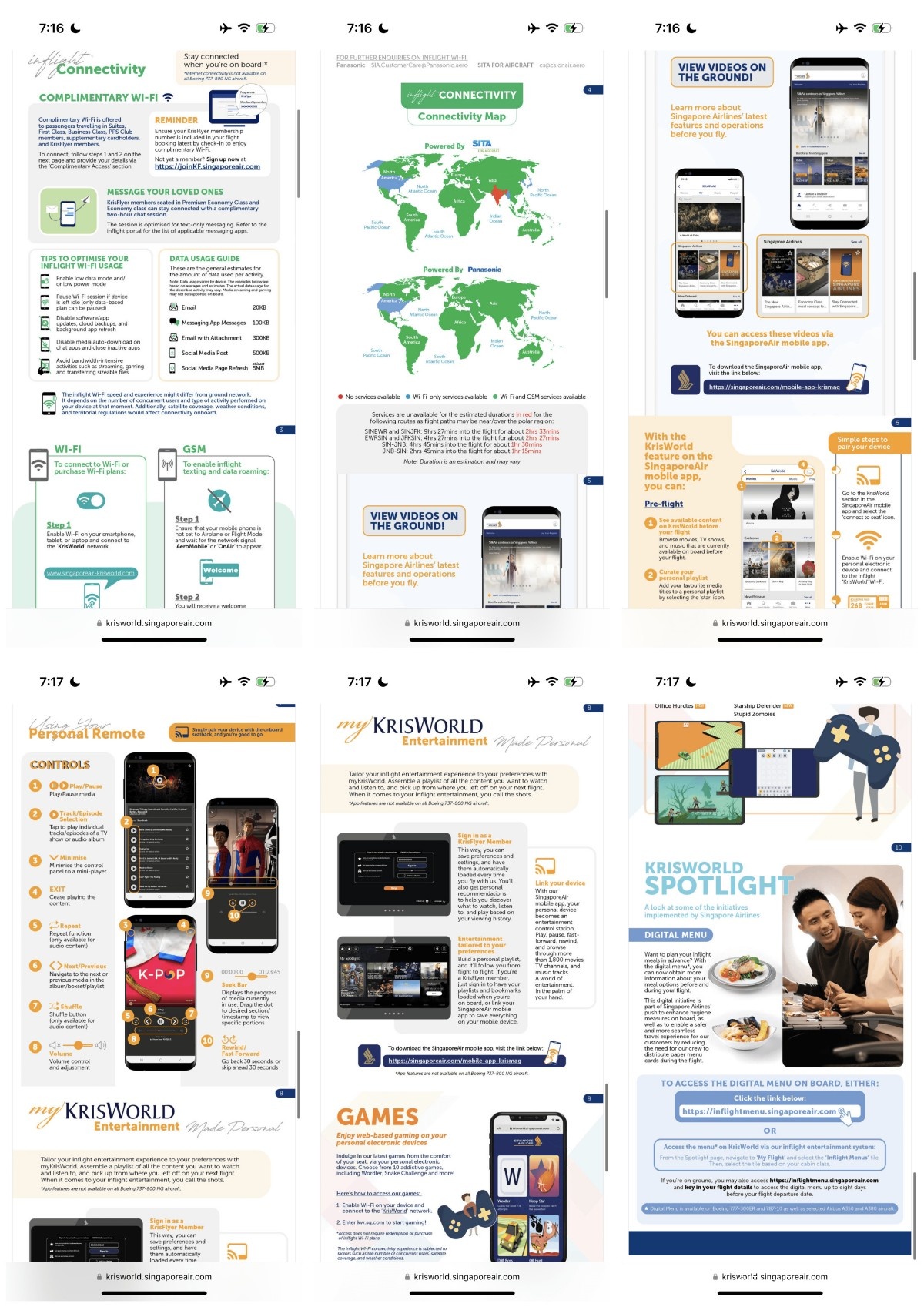
SQ additionally makes its SilverKris travel portal accessible from the Wi-Fi access screen. While nice and all, there’s little point having a website for an inflight magazine that doesn’t even exist any more — or, rather, refuses to return to existence, unlike say Malaysia Airlines’ Going Places or Ethiopian’s Selamta which have made a nice postpandemic comeback.
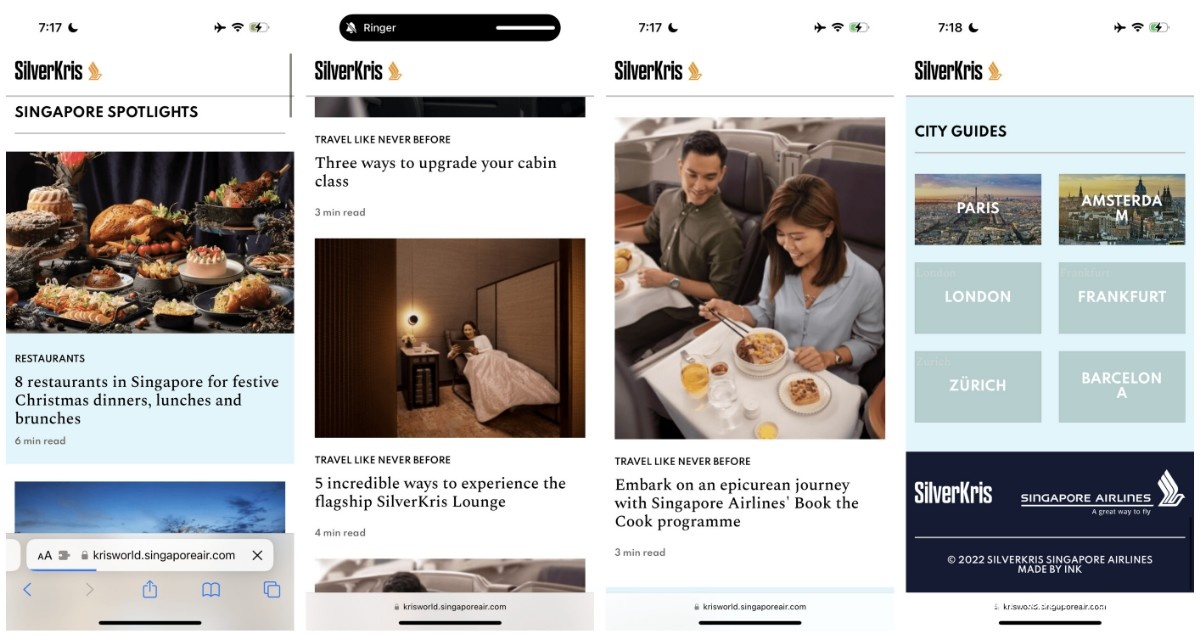
I wasted no time in tracking our flight on Flightradar24, something that is always super cool to do!
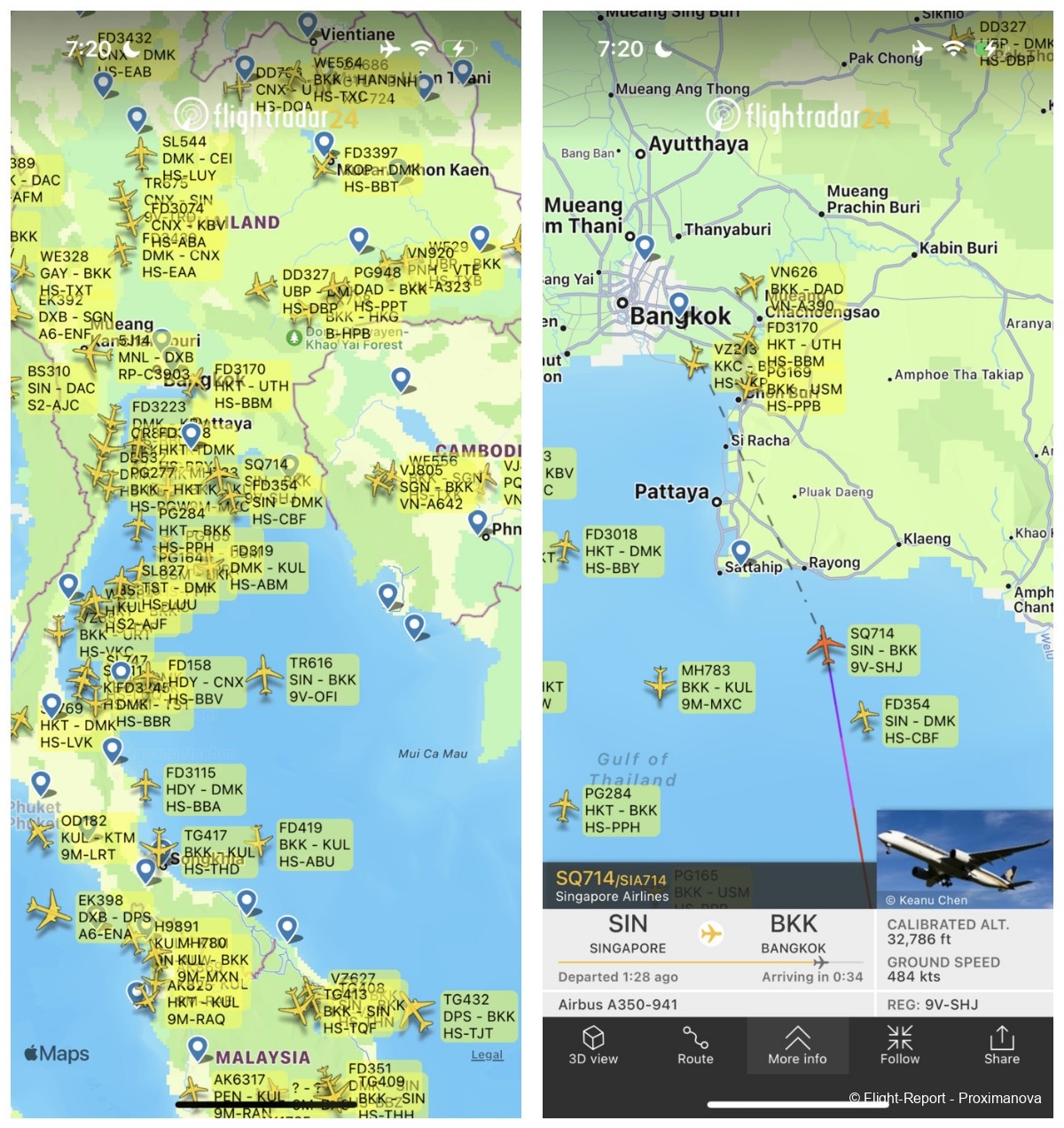
Finally came the KrisShop duty-free guide, and I wonder why SQ persists with a physical shopping magazine when it has no intention to bring back its far more useful and widely read SilverKris magazine.
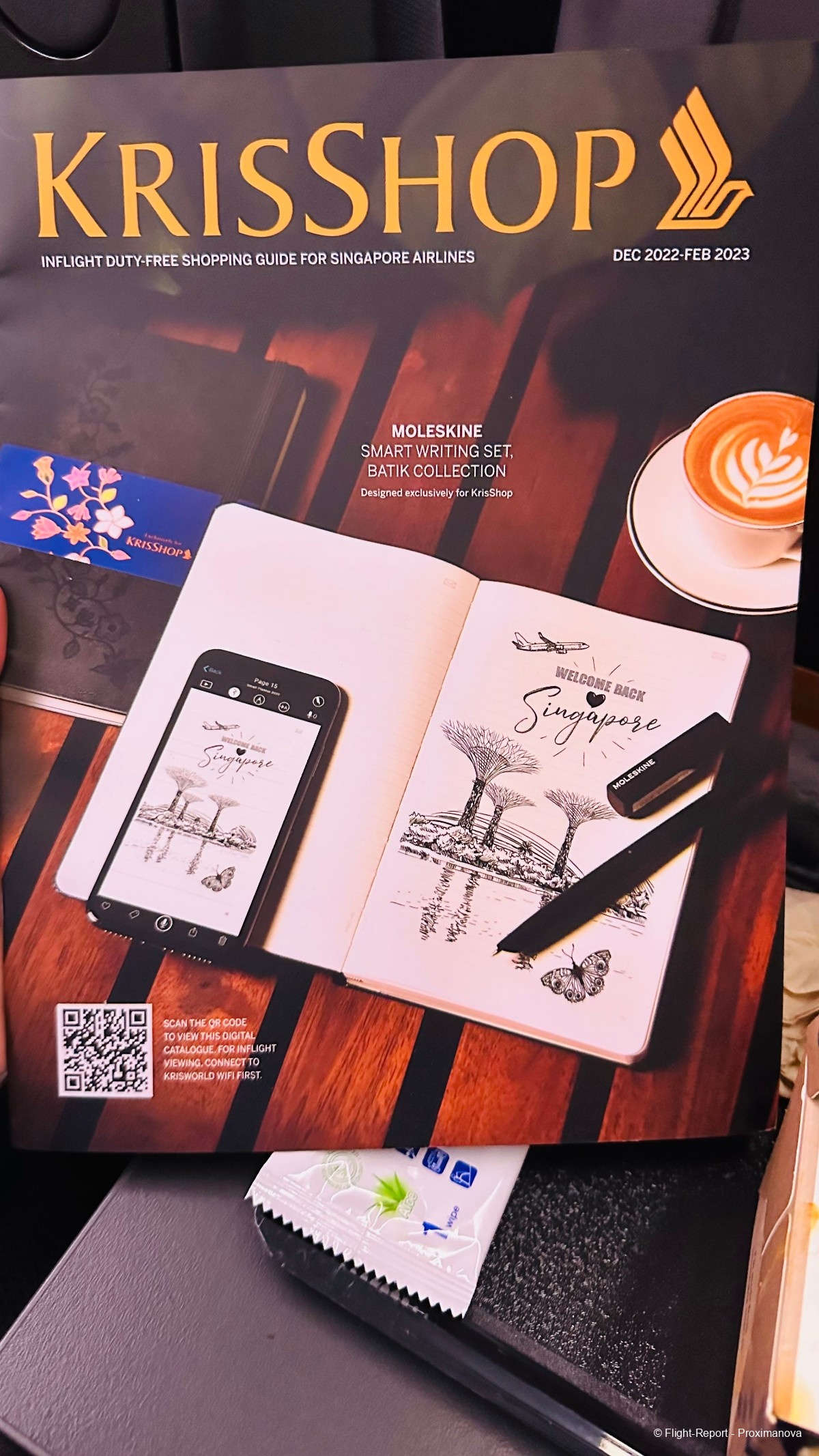
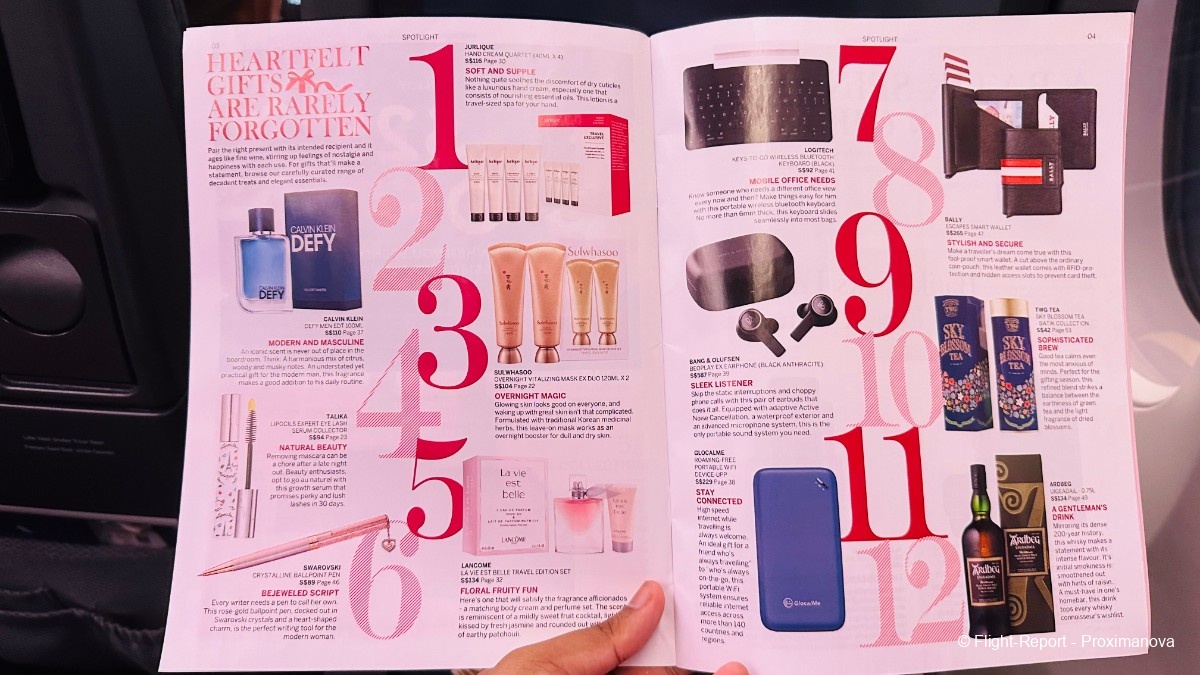
If anything, the only thing I’d buy from here is the model A350 plane. Well, and the Kris Junior Jumble Mouse if I were a decade younger, or the Hello Kitty set if I were a girl!
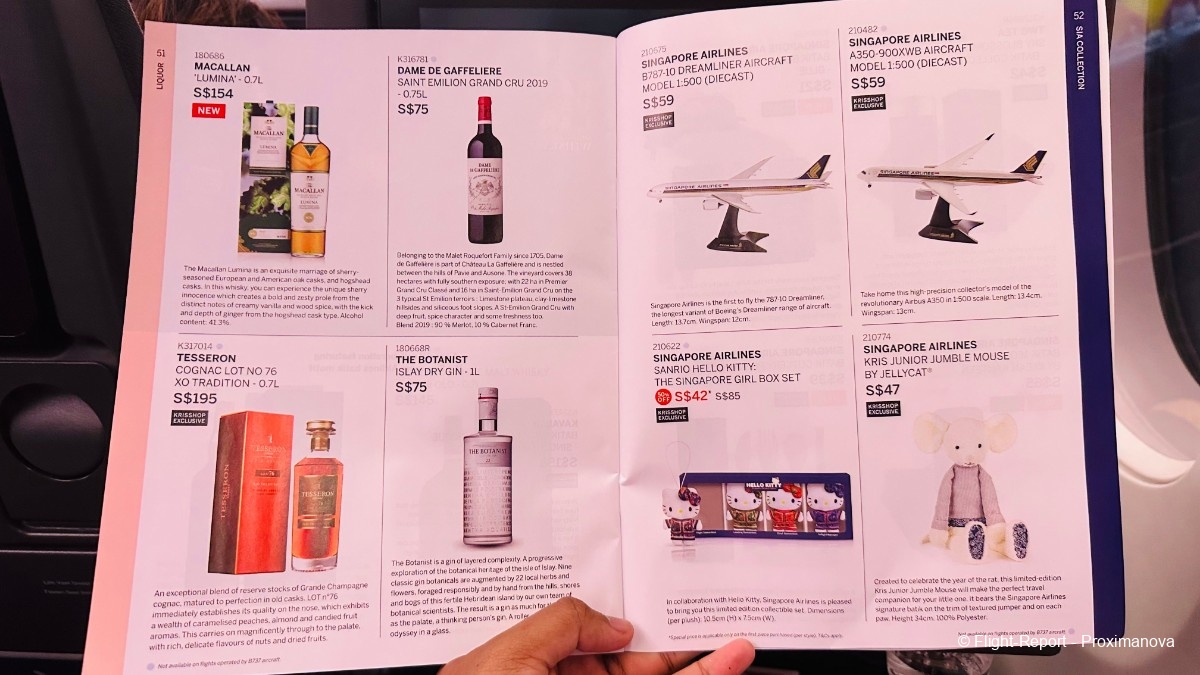
Descent at dusk
This is where, with some 20 minutes remaining, I finally unplugged the Brazilian beat and decided to check out the Bollywood flavour of the month. I recollected having enjoyed Chandigarh Kare Aashiqui (2021), released the previous December during the Omicron phase (who even remembers that now?), and decided to watch the title song at the end if nothing else. The film is a social-message movie — the lead onscreen female character is transgender — rolled into a sports drama, in the guise of a typical over-the-top Punjabi setting.
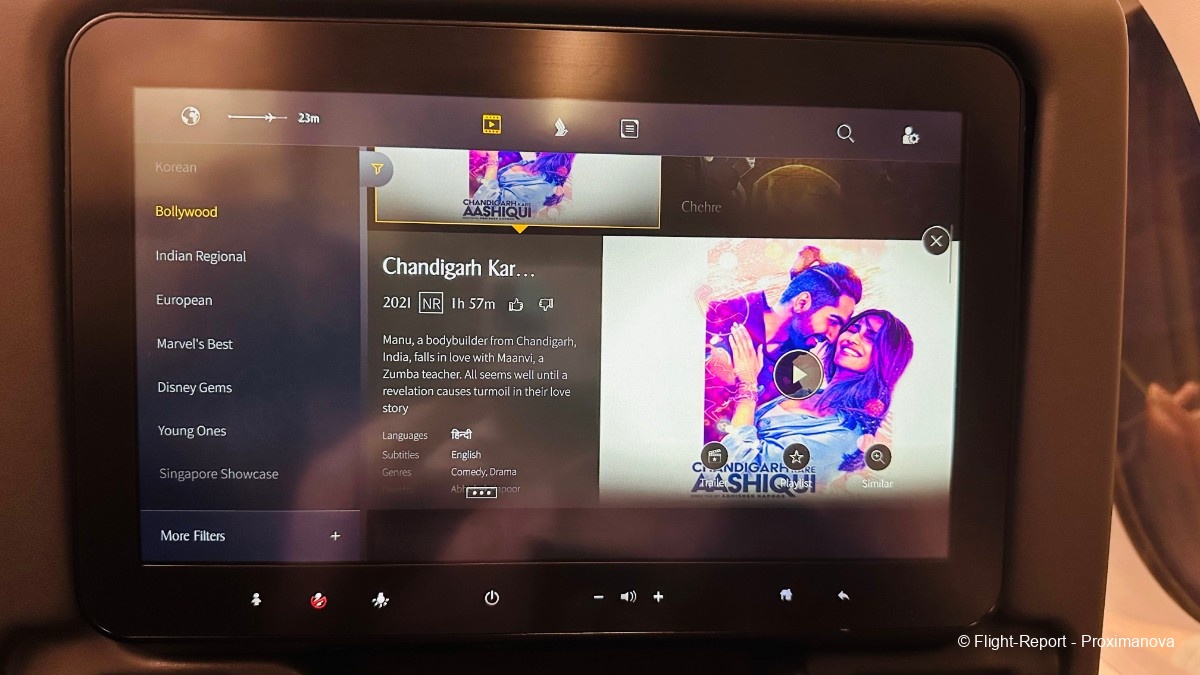
But you don’t fly extravagant luxury airlines without being force-fed advertisements for aspirational luxury products that are shoved down your throat, such as this woman-driven ad for Patek Philippe…
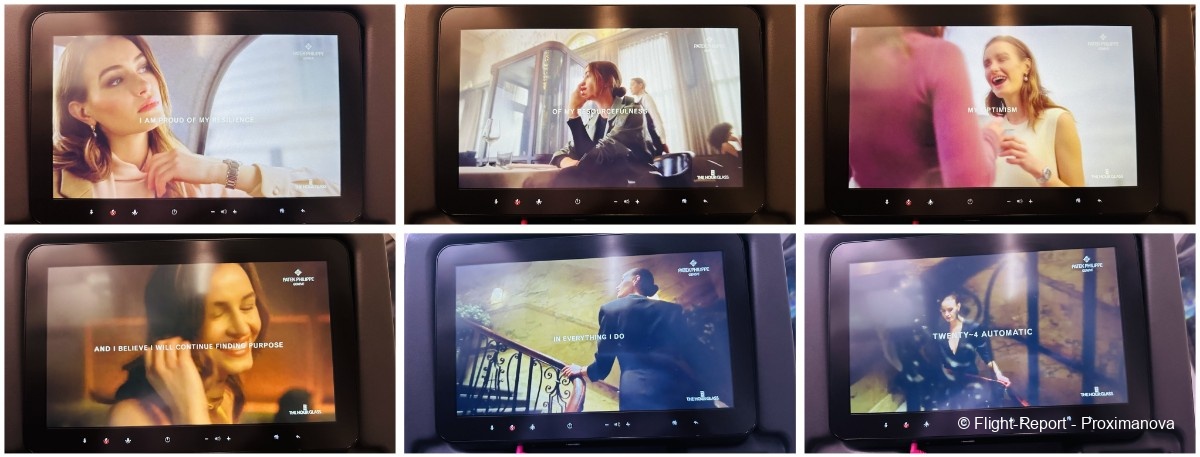
…followed by another Helvetic horologist, Hublot, plus a couple of SQ ads promoting its Pelago app (ugh, Montserrat) and COVID-19 precautional practices.

The film began with a tribute — ‘Stay Interstellar’ it said — to a young Bollywood actor who ended his life three Junes ago, which resulted in a media storm far more potent than the pandemic. But I wasn’t here for that.

I jumped to the end credits scene, the peppy Punjabi title song being a good representation of perhaps India’s most well-known music industry after the Hindi one.
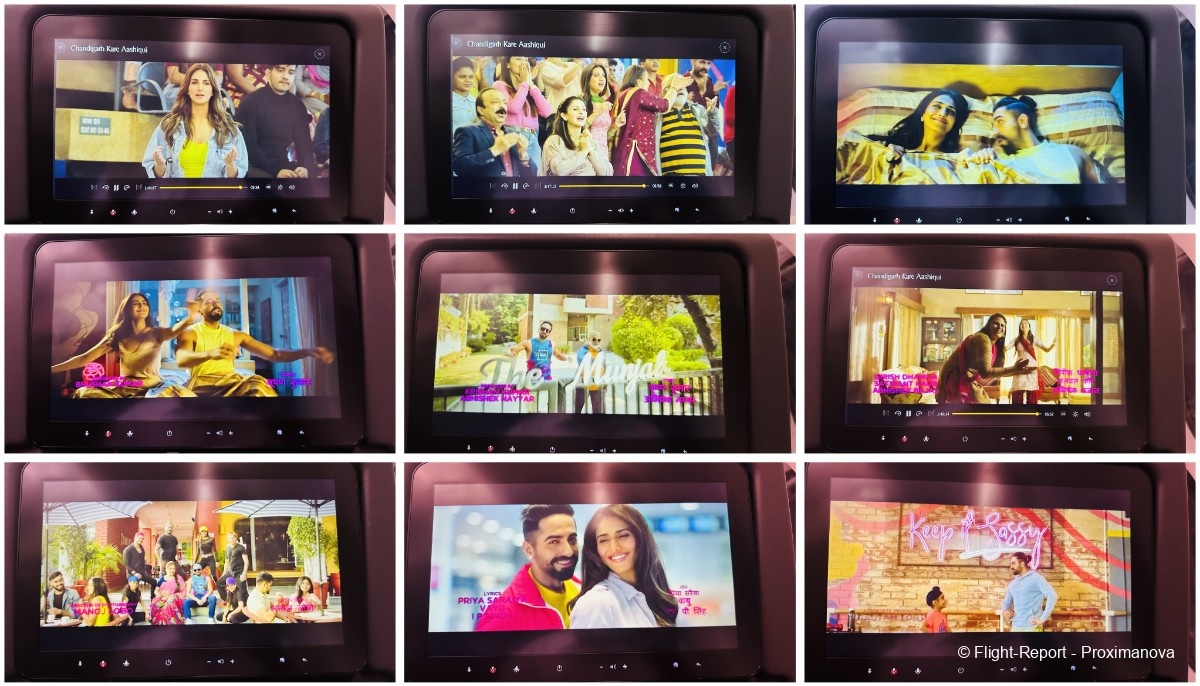
Touchdown: Thai Christmas gifts that Changi can’t give you
Meanwhile we were on short final to Suvarnabhumi Airport, with KrisWorld as always showing a notice for the odd forgetful soul.
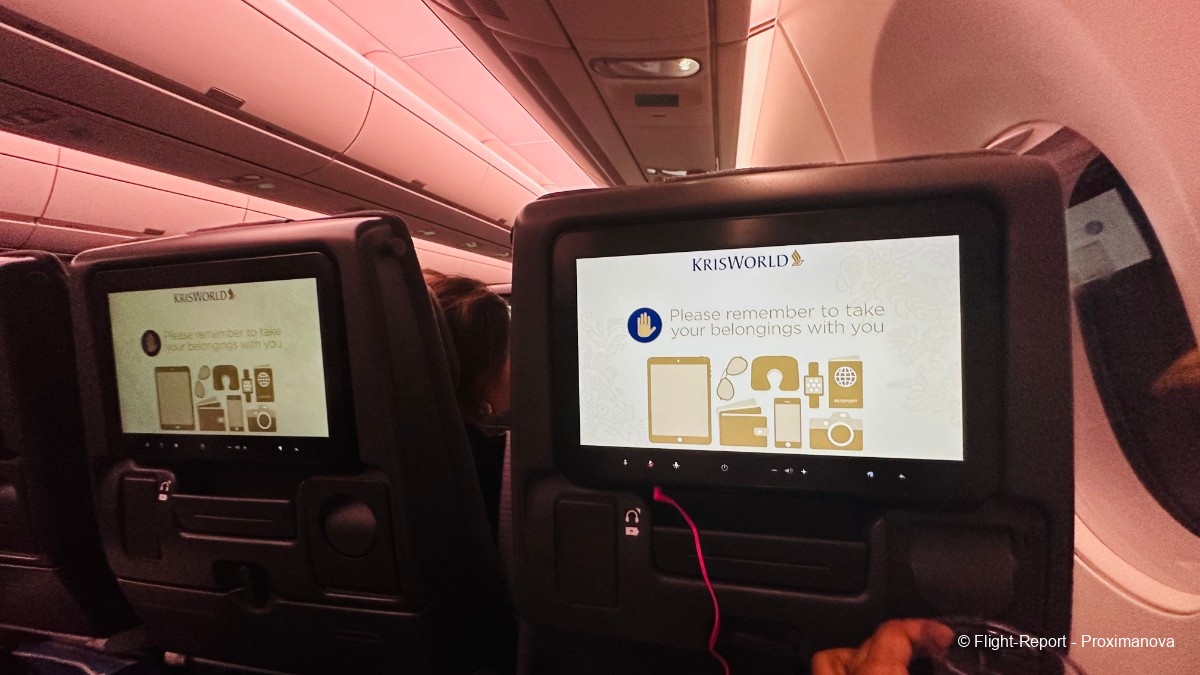
Brilliantly lighting up the night were the many roads and one river of Bangkok.

Alongside us was a Qantas Airways A330-300 (VH-QPI) that had taken off and was bound for Sydney. This is the very airline and destination that Flight 714 in the original book had.
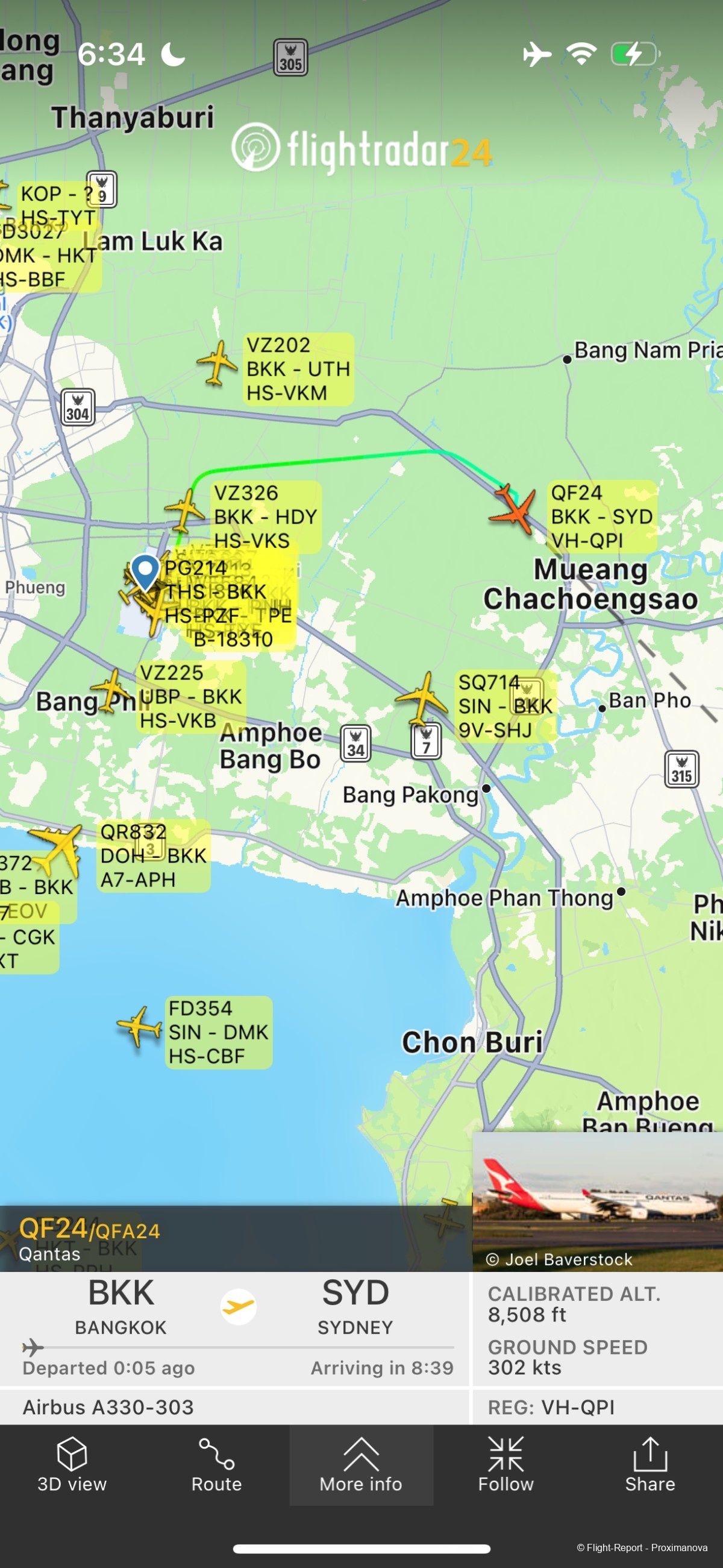
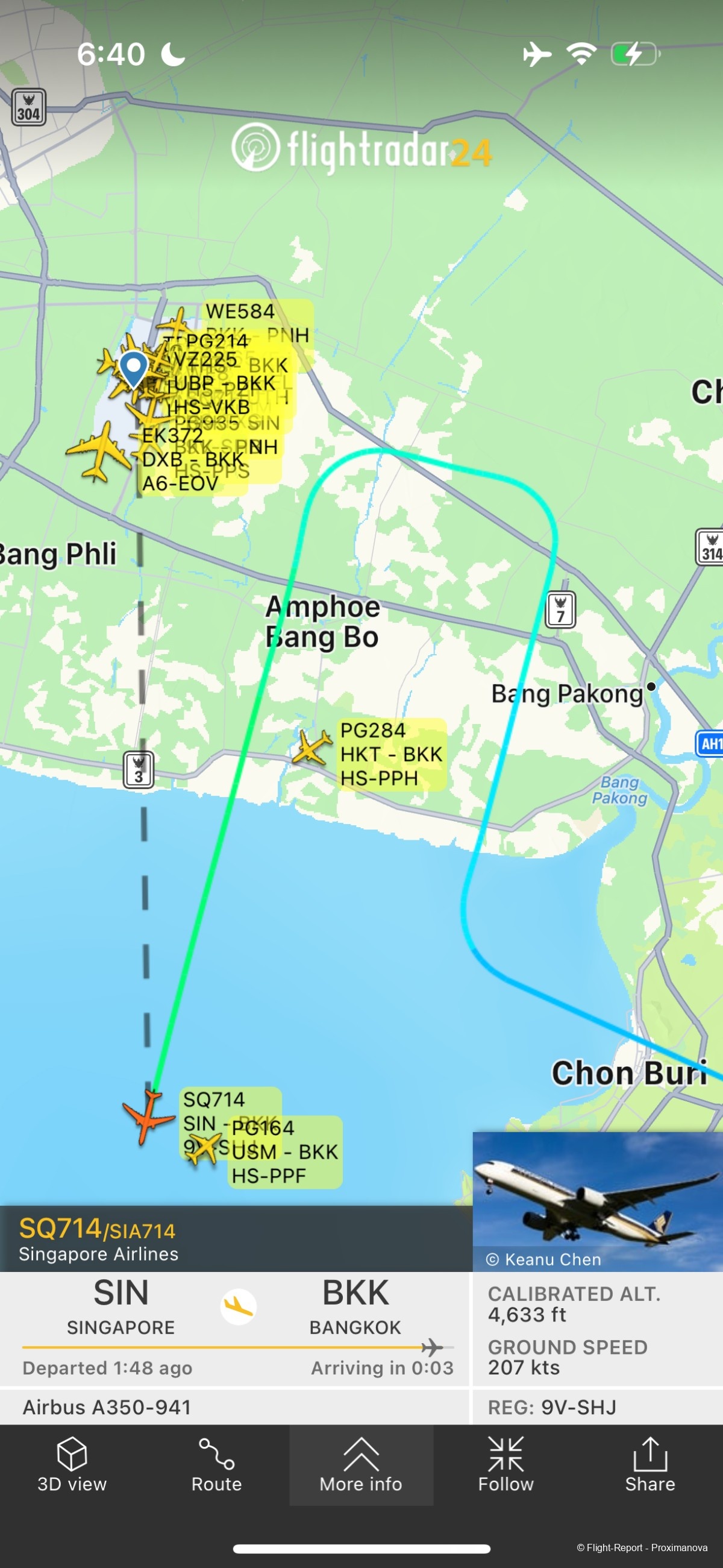
The cabin lights had been dimmed in preparation for landing.
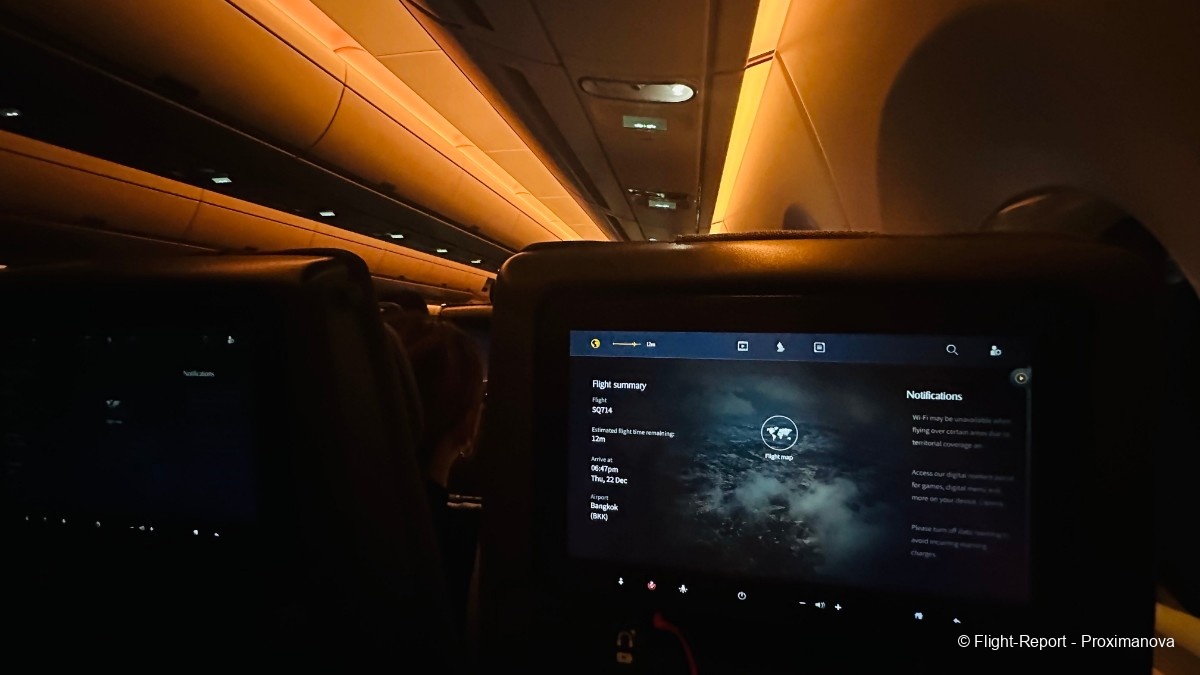
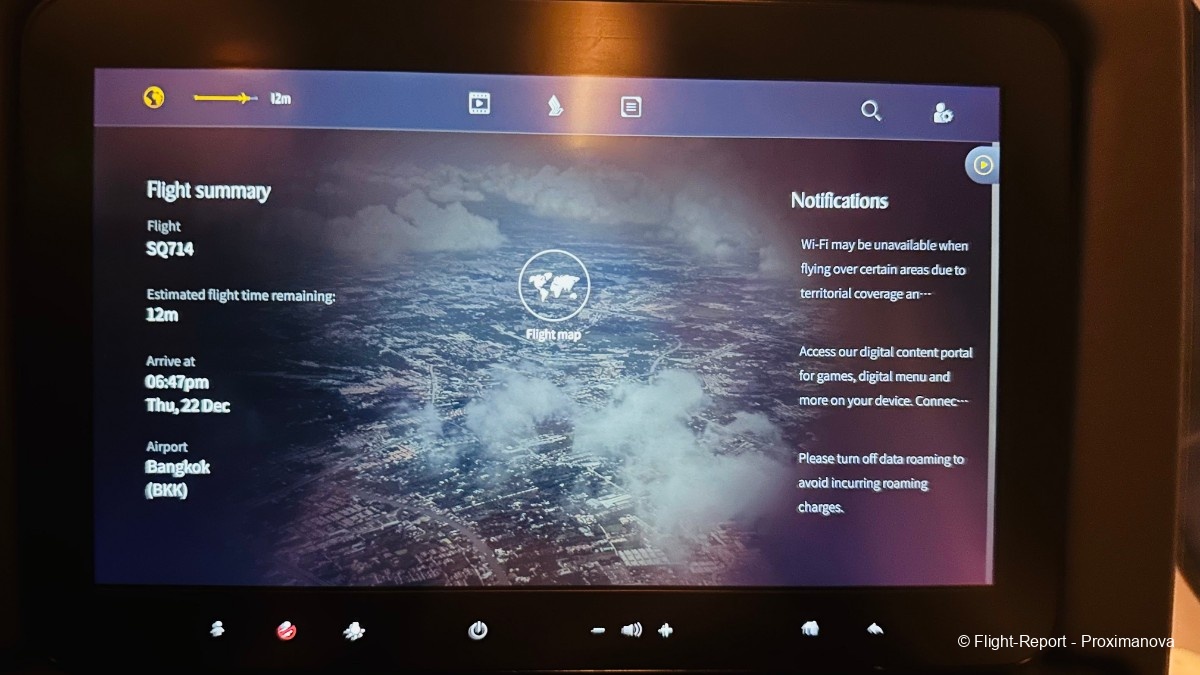
Now I was treated to a darker and even more spectacular version of a sunset above the skies, with luminous crisscrosses below.
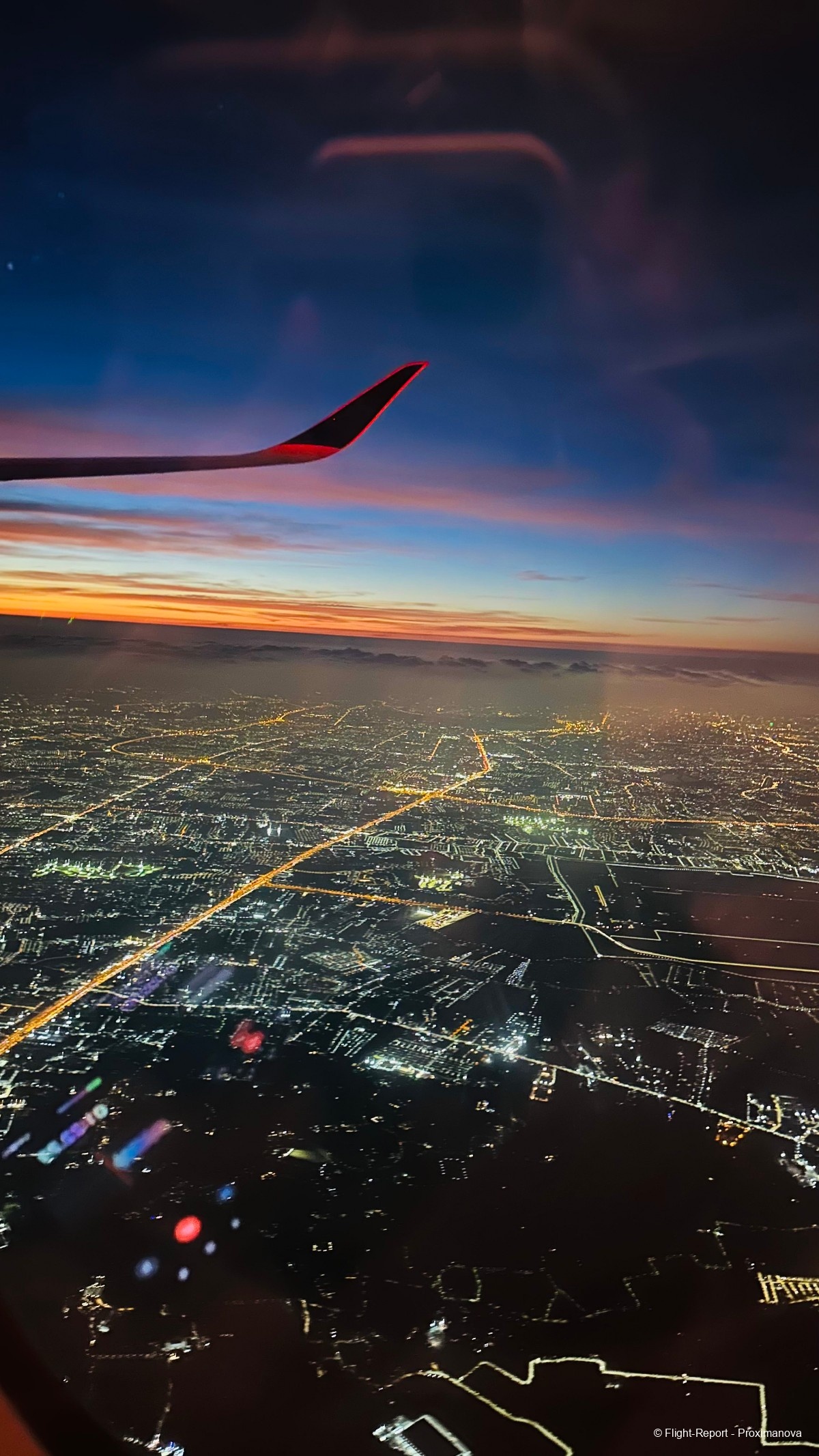
It was simply a sight to behold. Too bad SQ A350s don’t have tail cameras: if this were TG, I would have been glued to them every second.
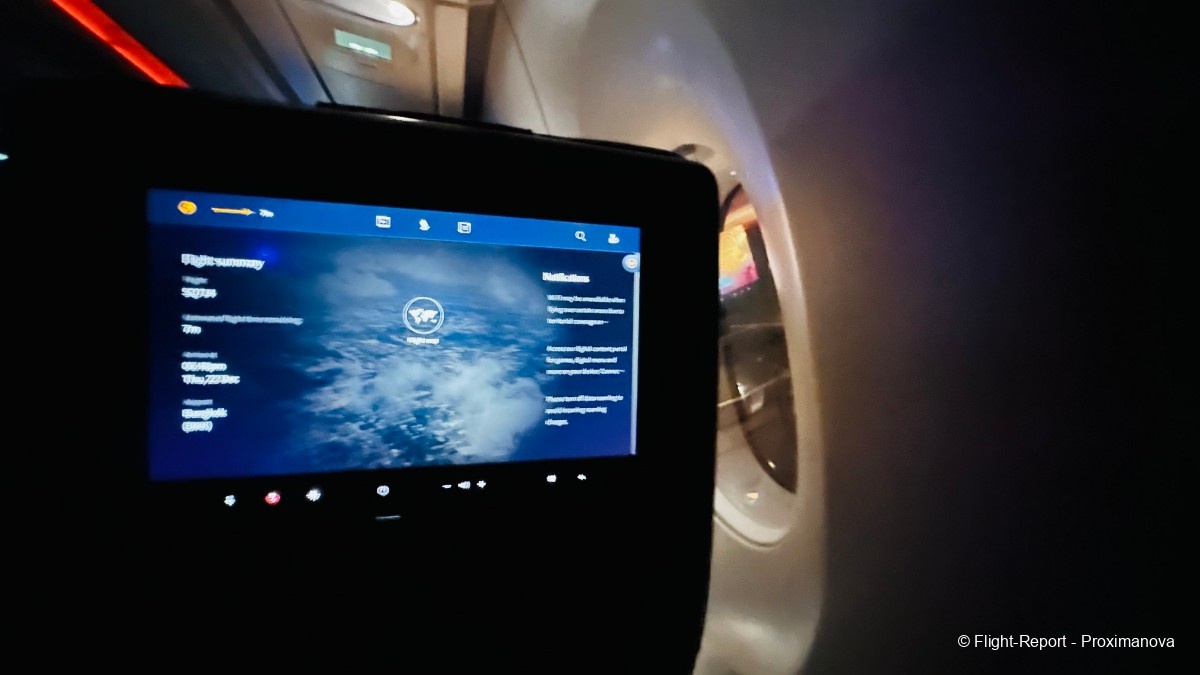
At a few minutes to seven, Sharjah skimmed over the Suvarnabumi runway.
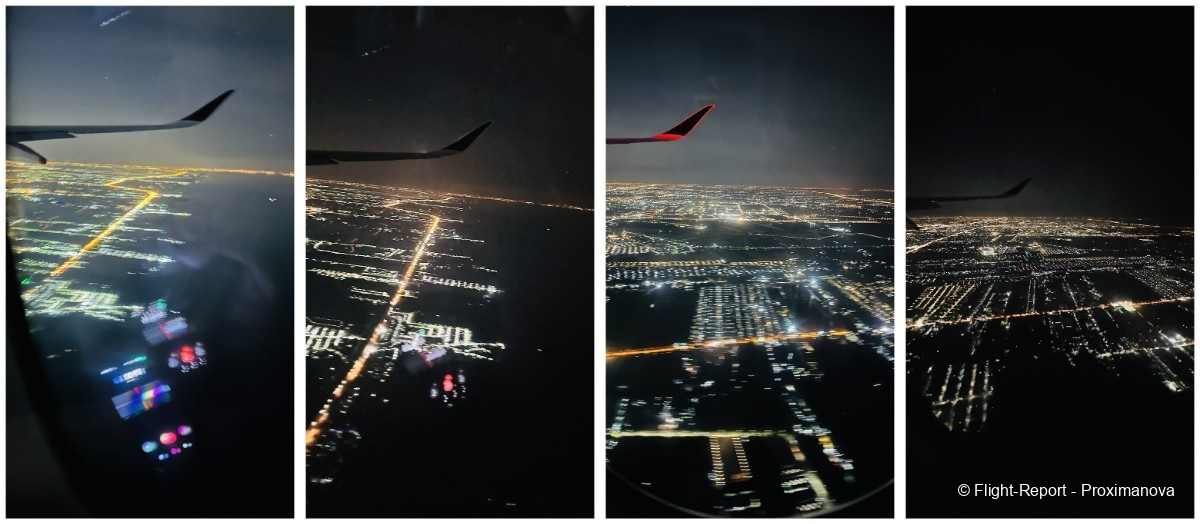
The highway lights and hoardings were simply surreal. This is why I love nighttime city landings so much!

At 6:55pm we landed past the rows and rows of never-to-fly-again Thai Airways aircraft lining up the taxiways, and I wish those ridiculous 777-200ERs were among them, but alas! the Royal Orchid carrier refuses to put them out of their misery, and continues to fly them across Asia with their horribly dated product.
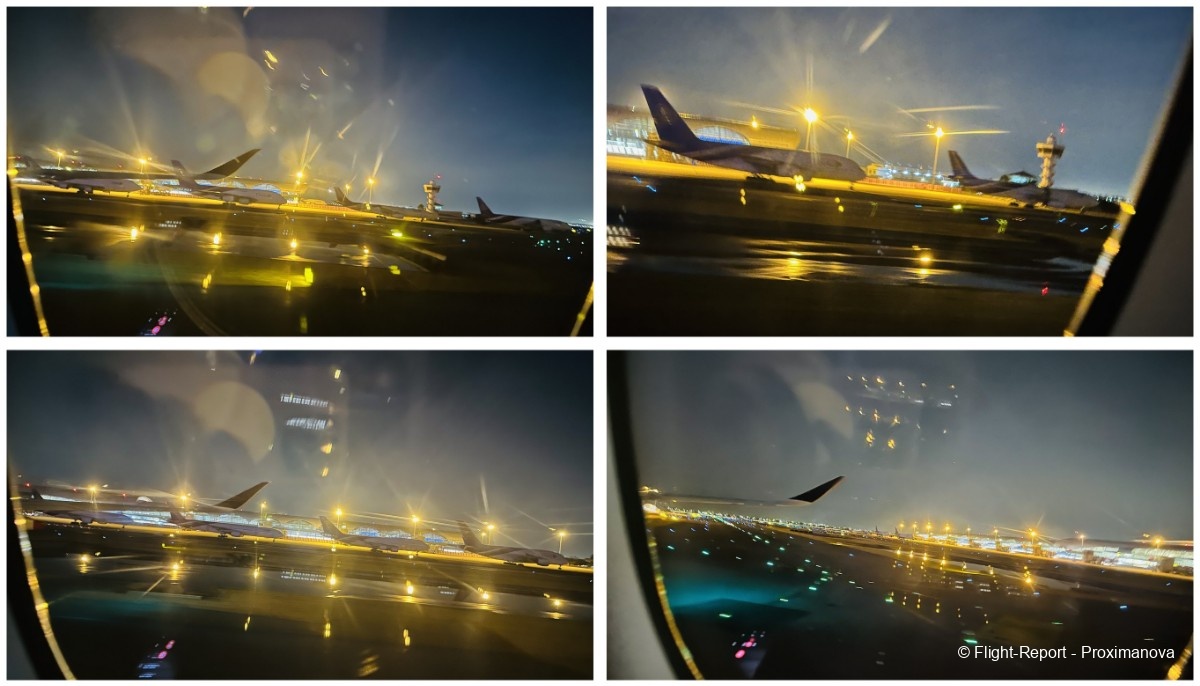
Here’s a superjumbo you’ll never, ever find at Changi Airport. The Qatar Airways A380 is a tell-tale sign of Bangkok, more than Doha, as there almost always seems to be a QR A380 whenever I visit BKK due to the heavy demand for the route. Then again, Singapore consistently gets A350s with the Qsuite — something that’s hard to guarantee otherwise with QR’s shape-shifting fleet — so no one’s complaining.
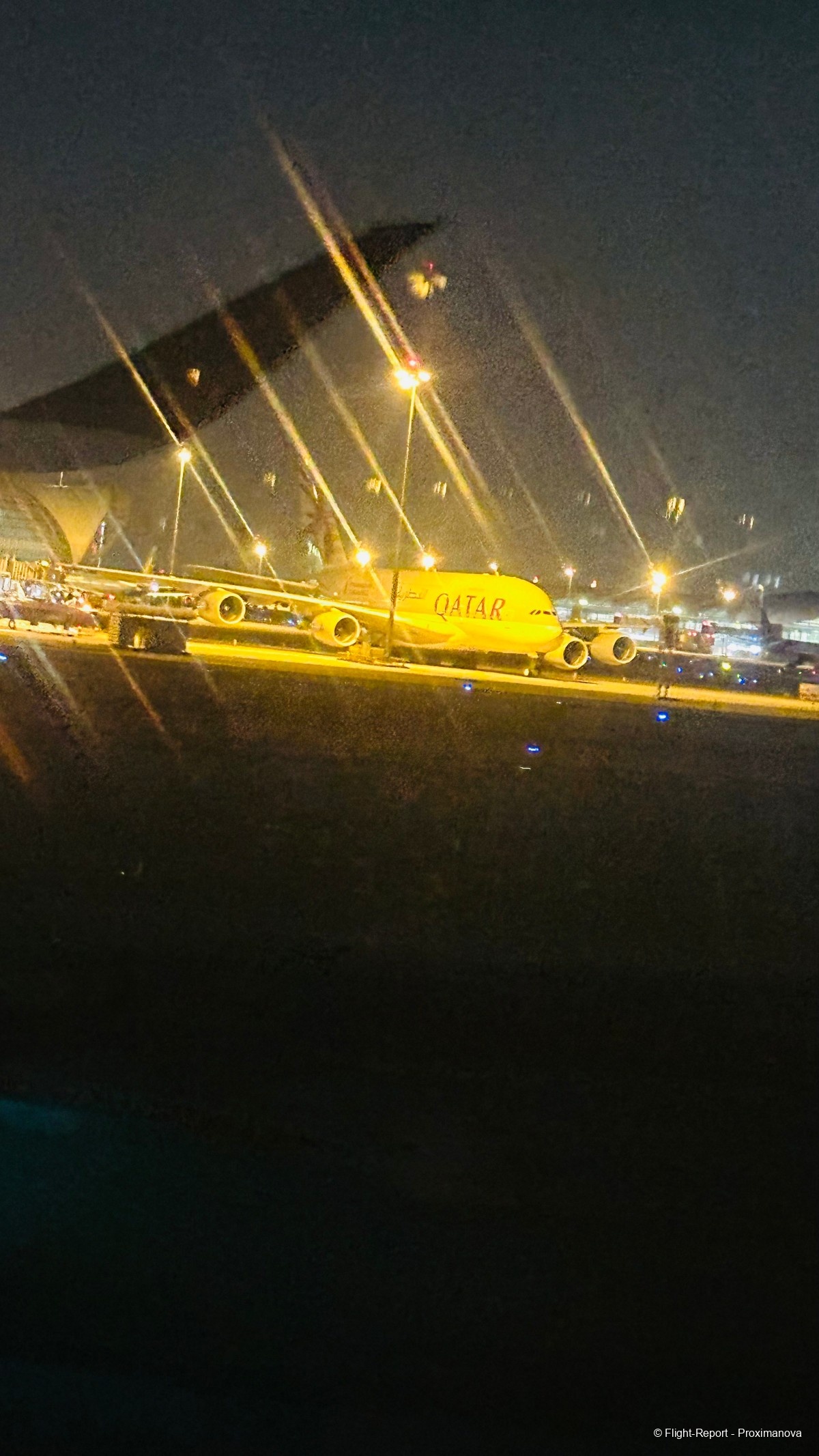
There were some more planes that you won’t find at Changi, and sometimes the reason is geopolitical limitations — as was the case for this El Al Israel Airlines 777-200ER (4X-ECB) which had landed three hours ago from Tel Aviv as LY81. To the right of this old bird was a Lufthansa A350 (D-AIXH) in the previous colours, and to her left a TG A330-300, an aircraft type I thought was gone for good until three of them (HS-TEN/TEO/TEP) were brought back on limited routes, especially Japanese ones.
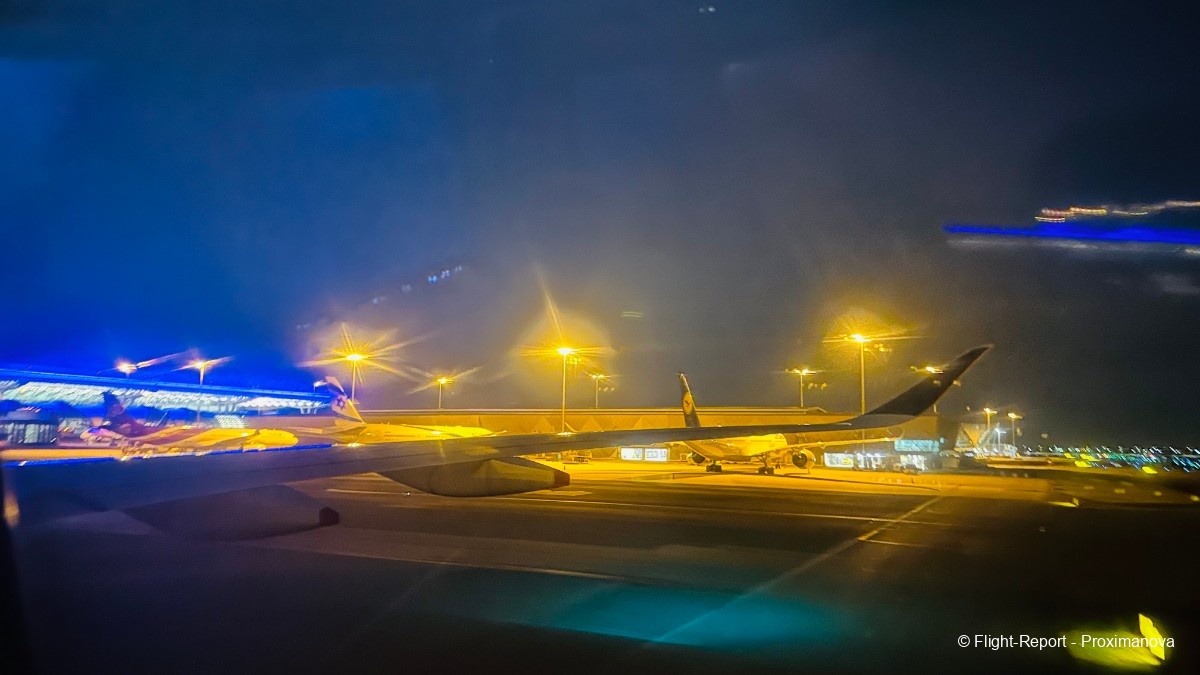
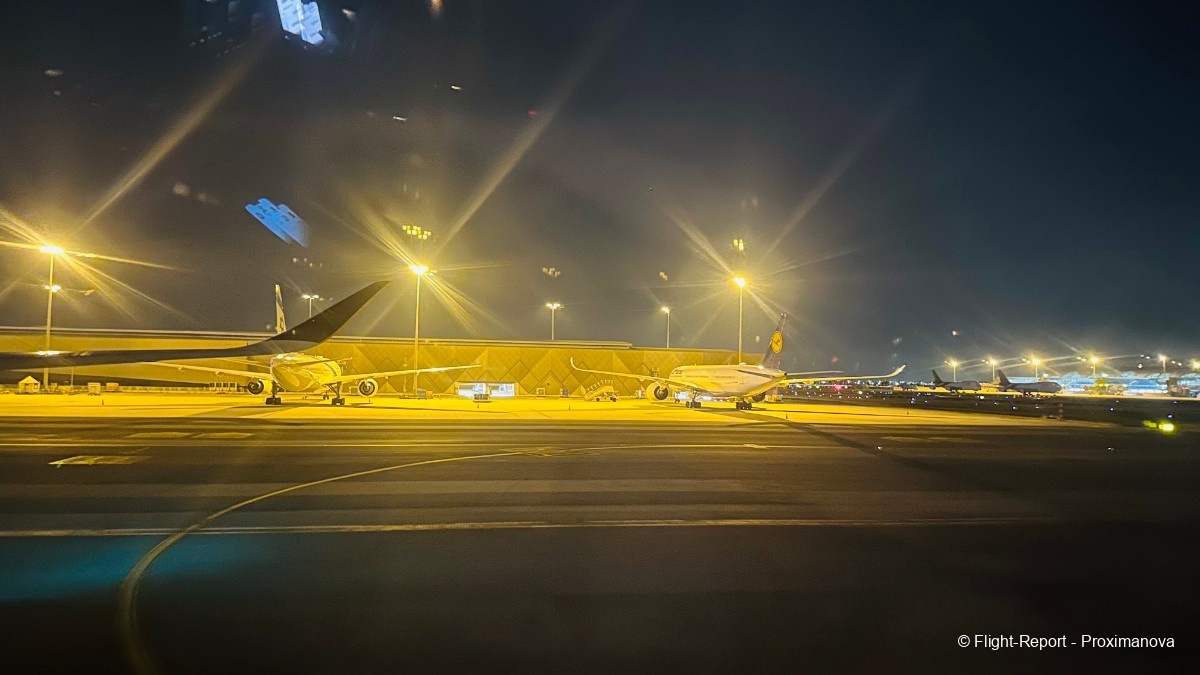
At this point AIS, Thailand’s largest mobile network operator, welcomed me with an SMS. Fat lot of good it did, since I had already bought a roaming pack from AIS’ parent company Singtel but could not get to activate it, forcing me to use BKK’s terrible Wi-Fi instead, which disconnects every hour.
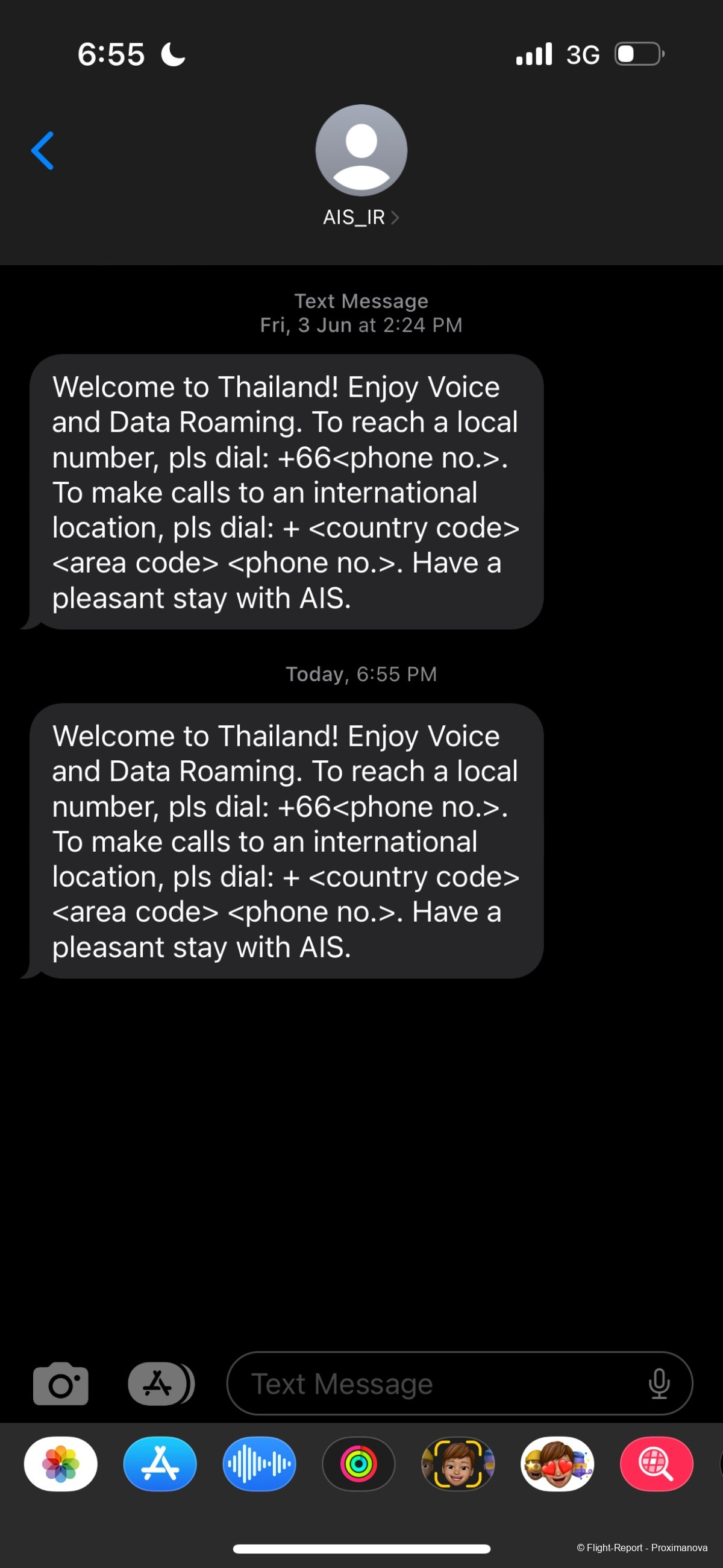
Now an A321 of Thai VietJetAir cruised past. Unlike other Thai budget carriers, which have their base at Don Mueang (DMK) to the north of the Thai capital, this one chose the megahub to the city’s east as its home.

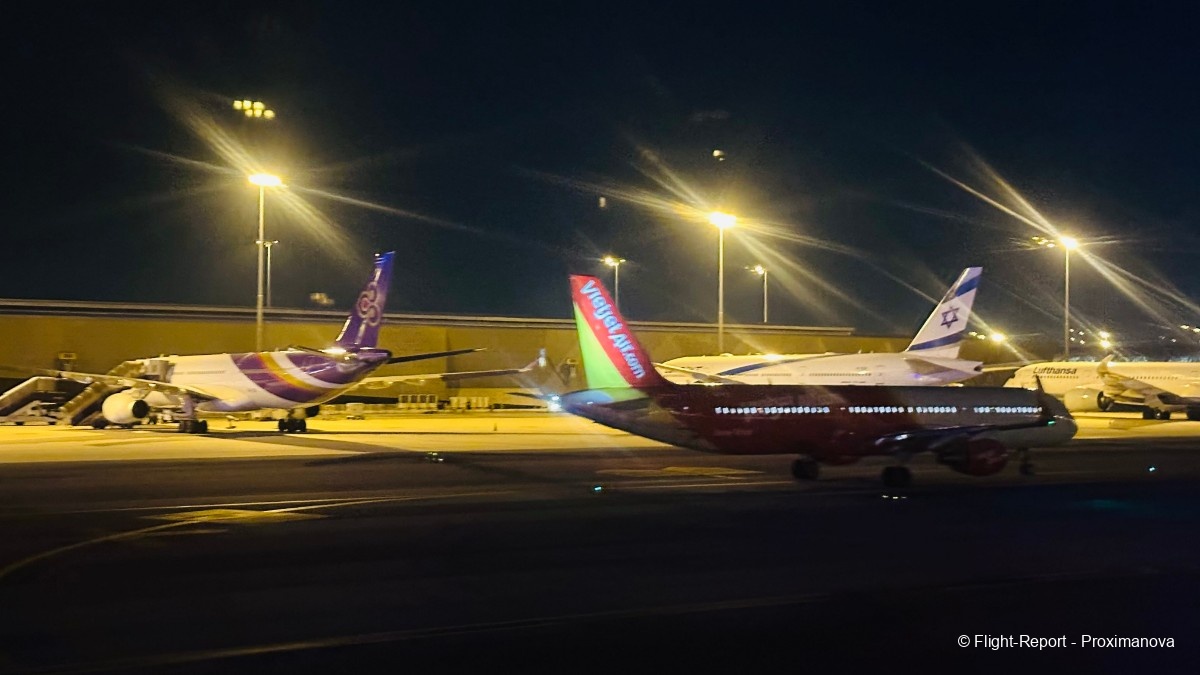
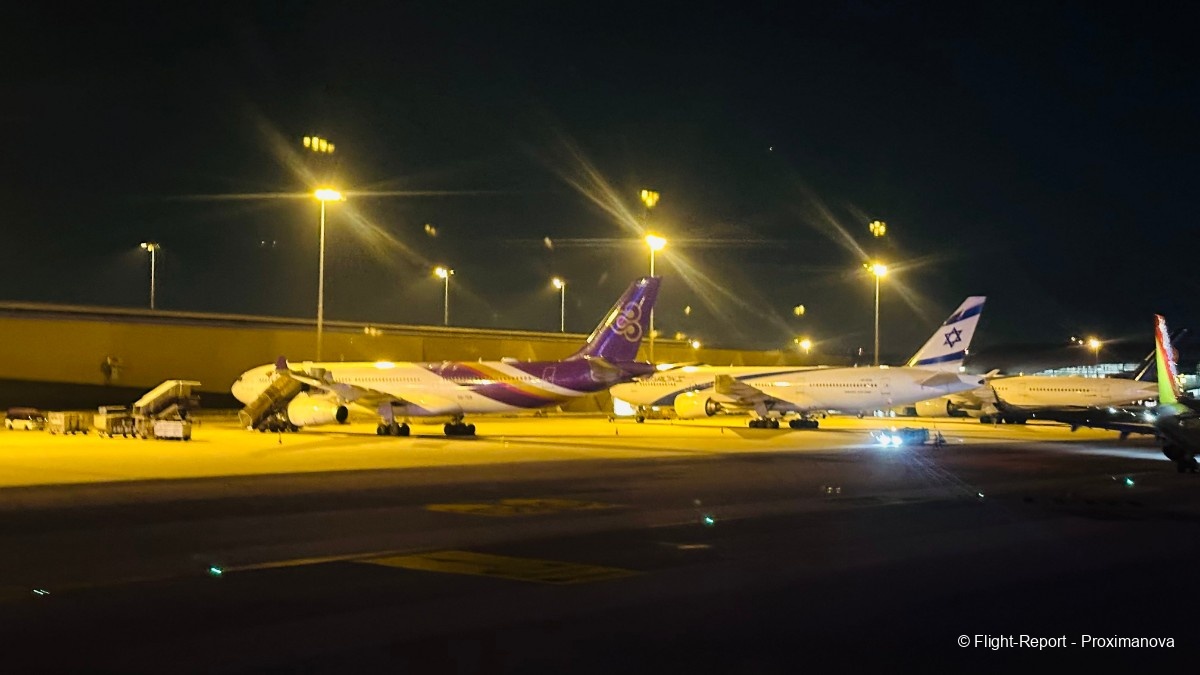
We pulled up next to HS-TWA, one of two Thai Airways 787-9s, the aircraft type which was supposed to operate my Chennai flight. Briefly I had an inkling that this might be the one, but instead she set off for Lahore, Pakistan, and I was worried that I might be downgraded to the horrible 777-200ER all over again as in June — especially since HS-TWB, the only other TG 787-9, was returning from Seoul/Incheon and might not have made it for our flight. Happily, this concern proved to be unfounded.
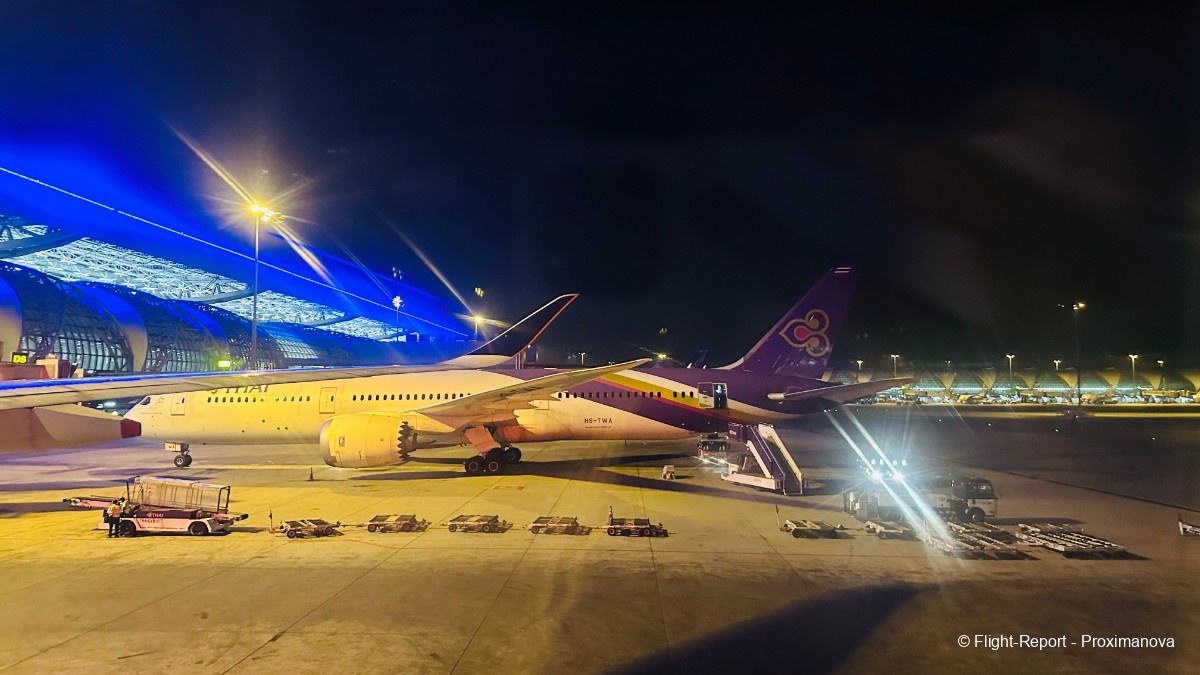
Below was a sampling of the sheer diversity at Suvarnabhumi: Myanmar Airways International, Myanmar National Airlines, Vietnam Airlines and Cambodia’s Sky Angkor Airlines (whose A321, XU-723, had landed as ZA678 from Phnom Penh) from the Indochina region, alongside El Al, Saudia, Royal Jordanian, Qatar, Etihad and Emirates from the Middle East. Of these, El Al and Oneworld carrier Royal Jordanian have BKK as their sole Southeast Asian destination.
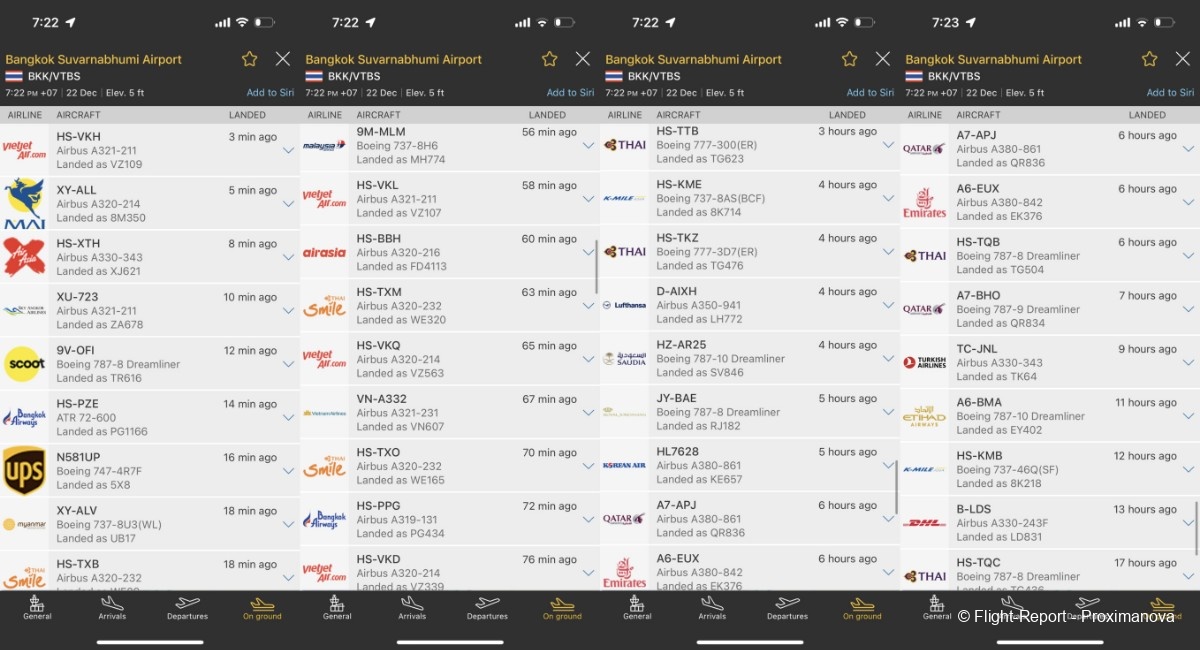
The passengers scrambled to the exits as the mood lighting turned white in the middle and purple at the sides for disembarkation.
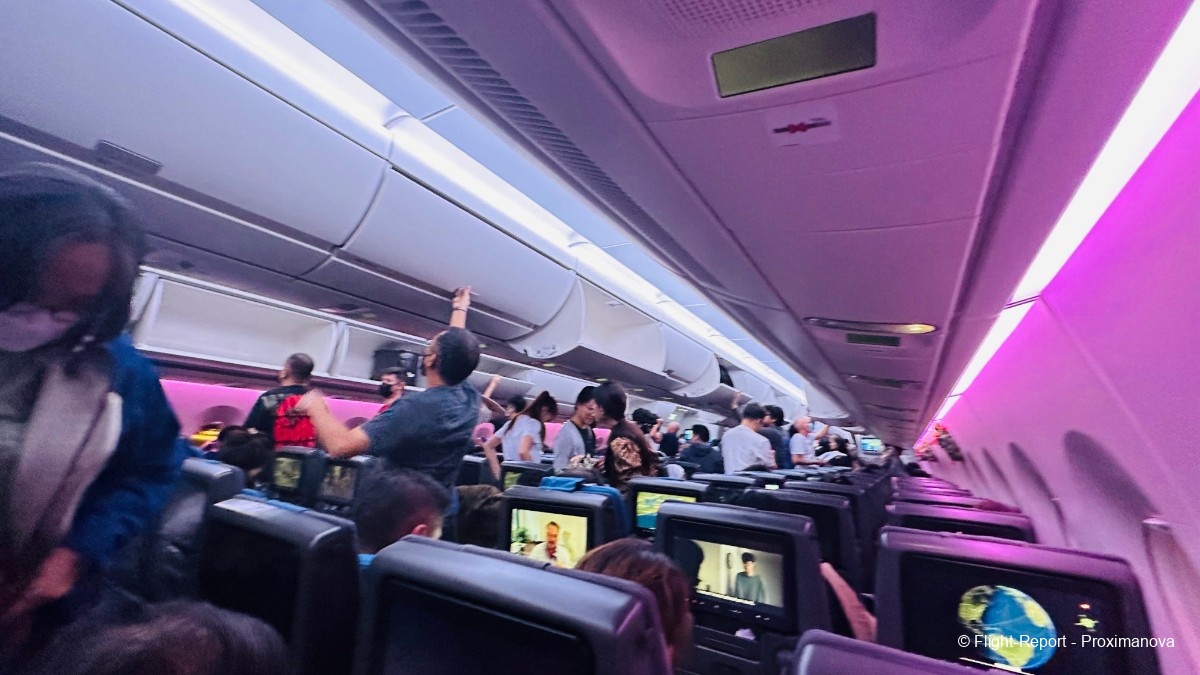
A (clearly Filipino) co-passenger had a funny-looking bag on their seat.
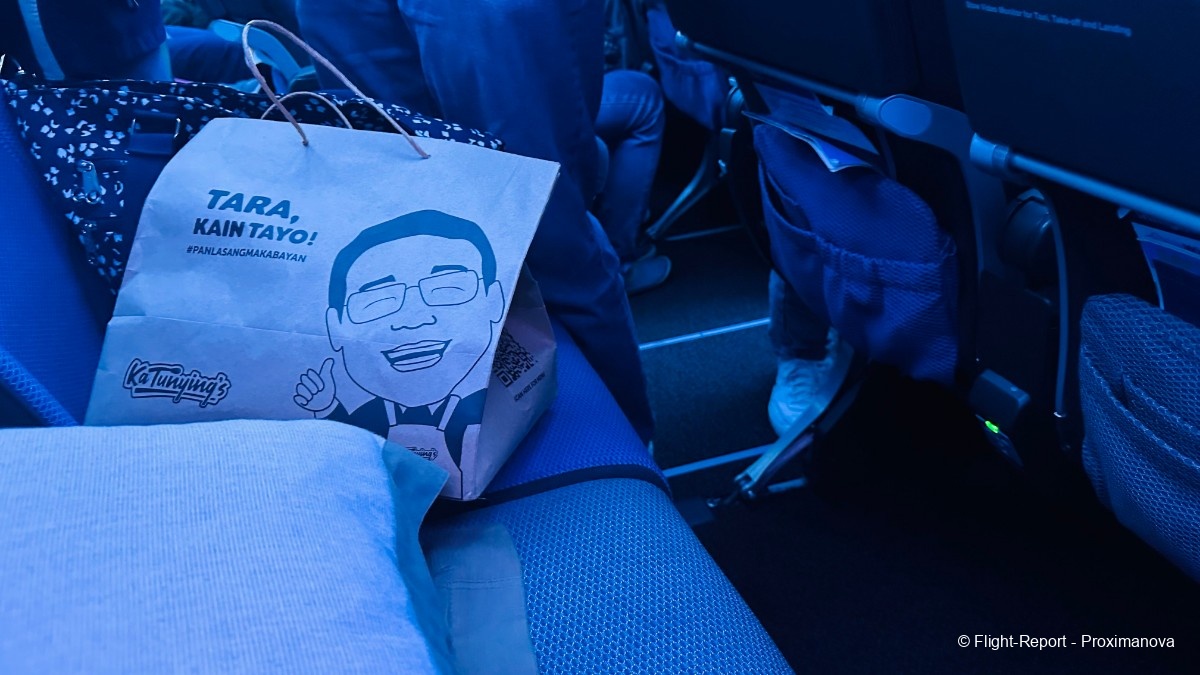
The KrisWorld screen showed a thank-you message…
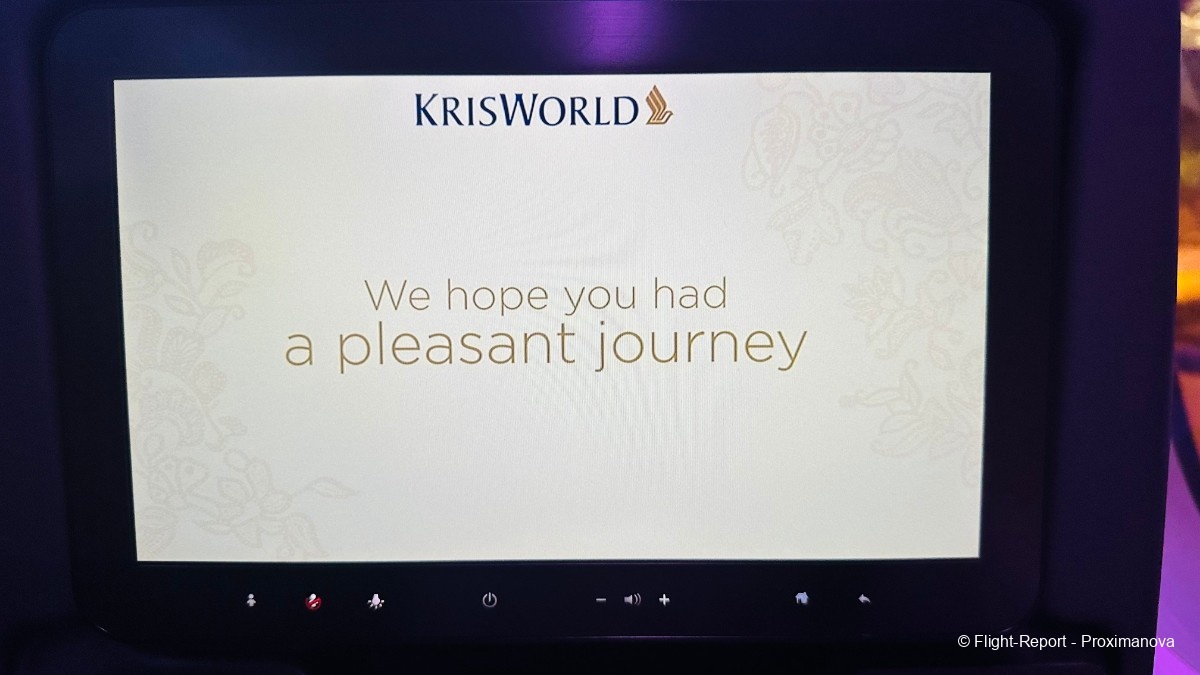
…before proceeding to a loading screen for the return flight to Changi.
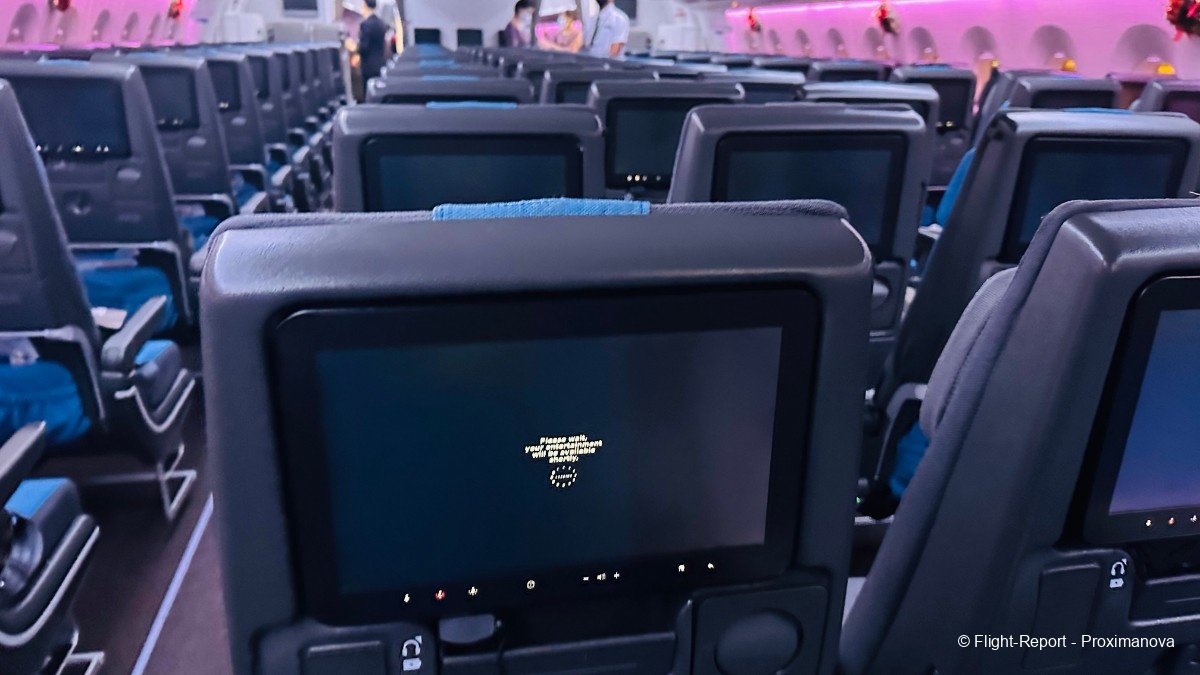

Finally I stepped off Sharjah, and proceeded towards a three-hour stay at Suvarnabhumi, which I feel is overrated in some ways and surprising in others — much like this flight itself.
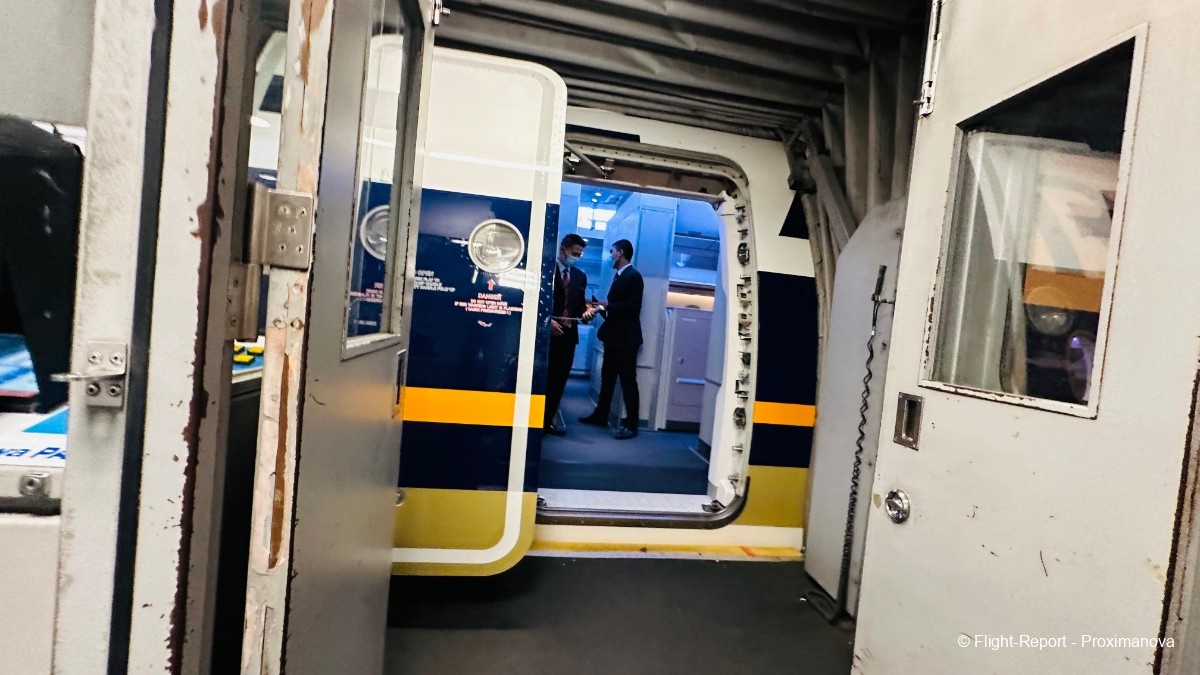
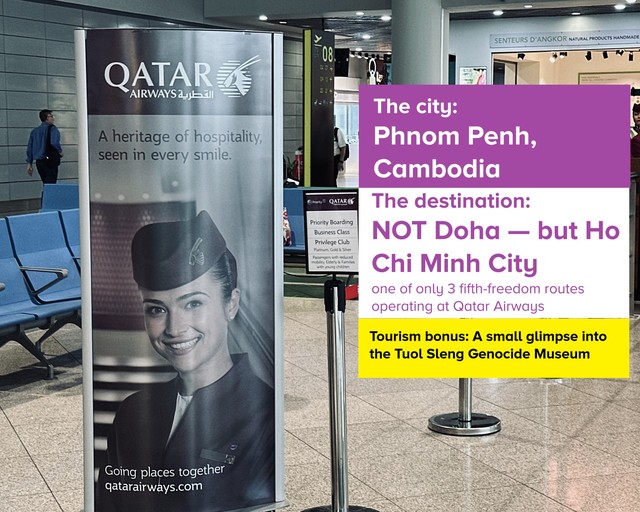
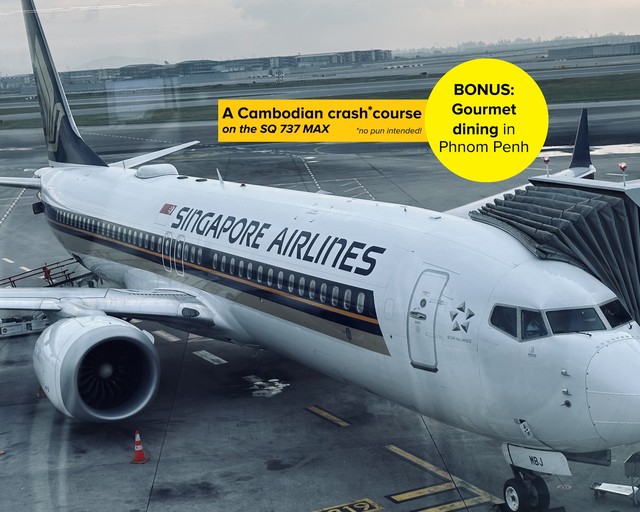

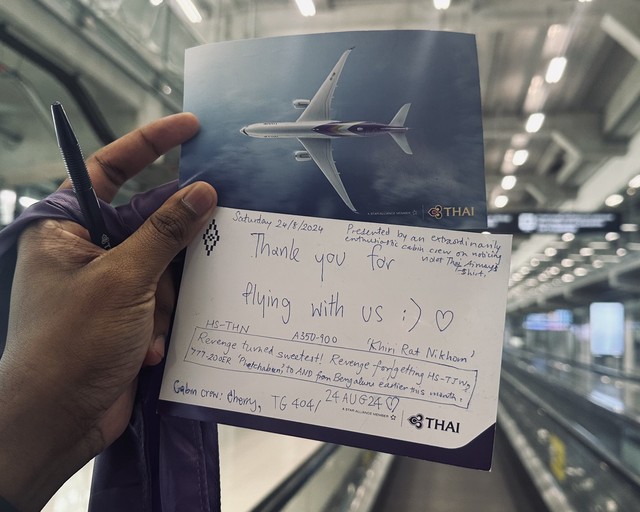
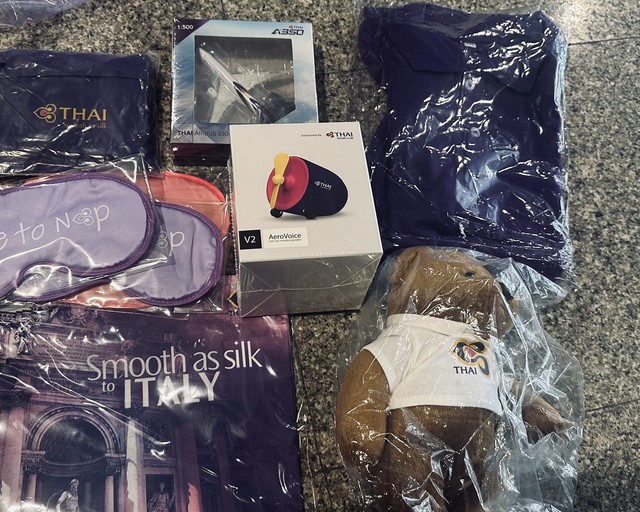
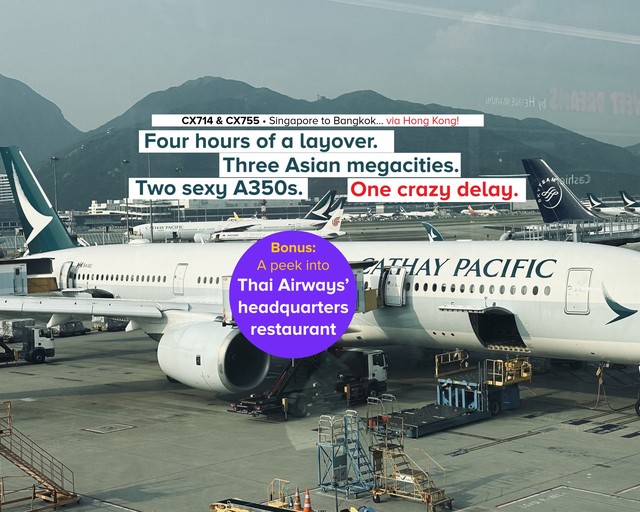

Thanks for the report,
Covid is over now (definitely I hope) but the golden age when Singapore Airlines had one of the best catering in Y is also over.
That's too bad